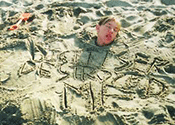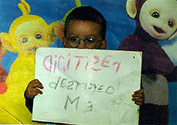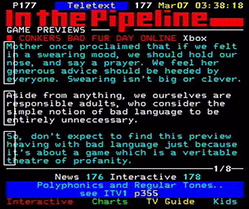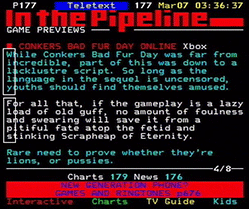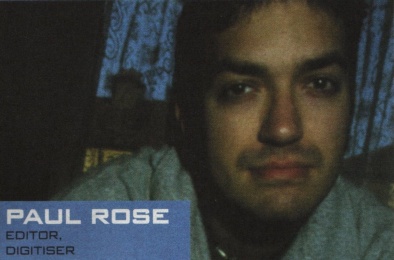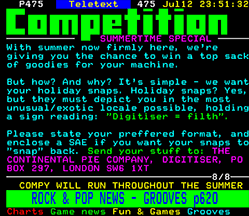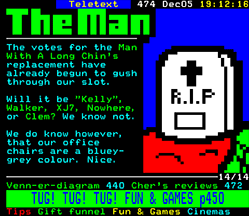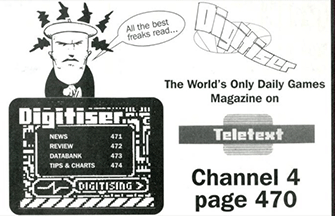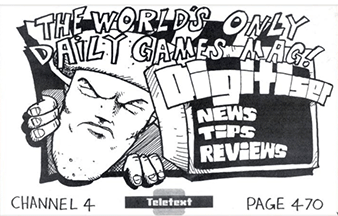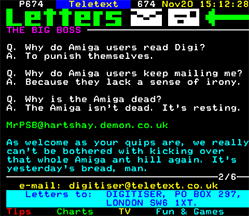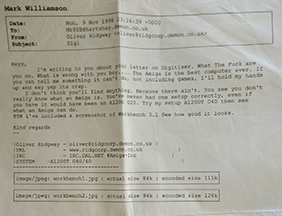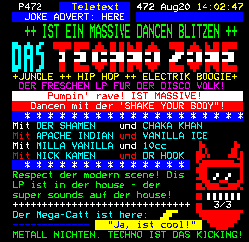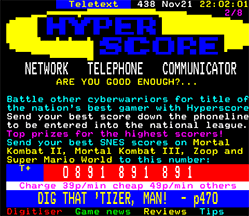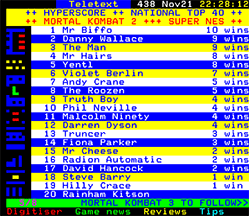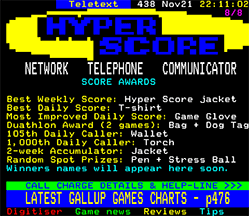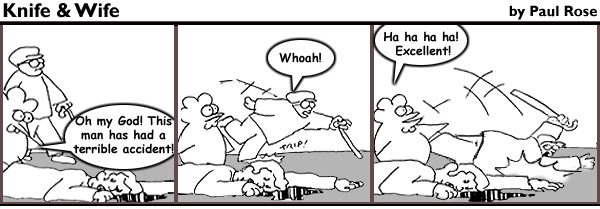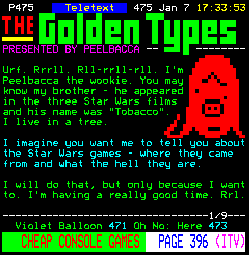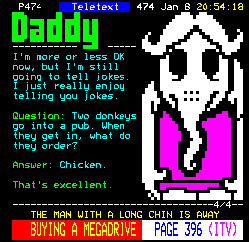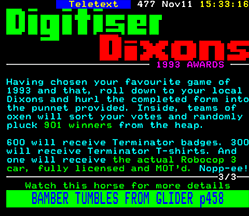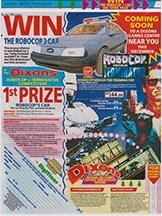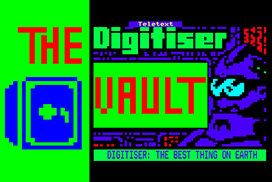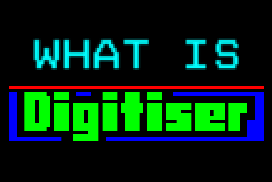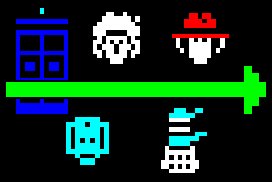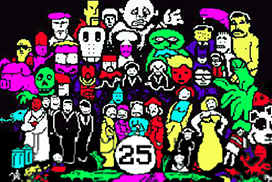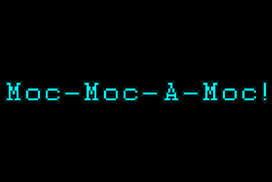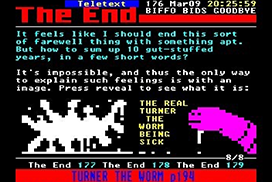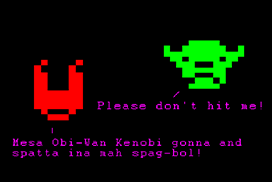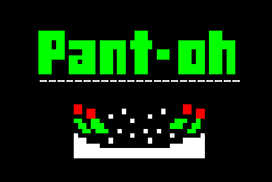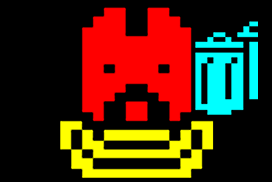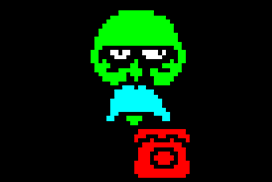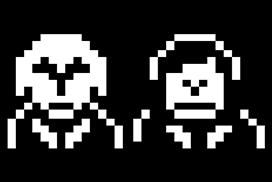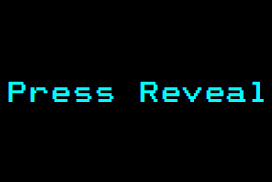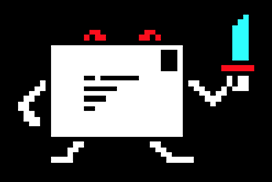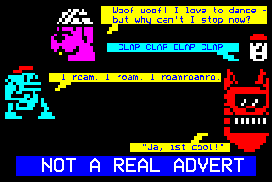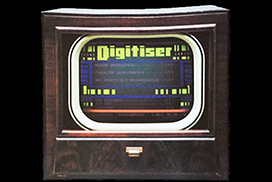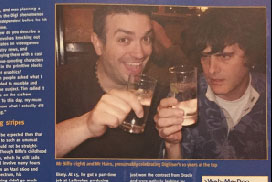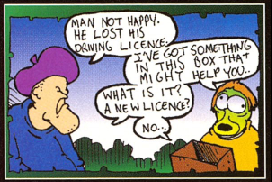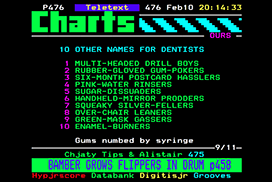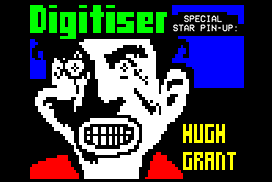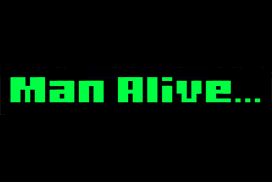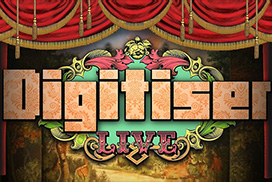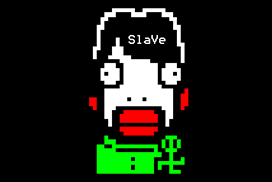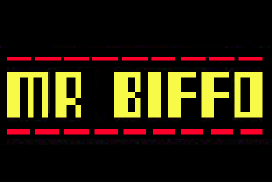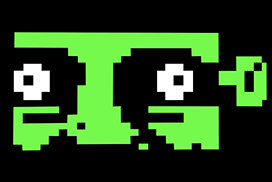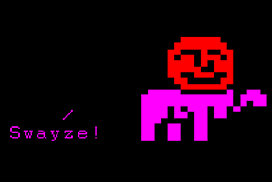
The history of Digitiser is as absurdly rich and varied as its output was just plain absurd. Being faced with such an enormous legacy can be quite overwhelming when trying to understand what went on and what made it so special, so taking an atomised approach - smashing it against a wall and seeing what the patterns and constellations look like (probably a cock) - can be a wise move.
Or we can just list out all the different aspects and important facts. Like a proper grown-up encyclopaedia would do. Yes. So here it is then - the complete A to Z of Digitiser, the most comprehensive and exhaustive Digi data "dump" available anywhere ever. The throbbing, bulbous guide which follows presents you with essential and not-so-essential fact-me-dos about The Nation's Most Read Games Magazine.
Better get started, then...

In one of the most controversial moments of their early years, Digi caused absolute uproar when they reviewed the all-cake, no-trousers cop-out that was Sonic 3, daring to give it the paltry score of 72%. At the time this was considered sacrilege, and Digi were branded as heretics by the magazines sitting intimately in Sega's lap and their small-minded minions. Thus started the almighty hate campaign involving the childish writers of such magazines, with a war raging on the Digi letters page between the brainwashed oafs and the pro-Digi lobby.
Matters escalated quickly, and the scars of these events were apparent for years, with the EMAP-published official Sega Magazine and Mean Machines Sega barely being able to go a single issue without continuing the stoning with words - right up until the very bitter end, in the case of MMS. For their part, Digi were highly amused by all of this, and were almost hurt on the rare occasions when they wouldn't get a mention in a new issue.
The feud culminated in Mr Biffo and Mr Hairs sending a fax to the editor of Mean Machines, explaining their position, and rather brilliantly finishing by calling him a "fishback".
But you know what? As usual, Digi were right, with their criticism of Sonic 3 hinging on it being 1) too short 2) too easy, and 72) too similar to previous outings, which "posterity" surely now supports.
The outrage over this notorious incident, and the lack of critical thinking on display by some readers, should serve as a warning from history. One which the world has seemed singularly incapable of heeding since the mid-2010s.
And: you can read all about the Digi/Mean Machines feud at great length!
The official number of readers that Digitiser enjoyed every week at its height, according to industry figures. Kind of makes a mockery of the circulations of their pulp-based "rivals" of the time, which even at the peak of sales were being read by no more than around 70,000 per month. Sadly, thanks to the so-called "Teletext Effect", many simply refused to believe this figure - notably the writers of Mean Machines Sega, who ridiculed the possibility of Digi having so many readers; and by Atari, who straight out told Teletext that such a high readership couldn't possibly be true. But of course: it was. A-ha-ha-ha! Prrrthhffftttthhh!

Digi gave away "cut out and keep" action figures in their early days for the best letters they received from viewers. These were photocopies of hand-drawn sketches of The Man With A Long Chin, intended to be cut around with scissors and a "foot" folded back to act as a stand - much in the same way as you might find on the back of a cereal box, or "elsewhere". Put together to capitalise on The Man's surprising early popularity, they were available from March 1993 until the team got bored of sending them.
Controversial Usenet newsgroup originally created for Digitiser fans to talk about the magazine and related issues.
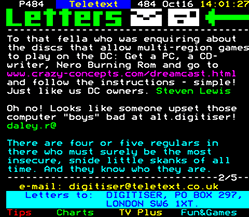
|
It may have been set up with discussion of Digi in mind, but it instead quickly mutated into a small clique of regulars that were strangely anti-Digi and actively hostile to outsiders (according to forum regular Mentski, they quickly got over spouting Digi catchphrases at each other, and so didn't tolerate this when newbies did it).
Consequently, alt.digitiser drew the ire of both Mr Biffo and Stuart Campbell, on-screen and in postings to the group. There was always a degree of tension, even suspicion, between the Digi team and the newsgroup posters, and each side was frequently antagonistic towards the other.
Unlike other Usenet hierarchies, it was relatively easy to create a newsgroup under the alt.* taxonomy – none of the tedious discussion with bureaucratic, anally-retentive gatekeepers was needed. While half the nerds of the internet were arguing with Biffo, Campbell and Digi fans in the uk.net.news.config group about the relative merits of a Digi newsgroup, and what it should be called, suddenly on 18 February 1998 some wag went and created alt.digitiser completely by surprise.
At this point the Digi crowd were entangled in an almighty flamewar with uk.net.news.config's committee – who were the ultimate arbiters of the creation and moderation of groups under the mainstream uk.* hierarchy (which Stuart Campbell even wrote an article for .Net magazine about). But while the pointless, petty, and poorly-spelt flame-postings raged, alt.digitiser came into being, and eventually the Digi side decided that there was no point continuing to argue with dogmatic saps, and so went and took up residence on the obscure alt.* side of Usenet.
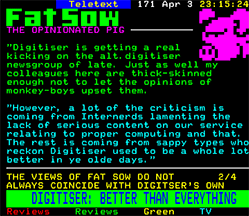
|
It being so easy to create alt.* groups meant that alt.digitiser soon splintered into alt.digitiser.snakes, where, for a time, much more on-topic Digi-posting took place. So much so that Biffo eventually declared that this was the officially-endorsed newsgroup, and directed Digi fans to head there rather than alt.digitiser.
Many of the denizens of alt.digitiser felt stung by this, despite the fact that they were totally unwelcoming of a) newbies and b) discussion of Digitiser. In fact, so little was new blood tolerated that every time Super Page 58 was mentioned on Digi, irate, incoherent emails were sent to this site demanding that the link to alt.digitiser be removed from its pages. Super Page 58 was being blamed for "sending" newbies to alt.digitiser.
Things settled down in the end, once it had been largely accepted that alt.digitiser was its own thing and no longer related to Digi, and many of the regulars were supportive during the Digigate saga.
But the newsgroup was renowned for being an insular clique full of in-jokes, and pretty much left alone by most fans as a result.
A number of running-jokes were built-up by the regulars over the years, first and foremost the fact that alt.digitiser 'belonged' to Mentski. Any transgressions from posters would be responded to with replies of either "Get out my newsgroup!" by Mentski himself, or "Get out of Mentski's newsgroup!" by others.
There was also the semi-regular assertion following a better quality thread than usual that "Perhaps this will signal the end of alt.digitiser's shit phase".
The joke being, of course, that alt.digitiser only ever had a shit phase.
Offshoot of the alt.digitiser newsgroup, named after the popular Digitiser characters. More related to Digi in its discussion topics, and therefore declared by Mr Biffo to be the 'official' Digi newsgroup.
Pitiful souls that plagued Digitiser throughout its life, even instigating campaigns to persuade Teletext bosses to sack the writers on numerous occasions.
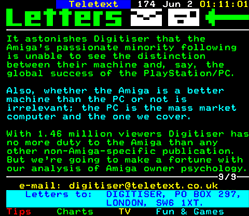
|
The bad blood between Digi and Amiga owners started on literally day one of the magazine's life, with the announcement of their planned gaming coverage conspicuously failing to mention the system. Only a few hours into its life, and Digitiser had already outraged an army of Amiga zealots, who rang into Teletext in their droves to complain.
While this almighty shock wasn't enough to convince Digi that the Amiga had a long-term future, it did convince them to run Amiga reviews - if only to stem the flow of vitriol aimed in their direction. But this didn't mean they had to like it, however, and they never missed an opportunity to poke fun at the machine, or its gloriously self-important fans.
If anything, the treatment that the incandescent Amiga fans meted out in those opening days of Digi's life served merely to harden the team's views toward it, and made them even more determined to be contrary and rude about the format.
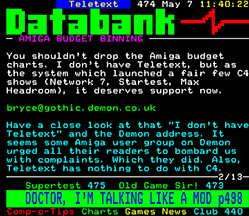
|
Not even the advent of Babylon 5 would change that. In fact, rather than the TV space drama's use of modified A1200s to produce its on-screen CGI being the proof that the format was alive and kicking, as its fans were so convinced it was, this simply underlined how sad and out of touch they actually were. Not that they could ever see it.
Never let it be said that Amiga owners aren't passionate, though – Digi continued to receive negative letters from fans unable to let go for the rest of the magazine's life, even printing one such bitter missive in its final Teletext edition.
The long-running war of words with die-hard Amiga dullards is still one of the aspects that people remember most about Digi to this day.
Digi loved playing pranks, as the Ring-sir! calls have shown, so it should be no surprise that they were avowed observers of April Fool's Day. The April 1st edition each year came complete with many a funneee inside, masquerading as a legitimate news/review Jeremy.
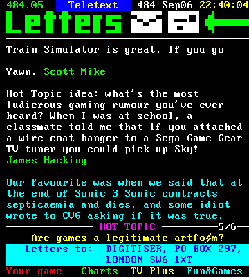
|
The very first April fool came in 1993, with Digi announcing to credulous gasps from EMAP-reading idiots that Sonic was to die of septicaemia in the upcoming Sonic 3. The prank was readily believed by one gullible sap who wrote to CVG magazine asking if it was true.
Back in 1994, a prank review sashayed about on the catwalks of Digi. This game was called... "Mario Fighters". Apparently Nintendo had given birth to a one-on-one beat 'em up much in the style of the Mortal Kombat series with digitised graphics, featuring their cholesterol-filled Italian plumber and all of his jolly friends. With whom he would commit assault occasioning actual bodily harm.
The review sang the game's praises, but ended up with an overall score of around 49%. Perhaps this was to prevent the hordes of fools making a nuisance of themselves, wanting to know more about it. Or if they had no irony gland (as many of Digi's correspondents seemed to) self-righteously pointing out that Nintendo wouldn't release such a visceral, parent-cussing fist-me-do. They even included a full-page graphic of the brutal on-screen action, with a "buff" Mario engaged in bloody fisticuffs.
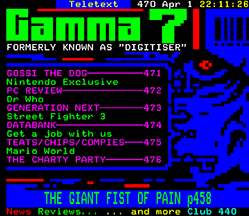
|
1996's April foolishness was more worrying for Digitiser devotees. At the height of Digi's relaunch-fever, during which they constantly stated how they regretted giving themselves the name Digitiser - even running a Hot Topic on what their new name should be - on 1 April that year, we awoke to discover that the name of the games mag on page 470 was now "Gamma 7". After a brief spell of hyperventilation all round, a quick glance at the date left fans considerably relieved. Which is just as well, because Gamma 7: is an awful name.
In 1997, a time when the masochistic British public waited for the constantly-delayed UK arrival of the N64 (and when it was becoming clear the extent of Sega's misery), Digi concocted a masterstoke of misinformation. The April fool this year saw the news page run with a story about Nintendo buying the rights to Sega's dormant mascot, Sonic The Hedgehog. They revealed how the Big N planned to produce a game starring their own mascot, Mario, and their newly-acquired hedgehog with "attitude".
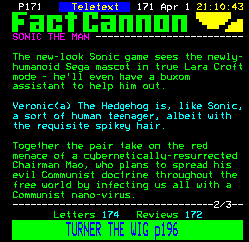
|
This game was to be called "Sonic & Mario", and would be introduced in the end sequence of Mario 64, which was yet to be officially available on these shores. Needless to say this kicked up quite a stink, with many an idiot messing-up in letters about it to Digi. The Sega zealots were predictably distressed, but the Nintendo die-hards weren't that pleased at being associated with Sonic either, thus upsetting two whole factions of mine's-better-than-yours irritants. Ha ha ha! That's real funny.
The fun in 1998 had in involved Digi spouting some straight-faced rubbish about the next Sonic game being a Tomb Raider-style 3D affair, with Sonic himself resembling a spiky-haired human "yoof", doing battle with a cybernetically-resurrected Chairman Mao, who planned to infect the world with a communist nano-virus - oh man!
The same edition also included a spoof review of a Radiohead game: "Radiohead: The Creep", which they declared to be excellent, and the definitive example of a game based on a modern prog-rock band. No doubt they got some trusting idiot writing in asking when it was "out".
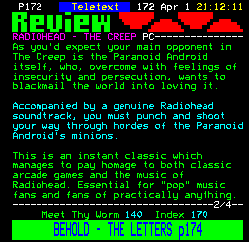
|
For the final Digi April fool of the 20th Century, in 1999 there were not only the obligatory news lies and stupid, made-up quotes from people on The Quote Boat, but once again there stood a review of a game which could only exist in the fevered minds of Digi. This game was entitled "Super Mario Disco". It was given birth as a by-product of the latest gaming craze to light-up the socks of our slightly mad Japanese cousins - the dance simulator.
Taking its cue from games such as Parrappa The Rapper and Dance Dance Revolution, you took control of Mario, replete with massive "kinky" afro, helping him to shake his money-maker to the game's four-to-the-floor beats. This would then hopefully impress the panel of judges that were presiding over the whole sordid affair, including one named "Mr Backward Love". Digi also straight-facedly proclaimed that a follow-up, "Yoshi's Ballroom Island", would be released in December. Unsurprisingly, this never materialised.
This was the end of the April fool tradition on Teletext, as in 2000 and 2001 1 April fell on a Saturday and Sunday respectively, with the killjoys in management refusing to allow Mr Biffo to do the fool-o - for some spurious reason about weekends or something.
Future-published multi-format magazine that ran between 1998 and 2000. Arcade was pitched as a more 'fun' version of its stablemate Edge, and was well-liked for managing to be authoritative without being pompous.

|
The fifth issue, published in April 1999, included a feature on the 50 most influential people in the games business. Dubbed 'Power Players', the article put Digitiser's Mr Biffo at number 12 in the list – 36 places above Sir Clive Sinclair, 20 above Yuji Naka, and two places above Peter Molyneux. David Braben wasn't on the list (he was probably doing a poo).
12 PAUL ROSE ("MR BIFFO")
Career highlights: The Snakes; Morse and Lewis.
What's the big deal? As the nation's only daily games mag, Digi is always first to the punch with both hot rumours and hard news. Its viewing figures of 1.5 million give it more readers than every print games mag in the country put together, yet the industry still regards it as "cultish". This approach allows Digi's irreverent and disrespectful style free rein, since having no industry friends or advertisers in the first place means it has none to lose with hard-hitting stories and reviews. It's all presented in a densely comic style, which is at once the source of its popularity and the thing that deters those would-be readers incapable of grasping even the sledgehammer sarcasm presented by characters like "Insincere Dave".
Most likely to say: "We just hate everybody equally."
Least likely to say: "Here's a review of an early production copy we were sent by the publisher."
Currently working on: Tomorrow's issue.
Future prospects: Recently commissioned to write a movie script for Sky, Rose may eventually find the demands of coming up with Digi six days a week, 52 weeks a year, too much of a drain.
For the first few years of their life, the Digi team regularly took time out of the office to go on officially-sanctioned trips to London's Trocadero to review the arcade games. They even managed to convince Teletext bosses to pay for this out of petty cash.
Arcade reviews would be published at weekends, and were hosted by the sinister Dr Derek Doctors, until the plug was pulled on him following a complaint from a mother about his disturbing blathering. DJ Ice Hockey took over the reins until the section was discontinued in 1996.
This being Digitiser, the fact that they had a legitimate reason to be out of the office didn't go unabused. Living in Harrow, Mr Biffo's journeys to Teletext HQ in Fulham were lengthy, and before the switch to writing Digi freelance from home, he'd often sneak out of work hours early via the fire escape.
If later challenged about his whereabouts, he'd reply that he was out doing arcade reviews. Or "having a poo". Amazingly, this was usually the end of the matter.
TV globetrotting challenge hosted by Monty Python member Michael Palin. The series began with Palin seeking odds on the success of his adventure from bookmakers Ladbrokes. The young Mr Biffo was a graphic artist for the betting company at the time, and created a teletext-style animation of the famous Python foot descending from the top of the screen and crushing the odds being displayed. Broadcast in 1989 – four years ahead of Digitiser – this was the first thing Biffo-created that was shown on national TV.
Many large employers like to give their employees an extra little something around Christmas to say thank you for the work they've done over the last year. Often this takes the form of a box of chocolates, money towards a team meal, or possibly even an actual financial bonus (I know - apparently it does happen). But not Teletext Ltd. - instead of any of these lovely gestures, in December 1994 staff received a print pamphlet featuring some of the artwork created for the service that year. Staff were reportedly pretty nonplussed by this, but it gives us a sort of visual time capsule of the work being done by Mr Biffo (in particular, the Digitiser star pin-up of Bianca from EastEnders) and his fellow graphic artists at the time. Thanks to his former colleague Sara Scott-Rivers, we have part of this parade of straight-from-the-office-printer loveliness. Some of Sara's other work showcased elsewhere in the booklet can be found amidst the interview she gave to the TeletextR podcast.
Towards the end of 1993 it was becoming clear that Digi were disillusioned with the adventures of The Man With A Long Chin. In order to prevent themselves from dying of boredom, they decided to assassinate The Man on the 30th anniversary of the very same thing happening to JFK. The ramifications of this act were interesting to say the least, as a rigged election took place to find his replacement - ultimately deciding on bearded DJ Pat Walker. There followed a great deal of intrigue regarding Walker's identity, with the truth shaking the nation to its core. Possibly. More details of this clandestine conspiracy can be found in the entries for The Man and Pat Walker in the characters A-Z guide.

Babylon 5, Babylon 5, Babylon 5, Babylon5. The number one piece of ordnance used by those most stubborn of the world's creatures: the Amiga owners, in their tedious assaults on Digi. Whenever one of these pitiful people wrote in, '90s sci-fi drama Babylon 5 and its computer graphics, which were generated by modified Amigas, would be the excuse they gave for the machine still being relevant and having a future. Which it wasn't, and which it didn't.
Even in 1994, when the show debuted, the Amiga was stone dead, and no amount of use on a TV serial could bring it back into mass market contention.
Oh yes, and don't forget about Babylon 5!
Hip hop-style pastime enjoyed by Digitiser favourites The Snakes and various reveal-o-characters over the years. Amused Mr Biffo enough to have one of the EastEnders characters beatbox in the episode that he wrote.
Host of CITV's Bad Influence video games show and one of the most prominent faces of gaming in the 1990s. Berlin was one of Digi's biggest fans, stumbling across it at some point in 1993, and demanding to meet the mysterious writers when realising they were all attending the same ECTS trade show later that year.

|
She became great friends with Biffo and Hairs, and used her high-profile position and influence to champion the Digi cause several times, getting the team invited on press trips that they would otherwise have been overlooked for.
Following one of these, a trip to Lillehammer promoting US Gold's Winter Olympics game, they decided that she should contribute a regular weekend column for Digi. This began in mid-January 1994, writing every week until May 1996, when she began contributing one column every four weeks as part of the Panel 4 feature. She continued to do so until the feature was scrapped as part of the Digigate atrocity brought on by Teletext management.
Berlin remains friends with Biffo and Hairs, and continues to support the Digi cause, appearing as a guest and panellist at Digifest 2016. As part of Digi's 25th anniversary celebrations, she revived her column as a one-off in 2018 for the week of teletext-style Digi Mr Biffo was running on Digitiser2000.
Digitiser were accused of being biased both towards and against every significant piece of gaming hardware at one time or another throughout their life. Sometimes they would be lambasted by readers for their supposed bias for and against every major company, at the same time, on the same letters page.
It should come as no surprise, then, that over the years a large number of idiots from all factions of the games-world have unfoundedly accused Digi of being biased against their machine. This famously started when several descenting Sega owners had noted that certain high-profile Sega games - not least of all Sonic 3 (see 72% for the full story) - had received mediocre reviews, while various Nintendo "releases" were deemed to be "good". With this startling piece of evidence, the ignorant people wrote in their droves. They were horrified that this could ever happen, accusing Digi of secretly loving-up Nintendo and sitting too closely to its thighs. Yes. The truth was, of course, that the standard of Sega's games at that time was just not as high as what was available for the SNES - not least by the time of the Mega CD and 32X debacles.
Demonstrating that brain-wrong idiots reside in both camps, this situation was later reversed in the late '90s, with the diehard Nintendo militia taking exception to the news that Nintendo really did hate them. Look: the delay of the N64's UK release, PAL conversion inconsistencies, cart prices, the number of games available, the whole GameCube mess-up, etc. "Surely Nintendo wouldn't mess-up like this? It must be Digitiser! Yes: they keep saying how good PlayStation games are, and telling lies about Nintendo. They're biased!" And so, the fun began anew. The only good things to come out of it were all the most excellent replies and put-downs from Digi to such letters. It almost made it tolerable, really. Almost.
As if that weren't bad enough, at the very same time the PlayStation owners were also writing in feeling hard done by, saying, yes: that Digi were biased against Sony. Sigh... One of the most significant instalments since the Sonic 3 furore came with the response to Digi's fair and frank review of Zelda 64, wherein the fact that they stated that it wasn't the best game ever, as had been touted, prompted a whole host of Mormons (morons) to pick up the Torch of Accusation, and hurl it at the Grassy Knoll of Self-Righteousness. Or something.
But that wasn't the end of it - even into the PS2/Xbox era, misguided fanboys were frothing at the perceived unfairness of Digi's treatment of their machines. Yes, it's true: the original Xbox actually had die-hard fans!
In classic Digitiser style, their go-to response at times like this was the immortal line "We hate everyone equally, man!"
Co-creator, long-time writer, editor, creative driving force - and since 2018, owner - of Digitiser, Mr Biffo is the all-conquering alter ego of Paul Rose.

|
The famous Mr Biffo name comes from an in-joke between Rose and fellow Digi co-creator Tim 'Mr Hairs' Moore. The two writers went through a phase during the magazine's early days of referring to things that were good as being "Biffo The Bear" or "Korky The Cat", after characters that featured in UK comics The Beano and The Dandy.
Biffo joined Teletext - the service that broadcast Digitiser - in September 1992, while it was preparing for its upcoming launch on New Year's Day 1993, following the closure of the old Oracle service.
The still only 21-year-old Biffo had gained a reputation for being a teletext-graphics genius from a stint at Ladbrokes Racing operating their similar in-house service, and from creating scoreboard animations at Wembley Stadium. He was approached directly by Teletext bosses to come onboard as a graphic designer, helping to create the new service's look and feel, and even managed to score the only permanent contract the company was offering thanks to inadvertently playing hardball during his interview.
Biffo set about creating a vast array of graphics that would come to be used on Teletext for years, including its logo and all kinds of illustrations. He was very much employed as a graphic artist alone, with no journalistic responsibilities.
This changed after Teletext management asked for suggestions for new editorial sections, and a fateful meeting with Tim Moore, who was then responsible for writing the single page of games coverage as part of the teens magazine.
After receiving a non-committal shrug from Moore at his suggestion that Teletext should have an entire games section, not just one page, Biffo went about writing a full proposal for such a magazine and submitting it to management. To his surprise, Teletext editor John Holme was impressed, and wanted to know more.
A passionate and knowledgeable games fan, Biffo explained to Holme how popular the new games consoles were, how exciting the current scene was, and - crucially – how much ad revenue Teletext could make from a full-blown games magazine.
Holme was sold, and the new games section was given the go-ahead. "And you can write it", Biffo was told – a development he hadn't seen coming, still being employed exclusively as a graphic artist at that time.
As it turned out, Biffo wouldn't be writing the section solo – he was to join Tim Moore, with the two concentrating fully on what was to become Digitiser.
After some initial misgivings, the two quickly struck up a rapport, and fed off each other's sense of humour. The result was Digitiser – and its unique humour was very much a combination of Biffo and Hairs' senses of fun and mischief.
Following the controversial firing of Tim Moore (now known as Mr Hairs) in 1996, Biffo took on almost sole responsibility for Digitiser, acting as the section's editor for the rest of its seven years on air. He oversaw its growth into a cult phenomenon and cultural touchstone for the UK's geekier games fans, producing acres of first-rate editorial writing, a slew of beloved, off the wall characters, and heaps of surreal and subversive (sometimes quite near the knuckle) humour.
Digitiser's legend grew so large that teletext could not contain it – some 11 years after the magazine finished on Teletext, Biffo brought it back as a website in 2014. Since then, his creative endeavours, all sprouting from the central hub of the Digitiser brand, have been impressively diverse – taking in written work, ambitious video projects, podcasts, and even his own music.
Biffo's day job is as a TV script writer, which itself originally resulted from the work he was doing with Mr Hairs on Digitiser and immediately following Hairs' departure. The lead writer on numerous successful and long-running shows, which have seen him nominated for and winning industry awards, his creative muse nevertheless always brings him back to Digi.
A titanic figure to the UK games scene and beyond, Mr Biffo is an icon and the beating heart of Digitiser.
It could not have happened without him - and it would have been unimaginably different if he was never involved.
Web-based comedy/horror sketch series produced by Mr Biffo in 'found footage' style, with episodes pieced together from VHS tapes he supposedly found in a car boot sale.
Found Footage is in an unhinged showcase for Biffo's humour, gradually telling a wider sci-fi story dotted among insane sketches, bizarre adverts, and unnerving atmospherics.
The series was created following a crowdfunding campaign in late 2016, filmed throughout much of 2017, and climaxes with a glossy short film entitled The Trojan Arse Protocol.
Since the release of Found Footage, Biffo has commented that he sees his 2007 BBC Three pilot, Biffovision, as being very much related to it. The two share themes and elements with each other – some of which originate from Digitiser – and Biffo believes that they should be considered as taking place within the same universe.
In 2020, a follow-up series titled Mr Biffo's Lost Footage was given a surprise release. This new series followed the same style as before, but Biffo hinted that it doesn't necessarily fit into a linear timeline with its predecessor.
All episodes of both Found and Lost Footage are available to watch now.
Both the name of Mr Biffo's long-running column for Edge magazine, and the name of the glorious 2007 BBC Three comedy pilot written by him and Mr Hairs. Also the name of Biffo's first website in the late '90s, where his Knife & Wife comic strips were originally published.
For the first year or so of its life, the Digi team would refer to the magazine as "The Big D". Thankfully this practice died out and was soon replaced with the much less toe-curling "Digi".
Classic Digitiser character Mr T is obsessed with his bins, and with preventing annoying kids from interfering with them. The inspiration for this was neighbourhood kids messing around near Mr Biffo's bins, prompting him to stomp outside and shout at them to STAY AWAY from them. The inference is clear: Mr T = Mr Biffo.
Digi's weekend 'Man With A Long Chin News' strand of absurd made-up news was a regular feature for the first few months of 1993. Many of these reports included items of a bird-related theme, with Digi revealing a series of add-ons Sega were releasing for the Mega Drive. This began with the 'Sega Bird Pro' - a large wooden stick, with a plastic duck on the end that fits on top of the console and hums slightly. Next came the 'MD Tweeter', a birds nest-shaped device which plugged directly into the Mega Drive's cartridge port and would "tweet" bird song at you whilst you played a game, and its big brother the 'MD Black Bird' which behaved in a similar manner, except with more of an arpeggiated melody. The line of bird-related products came to an end in March, with Sega's 'Finch Spinner' - a small turntable with some tinsel on it which rotates faster and faster until the finch falls off. All of them, of course, were much better value for money as Mega Drive add-ons than the 32X.
Nonsensical insult fired at Mean Machines Sega editor Steve Merrett in a fax sent by the Digitiser team at the height of hostilities between the two mags.
The name by which Digi referred to one of the least messing-up of their regular correspondents, Anthony Skelton, from Hull. A Skelton: do you see?
Both Mr Biffo and Mr Hairs have had books published since leaving Digitiser. In the case of Mr Hairs, his departure from Teletext was under "less than amicable circumstances", and pretty much as soon as he left, he had a proposal for his first release approved by a publisher. Hairs - going by his real name of Tim Moore - has gone on to have a distinguished career as a travel writer since then, and saw his first pulp-me-do hit the shelves in 1999. A quite hilarious and brilliantly-written travelogue called Frost On My Moustache, detailing his travels around Scandinavia, it even featured plenty of digs at his former employers.
The wonderful follow-up, Continental Drifter, was released in 2000, and was swiftly followed by French Revolutions - wherein Hairs sets out to cycle the route of that year's Tour de France. He prepared for this by riding to Biffo's house in twice the time that it should have taken, and then cycling back home drunk-up good.
Hairs - as Tim Moore - has gone on to release a whole series of sardonic smashes, possibly the highlight being Another Fine Mess, where he drives coast to coast across the US of America in a Model T Ford. Anyone who enjoys great writing and laughing like an idiot is strongly encouraged to pick up one of his many mad traveller's tales, which have earned him the title of Travel Writer Of The Year on more than one occasion. Winning the award in 2005, the judges said of his work: "Moore has a fantastic turn of phrase and strikes an excellent balance between aspirational and practical. Quintessential travel writing with exciting anecdotes." So there you go: read his stuff.
Unlike Mr Hairs, Biffo looked to capitalise on his name's notoriety, and retained his Digi moniker for his 2007 debut book, Confessions Of A Chatroom Freak. No doubt inspired in part by the prank phone calls made for Digitiser, the book sees Biffo take on the alter ego of "LoopyLisa21f", an "alluring" "female" chatroom user, who proceeds to have copious strange encounters with would-be online suitors, who were no doubt scarred for life by their experiences. It's not so much 'catfish' as 'fishback'. The publisher went bust pretty much as soon as the book was released, meaning that it's long out of print, though second hand copies can still be found.
An expedition to Guyana with the Centre For Fortean Zoology to find mythical beasts was planned as Biffo's follow-up project. As enticing as this prospect was, sadly it was never finished, though Biffo has shared the first chapter on his Patreon - which only serves to underline how sorely we've missed out by being deprived of the whole book. He's also regaled us with tales of this incredible adventure on his YouTube channel: part 1, part 2.
Now known as a satirical comedy writer and creator of Black Mirror, Charlie Brooker's early career was in '90s games journalism (he was even responsible for the Here's Toby comic strip adverts that appeared in many mags of the time). As a writer for PC Zone, Brooker was a contemporary of Mr Biffo's, and the two were acquaintances and well aware of each other's work.
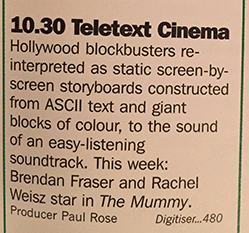
|
Brooker's 2001 book, TV Go Home (based on his website of the same name), a satirical take on TV listings magazines, included a listing for a fictional show called 'Teletext Cinema'. All its other listings referred to teletext subtitles on page 888 – here, though, was a reference to Digitiser and its page number of 480, with its producer stated as being Paul Rose (known to us as Mr Biffo).
Biffo and Brooker's relationship has mostly been amicable over the years, but has had the odd ups and downs. Since Biffo's return to the public spotlight in 2014, a recurring in-joke has been his visual resemblance to "a fat, old Charlie Brooker" – something Biffo has lampooned, played up to, or complained about with mock-outrage, on a number of occasions (not least during an extended segment at Digitiser Live in 2019).
A most excellent hue, the colour brown has featured prominently on Digitiser throughout the years, most obviously as part of the epic Brown Trumpet series of competitions. It's also the colour of poo. These things are possibly related.
Legendary competition run by Digi in an attempt to gain as much free publicity for themselves as possible. Brown Trumpet first launched at the beginning of 1997, and encouraged readers to show their devotion to Digi in the most impressively attention-seeking ways they could think of. The prize was a load of old rubbish edutainment-type games that Digi had in a cupboard and didn't want anymore.
It started off quite promisingly, with entries including such things as holding up Digi banners inside shops, a "parent" calling a radio phone-in about their Digi-addicted "son", and even the very first Digitiser website by Adrian Hon. Unfortunately the competition died a death a short time later with only a handful of people on the overall leaderboard.
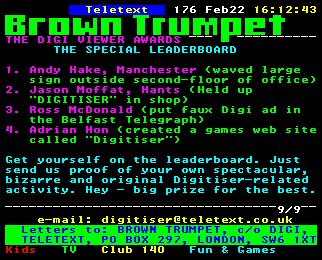
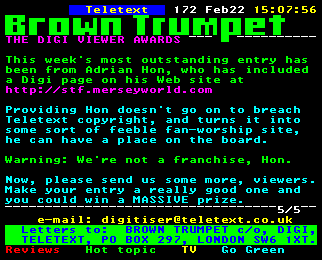
The reason for this seemed to be the lack of limits on how entrants could promote Digi: there was just too much scope for their poor brains to come up with interesting "wheezes".
Happily, though, this was not the last we saw of the end-beaver (endeavour), as - determined not to let a good idea go to waste - Digi had a go at relaunching the contest during the summer of 1998. It retained the Brown Trumpet name, but in order to simplify matters, this time it took on a new form: the form of a squid! (Lie.) No: they in fact revamped it as a new version of an old competition that was highly successful (Digitiser = Filth), with contestants now required to hold up banners that were to Mick Hucknall (simply read) the legend: "Digitiser Destroyed Me". This was much easier for idiots to grasp, and went on to be a great success as a result - with the winning entry showing the actual Terry Pratchett, naked from the waist up, in one of his stupid hats, up a mountain. Or it would have done, had Digi not somehow managed to lose it "somewhere safe", along with the winner's name and address. Other entries did survive, however, and were posted on the Digi website. A selection of them are below (click to zoom):
Brown Trumpet was so well-remembered that only a few months after Mr Biffo rebooted Digitiser as website Digitiser 2000, a new version of the competition was launched. Once again taking on the banner-in-an-exotic-location format, this time contestants were instructed to hold signs reading "Digitiser 2000 Ruined My Life" whilst dressed as a Digi character. Some of these cosplay attempts were genuinely impressive.
Finally, after recalling that the original 1997 Brown Trumpet just sort of petered-out with a whimper and no winner ever being announced, in 2019 Chris Bell of this very website jokingly reminded Biffo that Super Page 58 launched in 1997 - and that Brown Trumpet was supposed to run all year. Unprompted and completely unexpected, Biffo then announced Super Page 58 to have belatedly won the '97 Brown Trumpet! Just 22 years after the competition had launched. Feel the pride: FEEL IT.
Pop-culture website launched in 1999 by Mr Biffo and long-time friend and colleague Steve Horsley. Notable for featuring distinctly Digitiser-style humour - in fact, according to Biffo, he saw it as Digi in all but name, just without the games. The presence of Digi favourites The Snakes, Zombie Dave, and Dr Derek Doctors emphasised this point, with all of them making various appearances, alongside new classics like Jonny Hace The Boy With No Face, Captain Embryo, and Knife & Wife. The site was updated regularly with humourous articles and comic strips, and brought Biffo to the attention of a whole other audience - including radio host Christian O'Connell, who offered him work writing jokes for O'Connell's Xfm breakfast show. The Snakes also enjoyed a higher profile than they had on teletext, and very nearly became Phil Cornwell-voiced puppets on Nickelodeon as a result.
Leslie "Bunderman" Bunder was Teletext's technology writer, originally brought in to help set up the Teletext website. With the internet beginning to rise in both popularity and public awareness in the mid '90s, he was given his own section – Online – within Teletext's editorial pages.

|
He later took over from Adam Porter as the fourth Panel 4 columnist on Digitiser in late 1997, and was instantly derided by Digi's readers for his infuriatingly winsome style, which was glaringly out of place in the section. His obvious lack of gaming knowledge didn't help much, either.
Complaints about his columns were regular fixtures on the Digi letters page during the few months they aired, leading to his Digi-given nickname of "Bunderman" being re-purposed as "Blunderman". That was an open goal, really, but if you ever had to put up with his vapid writing you'd understand.
The torrent of calls for his removal could no longer be ignored, and his Panel 4 column was cancelled, to be replaced with a reader-written piece from April 1998 until Digi's end in 2003.
Despite his guileless exterior, Bunder was at the centre of a surprising amount of intrigue during his stay at Teletext. Bosses secretly anointed him to be Digi's new overlord as they drew up plans to oust the troublesome Mr Biffo and Mr Hairs. Management never took full action to put this plan into effect, and after the Panel 4 debacle it became clear that Bunder wasn't a good fit for Digi anyway. This thankfully curtailed the coup attempt, and put an end to the suits' anti-Digi machinations. For now, at least...

On the occasion of their 1997 visit to UK games industry conference ECTS, Mr Biffo had the serendipitous fortune to "bump" into the woman that played Calley in 'Grange Hill'. You know: the one that used to hang around with that bloke out of London's Burning and the one that was always reading 'Just 17'. Apparently she had chucked in the old acting game, and was now a PR mrs for Virgin. She had also reportedly lost her sense of humour in the process.
Digitiser stoked "huge" "levels" of "passion" in its readership over the years, from the very beginning of its broadcast, right up to the very end. While much of this came from the support of its fans, from some quarters there was unending bitterness towards the section and its writers.
AGAINST
When Digi launched as part of Teletext Ltd.'s new service in 1993, they made the not unreasonable choice to outline how they planned to cover the latest releases. Forged in the white-hot excitement of the 16-bit console era, they announced that all the major formats would be featured, and that PC games would be reviewed at weekends. Even arcade games would be covered, thanks to the generosity of the Teletext management allowing the Digi writers to raid petty cash for this purpose.
This may seem like a comprehensive slate of multi-format coverage, but back in January 1993 one format was glaring in its omission: Commodore's all-conquering Amiga.
Digi could see, even then, that while the Amiga had previously swept all other computer gaming challengers before it, it was now losing ground to the PC in terms of the quality and technical standards of its games. Seeing a machine which had its best days behind it, Digi's decision seemed logical and fair to the writers. But not to owners of Commodore's flagship product. Far, far from it.
As part of Teletext's launch, editorial staff had been told to come into the office and man the phones on the first day on air, answering questions from readers. This included Mr Biffo and Mr Hairs, who bore the full force of indignation from rampaging Amiga owners, who rang in incensed by Digitiser's decision to ignore their machine, demanding that the writers be sacked.
This campaign of hate never really subsided, even when Digi relented and chose to offer Amiga reviews as a way to placate the pitchfork-wielding nerds. Nothing they did satisfied the Amiga fans, and soon Digi accepted this and began to poke and troll them to at least bring some form of amusement from the situation. This only resulted in Digi's cards being marked forever among members of this particularly "unique" gaming community.
Petitions were sent to Teletext, letters were written constantly, and at one point Digi reported that a search through a prominent Amiga newsgroup returned more instances of the word "Digitiser" than "Amiga".
Digi found all this quite exasperating, but very funny.
FOR
When Digi's darkest hour came, at the moment it needed its readers the most, they were there for them.
The infamous Digigate saga of 2001-02, which saw the management-mandated removal from the magazine of all its humour and trademark characters, was not taken lying down by its fans.
By this point the section had been running for eight years, and built a massive following of around 1.5 million readers every week. It's fair to say that a great many of this number were tuning in precisely because of Digitiser's humour, which was now long-established, with myriad tropes, traditions, and catchphrases.
As soon as the reality of the bland new version of Digitiser became apparent, readers began inundating Teletext with letters and emails complaining about the changes, supporting Mr Biffo, and demanding the old-style Digi be restored. And they did not stop.
So much correspondence was received, in fact, that Mr Udders – Digitiser's man at Teletext HQ, who inputted the tips and charts – would bring sack-loads of these letters to Mr Biffo's home, to help his morale and demonstrate the outpouring of support, and that the fans weren't going to let this go.
And let this go they did not – for a full year. By the autumn of 2002, Teletext bosses had watched one of its leading sections, which raked in considerable ad revenue for the company, plummet in the ratings, and shed around 800,000 readers. Clearly panicked – and alive to the groundswell of fan ire at their decision to strip Digi of everything that made it so unique and special – they finally reversed their position, and asked Mr Biffo very nicely if he'd please make Digi funny again, and oh, bring all the characters back too, thanks a lot.
The humour started to trickle back onto Digi's pages in November 2002, and it was fully restored to its former glory, characters and all, in January 2003, for a final blowout few months before Mr Biffo left and Digitiser came to an end.
This could not have happened without the concerted, unwavering efforts of Digitiser's passionate and loyal fanbase, who absolutely refused to see something they loved taken from them in such a blithe way.
Whatever else you can say about Digitiser, it certainly made an impression on people.
Renowned Amiga Power writer, self-described "angry Scot", and one of the original Panel 4 columnists. A passionate advocate of Digitiser, he spearheaded the drive to set-up a Digi newsgroup on Usenet (and was aghast at not only the process, but the resultant alt.digitiser mutant), where he would fiercely defend both Digi and Mr Biffo.
Campbell showed his loyalty to the Digi cause many times, declining Teletext's offer for him to take over the running of the section in 1996 following the sacking of Mr Hairs, out of respect for him and Mr Biffo. He also wrote a (not entirely helpful) diatribe against Teletext's decision to strip Digi of its humour at the dawn of the Digigate era as his final Panel 4 column, which management unsurprisingly refused to run.
A few months after Digitiser came to an end in 2003, he set-up a web-based successor, Digiworld.tv, along with Kieron Gillen and Jonathan Nash, using content licensed from Mr Biffo – who also contributed an article early on. It was short-lived, however, and only lasted a few months.
Campbell returned to Panel 4 duties in 2018 for Digitiser's 25th anniversary celebrations, contributing a new column for the week of teletext-style Digi Mr Biffo published on Digitiser2000.
Digi interviewed early '90s indie-punk band Carter The Unstoppable Sex Machine - perhaps best-remembered as being the scourges of Phillip Schofield - in January 1994 about their love of games, for some reason. Apparently, Gary Glitter was also interviewed around this time, though this was never broadcast, which is probably just as well as he was a very dull guest. And also for other reasons.
Digi always had a knack for coining terms and phrases. Most of these were of the catchphrase variety, but every now and then something more serious stuck.
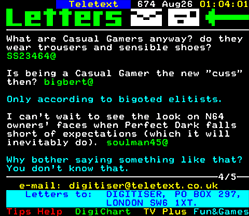
|
Around the boom of the first PlayStation, when gaming was opening up to a broader non-traditional audience, Digi began discussing the divide between longtime gamers and the interloping newcomers.
The shorthand they used to mark the distinction between the two camps was "hardcore" and "casual" gamers. The hardcore were those for whom gaming was a vocation or a sacred purpose to which they were entirely dedicated. The casuals were the new arrivals, who just liked playing a bit of WipEout or FIFA of an evening for a laugh, and weren't that fussed about what Shigeru Miyamoto was up to.
Precisely when Digi began using these terms is lost to history - for now at least, until recovered teletext pages turn up – but we know it was around 1998.
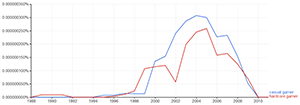
|
We also know that soon after this they entered common parlance, frequently being used by journalists and the gaming community, for better or worse.
Google's Ngram Viewer shows that the explosion in use happened almost immediately in the years following Digi's coining of the terms – especially the idea of casual gamers, which was an unfamiliar concept before this point. The hardcore were also more associated with Japanese tatsujin obsessives, and the phrase didn't really have a western context.
So, then - proof, if proof be need be, that Digitiser is the Shakespeare of games journalism. Yes: he really liked dick jokes too!
Oh yeah, and the making-up-phrases-that-people-are-still-using stuff. That too.
That and the dick jokes.
There have been quite a few Digitiser catchphrases over the years. Here are the main ones:
- - Best work yet – Said in reply to a viewer's letter if it met with approval, although somewhat tongue in cheek
- - Do you see? – Often used after making an off-kilter joke, obtuse reference, or as part of a withering reply to a particularly foolish reader on the letters page
- - Got and game! – Man stand-in/disguise Pat Walker's regular sign-off in his diary entries
- - Huss! – Exclamation of extreme disapproval, sometimes only for effect, and nothing to do with the fish
- - I cuss you bad – Main catchphrase of popular characters The Snakes
- - Moc-moc-a-moc! – Gibberish nonsense-phrase exclaimed with joyful exuberance by various strange reveal-o-characters
- - Nubbynubbynub! – Early catchphrase of The Man With A Long Chin, only used during 1993
- - Nun-nun-chal!/Chal-na-ha!/Chal-ning-ning! – Various exclamations by The Man's arch enemy The Fear Taunter/Man Who Taunts Fear
- - Press reveal – Instruction to press the reveal button on the remote control of teletext TVs, in order to reveal a joke, character, or something unexpected
- - Stay away from my bins! – Angry cry of Mr T
- - Swayze! – Meaningless exclamation, used at random in various reveal-o-jokes
- - wAReZ rULeZ!!! – Intentionally spelt like the author has had a stroke, this was the catchphrase of the character Computer Boy, and sometimes used in replies to letters. Referring to illicit cracked software sites, it was introduced after Mr Biffo was accosted on AOL Instant Messenger by an annoying child who kept repeating the idiotic phrase.
- - x-me-do – Used to describe something, e.g. "cuss-me-do"
- - You have messed-up – Said in reply to particularly foolish readers' letters
In Digitiser's early days, a hallmark of press outings for Mr Biffo and Mr Hairs was their celebrity back-stroking challenge. Starting at the "Sonic 2sday" press party at Hamley's toy store, the writers would challenge each other to stroke the backs of any celebrities in attendance – the rule being that it had to be firm enough for them to turn around, but the prankster must act like nothing had happened.
The duo stroked the backs of many celebrities over the years – with EastEnders/Grange Hill actor Todd Carty, Right Said Fred, Tony Robinson, and Rik Mayall among their number. They also dropped a whoopee cushion on the head of John Leslie, which I mention here without comment.
It wasn't only the hoi polloi like you and me who used to read Digitiser on Teletext - important people who have actually done something with their lives read it, too. Most well-known of these golden boyz is Alex Garland, the novelist and film-maker, who included a nod to Digi in his bestselling book, The Beach, and went on to pen a quite lovely paean to it for the magazine's tenth anniversary. Peter Serafinowicz, the voice of Darth Maul and all-round funny gent, was once described by Biffo as Digi's "second-biggest fan" after Garland, while J. Willgoose of most excellent hist-o-rockers Public Service Broadcasting was a fan as an adolescent and subsequently made a cameo in an episode of Mr Biffo's Found Footage. Latterly, US sketch comedy group Asperger's Are Us have become friends and collaborators of Mr Biffo, after discovering the cache of Man's Daddy jokes on this very site.
It's fair to say that Digitiser wouldn't have been half as memorable without its cast of surreal characters. Starting in early 1993 with mascot The Man With A Long Chin, and going right up to the modern era with the Beanus phenomenon, Digi's characters are one of the main aspects that have set it apart from its peers and contemporaries. Some of these characters have become synonymous with Digi over the years - it's impossible to think of Digi without the likes of Mr T, The Snakes, Morse and Lewis, or of course - The Man's Daddy. Seemingly born out of the same creative place where Mr Biffo's school-era doodles came from, they were often crudely-drawn and intentionally a bit rubbish-looking, but that was both part of the appeal, and what made them funny. Of course, their presence also infuriated Digi's detractors - which only encouraged Biffo to feature them all the more.
Adam Keeble, the first 'auxiliary' writer to join the team, went by the nom de Digi of Mr Cheese. This was carried over from the pseudonym he used to enter the very first competition ever run by Digitiser in February 1993 - a limerick contest, in which entrants were instructed to submit prose which contained the words 'Amos' and 'milk'.
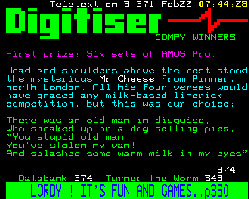
|
According to Biffo, his entry – which included four alternative limericks – was far and away the funniest and most Digitiser-y. The one which they singled out as their favourite and printed on-screen was:
There was an old man in disguise,
Who sneaked up on a dog selling pies,
'You stupid old man!
You've stolen my van!
And splashed some warm milk in my eyes' "
The true identity of Mr Cheese was revealed shortly after this – and much to Biffo's surprise, the mysterious competition winner turned out to be a good friend from his weekly role-playing group.
Having known Keeble for a few years, and that he had both an imagination and aspirations to be a writer, Biffo approached Teletext management about bringing him in to help. The Digi team were struggling with the sheer volume of correspondence they were receiving, and – most crucially – had an urgent need to publish Amiga reviews, in order to satiate the bloodthirsty hordes of Amiga owners that had been angered by Digi's initial editorial decision not to cover the format (the most pertinent reason for this being that none of the writers owned one).
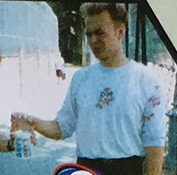
|
Mr Cheese duly joined the team two days a week, and over the next few years contributed to the reviews, tips and cheats, helped input the letters, and even signed "photos" of Turner The Worm to send to kids that wrote in asking for them. He wasn't exclusively a Digitiser man, however, and the still-teenage Cheese got stuck-in wherever he was needed across Teletext's various editorial sections – from Generator (where he had letters printed under the pseudonym "Savo", going on about Aston Villa), to Bamboozle, to Planet Sound – while simultaneously studying for his A-Levels. But Digitiser days were always his best days, and sitting writing the fake ads and Christmas Pant-ohs, laughing like an idiot alongside Biffo and Hairs, were the highlights of his time in Fulham.
As well as being a good fit with Digi, he was also well-liked by the management team, and they were keen for him to be promoted, but concerned by the fact he had no formal journalistic training. Showing how highly Teletext rated Keeble, they paid for him to go on a prestigious three-month diploma course, which sent him to work on a local paper at the end to round off his editorial experience. He was promised a spot writing for the features section of his choosing once the training was successfully completed.
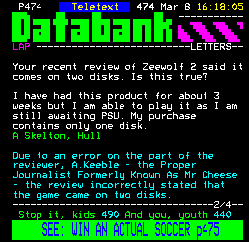
|
Cheese returned to Teletext newly-qualified in January 1997, and chose to join the TV Plus section – reasoning, not incorrectly, that it would involve a lot of interviewing of celebrities, accompanied by alcohol, at the BBC. His biggest claim to fame from this run was securing an exclusive interview with Jerry Springer (of "The Opera"/trailer trash-baiting talk show host fame), which he was proud of, but just saw as doing his job. He later found out that his superiors felt his reaction to scoring the interview should have been strutting about the office like a cock, declaring his brilliance to everyone, before taking the rest of the day off and going to the pub.
This macho behaviour didn't sit well with Cheese, and, on top of the departure of colleagues that were well-liked, he began to feel that his future was elsewhere. He eventually left Teletext – and the country altogether – in late 1999, for a life in the US. Before going, however, he recommended Mr Udders – Gavin Lambert, a friend of his – as an inputter to help Biffo with the tips and charts, just as he had years before. After a shaky start, with Biffo demanding of Cheese "What is that kid's problem?" following the near-loss of the week's games charts, Udders became Biffo's right hand man for the rest of Digi's time on air, and a longstanding friend.
Digitiser: a legend based on poo jokes friendship.
In the autumn of 1993, just a few weeks before The Man had his fateful dance with a bullet, the most controversial exposé to have appeared on Digi at that point was aired.
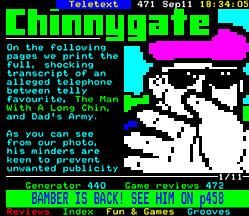
|
Broadcast over the weekend, it was dubbed "Chinnygate", and took the form of a published transcript of a sordid telephone conversation betwixt The Man and, bizarrely, Dad's Army. The extract that was shown showcased the hitherto unknown dark recesses of The Man's mind, as the callers proceeded to spew forth copious amounts of "exotic" detail about what they would like to "do" to each other.
The transcript ended with The Man having to cut the call short, citing the reason as "Chapman is coming". Of course he's entitled to have a private life, but you can't help but wonder if this was the catalyst for some mentally-unhinged obsessive to take extreme measures in demonstrating the apparent shame that this incident had brought. He was shot through the head by an unknown assailant from a grassy knoll, eerily, on the 30th anniversary of JFK's death.
Never chocolate. Always choc.
Various Digitiser characters have met their demise at the hands of an insect pupa over the years. This was how The Man came to announce his departure in late 2002 – in his first appearance after the restoration of funnees following the arid days of Digigate, in fact. We were informed that it would also be his final appearance (not true) as he had in fact died.
How did he die? He choked on a chrysalis of course!
Since then, the phrase "choked on a chrysalis" has become a Digi slang term, implying that something has vanished, is dead, or inactive.
Digitiser's 1993/94 collaboration with the Maverick games mags Super Control and Mega Drive Advanced Gaming featured a series of Man With A Long Chin comic strips. Mainly drawn by Maverick's graphic artist Paul Mallinson, with contributions from Mr Biffo, six strips of these uniquely non sequitur affairs were produced in total, all of which can be found on the Super Control collaboration page.

It wasn't very long into Digitiser's life - just three months in fact - before they started to write about things other than video games. From March 1993 and for most of that year, Digi would wheel-out the Comic Trolley as a semi-regular feature at the weekend. Obviously fuelled by Biffo's love of the medium, it was nevertheless strange for a games-mag in that it didn't have anything to do with games. Proudly so, in fact - they simply indulged their love of comics, gave the latest news and previews, and had a quick flick through the hottest new releases, saying if they were any good. It should be noted that Digitiser was subject to little or no editorial scrutiny at this point in its history...
Retro-gaming shop and museum located in Marlow, Buckinghamshire, that was the subject of a surreal feature on Digitiser in late 1994.
Rather than simply provide a description of the shop and its products, Digi instead published a two-part survival horror fantasy detailing their trip to the Cavern, whereupon they were supposedly trapped and hunted by its supposedly-evil owner, Mr Gandy, and his mutant son "Half Beard".
Over two weekends and tens of pages, the feature made the quaint shop, with its vintage computers and rare games, sounds like something out of Hellraiser, with Digi fighting for their lives amongst the monstrous creatures made out of old cassettes and cartridges.
In reality, Gandy and "Half Beard" were quite benign, and had been very pleasant to the Digi team on their visit. The owners were keen to read the feature, and having missed it when it went out on air, contacted Digi to ask if they could send them a printed copy.
The writers duly obliged – and never heard from anyone at the Computer Cavern ever again…
While Digitiser was celebrated by Teletext bosses in its early days for the high ratings the section brought in, that honeymoon period didn't last long. Once management realised that they didn't just have a normal, innocuous little computer games section on their hands, but something much more troublesome – and that the people writing it delighted in making mischief – they were soon watching it like hawks. Paranoid, and not particularly observant hawks, but hawks nonetheless.
The fact the section was so popular even seemed to build resentment among management. Digitiser was too valuable for them to outright kill the section off – it brought in a substantial amount of ad revenue for Teletext – and so they tried to sabotage it instead.
The suits concluded (not inaccurately) that Mr Hairs and Mr Biffo were a bad influence on each other. For some reason they also believed that Hairs was largely responsible for the inappropriate behaviour in the office, and that innocent little Mr Biffo was being led astray. As a result, their first attempt to get Digi back into line was to separate the two main writers, like naughty schoolboys.
As if them no longer sitting together would put a cork in Digi's bizarre output. In reality, this simply made the pair push back further, and even more determined to keep the Digi flame burning – Biffo would even sneak in writing articles for Digi in his lunch break, as he was supposed to be concentrating on graphics work the rest of the day.
When separating them obviously didn't work, the suits began to hatch other plans to cure them of the troublesome pair. They weren't particularly discrete about this, however, and one day Mr Hairs stumbled across a secret memo from the editor detailing their Machiavellian scheme. Leslie Bunder, Teletext's technology writer, was to be groomed to take over the running of Digitiser, and was instructed to familiarise himself with Digi's output to prepare for his new regime when Biffo and Hairs were ousted. Where was the top-secret evidence of this clandestine plot discovered? On Leslie Bunder's desk, of course.
Bunder was an inoffensive, if slightly manic figure, and not particularly imaginative or compelling in his writing – the complete antithesis of the Digi team, in fact. These qualities made him the perfect antidote to Digitiser in management's eyes, and an ideal puppet for their coup d'état.
The intention was clear: as a freelancer, Mr Hairs could be sacked easily, while Mr Biffo – who had a permanent contract – was technically employed as a graphic designer. By "disappearing" Hairs and insisting that Biffo concentrate solely on his graphics duties, management would finally be free of these two "flies" in their "ointment".
Thankfully, this scheme never fully materialised – the Bunder plot seemed to fizzle out, as he worked more and more on the Teletext website.
Sadly, of course, they did succeed in firing Mr Hairs in April 1996 following the Dave Perry news story incident. Mr Biffo remained in charge of Digi, however, and was able to convince his superiors to let him run the section permanently.
Management would try one more time to put Bunder on the Digi throne. They saw their chance when Adam Porter lost his spot on the Panel 4 roster in late 1997, moving to insert Bunder in his place with a view to him eventually taking over.
Of course, what they didn't count on was Leslie Bunder being the single most unpopular writer in Digitiser's history.
Wave after wave of reader complaints about him poured in after every one of his misguided columns aired. A campaign to remove him was started on Digi fansite Page 170. The pressure was eventually too great for the suits to ignore, and they were forced to back down – instead of Biffo being removed from Digi, it was in fact Bunder who lost his place on the team.
That wasn't the end of Teletext's scheming against Digitiser, of course – not by a long way. But Digi's Biffo-shaped future was secured for a few more years yet – which just so happened to coincide with what many consider to be its golden age.
Digitiser were no strangers to controversy. In fact, they were introduced on their very first day on air, and were so close by the end of the magazine's time on Teletext that their families were holidaying together in Tuscany, probably.
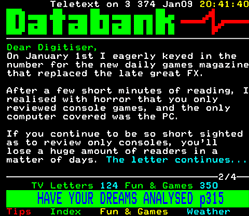
|
Yes, things started as they would very much carry on when Digi failed to acknowledge the Amiga as the world's pre-eminent gaming system, as its rabid owners were convinced it was, and this band of lost souls very much brought the pain. Specifically: to Digitiser. As part of the launch of the brand new Teletext service on 1 January 1993, all staff had been required to come to work on New Year's Day to answer all the phone calls from confused elderly people. Except: a very large proportion of these callers were fuming Amiga-owners, who wasted no time in demanding that the Digi writers be sacked. This relationship dynamic carried on unabated for about the next six years.
It wasn't long before Digi were making headlines again - literally, this time - when, in March '93, they made a flippant throwaway remark in a review of SNES Street Fighter II along the lines of "Now you too can develop epilepsy". This was a tongue in cheek reference to current tabloid hysteria around video games, but it still prompted a complaint by an apoplectic rep from the British Epilepsy Association, forcing Mr Biffo to spend quite some time trying to placate him.
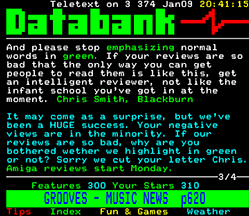
|
This seemed to have worked, with the two apparently coming to an amicable understanding. Not for long, though: the rep went straight to the newsdesk of tabloid newspaper The Sun, and the story ended up splashed in sordid style with the headline "TELETEXT RAPPED FOR SICK VIDEO GAME JOKE". Fittingly, this came to Biffo's attention while reading a copy of the paper while on the toilet. How very on-brand.
Unable to resist making mischief, a short time later Digi started their longterm embrace of April Fool's Day. On 1st April 1993, their news page saw them reveal the scoop that Sonic The Hedgehog was set to die of septicaemia at the climax of the next big Sonic game. Entirely taken in by this, a distraught reader wrote to CVG wailing about it, wanting to know if the awful news was true.

|
Later the same year, for reasons best known to themselves, Digi decided that a tribute to outrageously-toupéed EastEnders crooner Danny Taurus was what was missing from their pages. A lurid representation of Taurus was given pride of place in The Man With A Long Chin's spot for two weeks in September - complete with impossibly-coiffed hairdo. Except there was something ever so slightly off about it. And that thing was the thing of the penis-shaped thing.
That's right: atop Danny Taurus' head proudly sat a cock and balls, which became ever more ostentatiously phallic by the day. Eventually, a viewer wrote to Digi about it, including a sketch of their depiction of Danny Taurus, with an arrow pointing to his "hair" and the question: "Possible cock?". Realising the jig was up, Digi quietly retired the character.
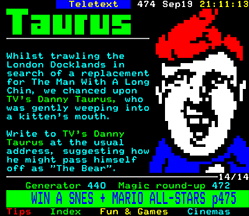
|
The applecart-upsetting shenanigans continued unstoppably into 1994, first with the bombshell review score of 72% for Sonic 3 - the fallout from this would last for years - before the feud with their papery mag "rivals" kicked into high gear. In a wilfully obtuse move designed to do nothing more than alienate themselves from their games journo peers, Digi began running a regular feature where they 'reviewed' other magazines. Hosted by Smokin' Glenn Miller - The Mag Monkey - in one column they described Dave Perry's Sega Pro as "mostly irrelevant". The deputy editor of the Paragon mag phoned in a rage threatening to sue, and demanded a print-out of the offending page. Digi promptly changed the text to read "mostly irreverent", printed it and faxed the page over. And never heard anything about it ever again.
Danny Taurus was by no means the last character resembling the male member to feature on Digi, with 1994/95 being a particularly rich time for moments of controversy and innuendo. A procession of phallic-looking characters followed in his "footsteps" parading about on their pages, including the likes of Peelbacca - ostensibly a Wookiee, until you got the joke and looked closer - and Niels, a "monster" that had no intention of chasing and eating men, but would like to "suck off" the Blarney Stone.
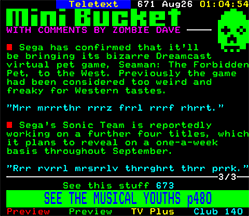
|
These characters inexplicably slipped through the sub-editors' nets and made it to air, but Dr Derek Doctors wasn't so lucky. After a fine run of unsettling cult-leader raving throughout '94, Biffo was eventually ordered to stop "doing" him after his arcade-rants became ever more sinister in tone. A reader's mother phoned Teletext to complain about one such page, where Doctors had declared "I am now entering your mind" - apparently, she'd interpreted it as a different sort of "entering" to what had been intended...
More evidence that the idiot British public could always be relied upon to spoil the fun came when another viewer complained about a 1998 Gossi The Dog column. Instead of only complaining to Teletext - who wasted no time in pulling the page from air - they also went to regulators, the Broadcasting Standards Commission (later replaced by Ofcom). The complaint was upheld, and the regulator's ruling from February 1999 is reprinted below:
Gossi the Dog Teletext, 26 October 1998
The Complaint
A viewer complained about animal cruelty being used as a subject for humour.
The Broadcaster's Statement
Teletext said that the Digitiser section prided itself on its irreverent and 'off-the-wall' humour and decisions about what might offend could sometimes be difficult. However, on this occasion, it felt that the borderline had been overstepped and the frame was quickly removed from air.
The BSC's Finding
A Standards Panel noted the Teletext page in question. It agreed that a reference to the beating of a dog, albeit fictional, would have been likely to have caused offence. The complaint was upheld.
UPHELD
CN 1411"
Following this, in March 1999, an edition of The Man's lonely hearts column was pulled from air midway through the day. Another viewer complaint meant that the entry "FAT WOMAN, 38, needs ginger-haired man for immediate production of ugly children" became something of a collector's item (in the words of Biffo: "So funneee"). But later that year, a whole series of innuendo-laden jokes about bizarre Japanese virtual pet game Seaman came and went completely unimpeded.
And of course, on the subject of "seamen"..
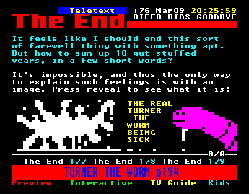 |
The glorious final edition of Digitiser went out in March 2003, featuring a bumper crop of farewell material. It 'climaxed' in legendary style, with The Real Turner The Worm Being Sick – the reveal-o-joke to end all reveal-o-jokes. This is arguably the image that's still most associated with Digitiser: a hilariously lurid depiction of Teletext's Biffo-drawn cartoon character Turner The Worm, reimagined as a fittingly garish spunking cock. At the time, as a parting mic drop for Digitiser's farewell, it was both shocking and funny beyond measure, even to seasoned Digitiser fans. Teletext's sub-editors discussed whether it should be allowed for broadcast, and happened to be feeling benevolent that day - as they had for the whole of Digi's final week, in fact, with Biffo admitting at his leaving party "Everything this week has been 'suspiciously phallus-shaped'!".
Luckily for the subs, not a single viewer complaint was received. Now, that is controversial.
Arguably an even more audacious prank had been pulled by Biffo for Digi's penultimate edition, given that the smutty humour didn't require pressing reveal to show a hidden message - it was plain as day. For the preview of the infamously profanity-laden Conker's Bad Fur Day for the Xbox, Biffo went to great pains to ensure that rude words were spelled out vertically down the left-hand side of the screen. He agonised over this task for ages to get it to work, and was certain the sub-editors would notice and veto it. They didn't. But no readers spotted the joke either. Here they are now, click to zoom in:
Digitiser's relationships with its printed magazine peers of the early-to-mid '90s have been well-documented. The tie-up with Future Publishing to give away magazine subscriptions as Hot Topic prizes in the nice friendly corner, and the, uh, 'eventful' correspondence with EMAP's Sega magazines in the... other one. But Future weren't the only papery proprietors who were partial to Digi's thighs: Maverick Magazines liked to have a good stroke too, principally via the medium of their SNES-covering Super Control, with their Sega title Mega Drive Advanced Gaming later joining the tryst.
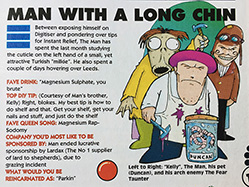
|
The Digi team were contacted quite early on, and a rapport was built which lead to a sort of collaborative crossover/partial Digitiser colonisation of the Super Control pages. Not only was there a big stupid competition between the Digi team and their Maverick counterparts in the form of the 1993 Digitiser/Super Control Lard Challenge, but The Man With A Long Chin even got his own comic strip. A number of early Digi characters would enjoy their own cameos, too - usually drawn by Super Control's Paul Mallinson, with the occasional effort by Mr Biffo himself.
Every single Digi appearance across both magazines has been located and preserved for "posterity", including all of The Man's comic strip outings, and the legendary Lard Challenge.
The summaries at the end of reviews used to have a small cryptic statement below the final score. This was usually a play on the title of the game and would either be used to describe the game itself, make an oblique reference to something from pop culture, or (more than likely) just be there to confuse. Examples of these such as the pithy Endorfun: "End Of Fun" and Rayman: "Hoffman/Cruise joke" can be found on the quote-o-page.

Future-published UK magazine focused on Sega's last gasp of the console market, the Dreamcast, which ran for 20 issues between 1999 and 2001. The 24 January 2000 issue featured the first ever print-based interview with Mr Biffo, which should have put to bed any lingering suspicions idiots had about anti-Sega bias, given Biffo's fondness for the fallen giant's ill-fated hardware swansong.
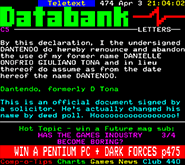
|
Long-time "star" of the Digi letters page, Dantendo - to some of us, known "affectionately" as the High Lord of The Mess-Ups - once sent a copy of a formal legal declaration to Digi, showing that he had officially changed his name to Dantendo by deed poll.
While funny at the time, this took on a more worrying complexion in the light of him subsequently suffering from apparent mental health problems.
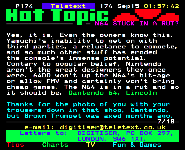
|
He later sent a photo to Digi of himself in a department store with his trousers round his ankles, a series of unhinged ranting letters accusing Digi of spying on him through his TV, and, ultimately, disturbing screeds that came smeared in his own excrement.
At this point Digi called the police.
Affectionate term by which Digitiser is known among its fans and writers, still in use today. This shorthand nickname was coined early on in the magazine's life, replacing the rather more awkward "Big D", around 1994. After being regularly used by the editorial team to refer to the section, readers and fans quickly began to adopt it too, and the name has stuck ever since.
On, oh... one... occasion during a review, the writers of Digi referred to themselves as "the Digi Fellas", as they all wrote for Digi, and were all - well - fellas.

|
For the record, there is of course Mr Biffo (Paul Rose) - the only founder member to man the good ship Digitiser until its very end as editor of the set-up, all-round hero and most prominent Talc Boi; Mr Hairs (Tim Moore), who founded Digi with Biffo and was jointly responsible for the magazine's unique humour and outlook (now a successful travel writer with many extremely funny books under his "belt"); and Mr Cheese (Adam Keeble), who was brought in by Biffo and Hairs to write Amiga reviews and input the tips and charts (he also used to contribute to Planet Sound and Club 140).
To bolster the depleted ranks following Mr Hairs' controversial departure, Digi then snapped-up one Mr Udders (Gavin Lambert), who contributed characters such as Dennis: Man Of Zinc, Strangelove The Tramp, and Wired Child, as well as doing the tips and charts as Mr Cheese had before him. There was also, briefly, Mr Toast - a mysterious Irishman known only as "Sean", who was part of the team for only a few months from late 1996 to early 1997, who apparently understood Digi to a pleasing degree, and performed the same Udders-role.

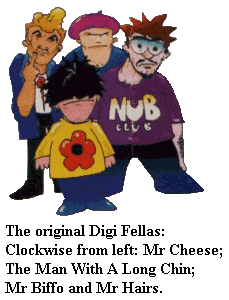
Day-long celebration of Digitiser, which took place at the Centre For Computing History, Cambridge, in October 2016. Hosted by Mr Biffo and featuring panels including the likes of Mr Hairs, Violet Berlin, and Steve Horsley, Digifest was a significant event bringing fans together to pay tribute to the legendary magazine. It also saw the debut of what would later become the pilot of Mr Biffo's Found Footage.
Term that has come to be used to refer to the period from October 2001 to November 2002 when Teletext Ltd's management demanded that Digitiser be stripped of its humour and characters. Bosses wanted it to be written as a more 'straight' section, minus its idiosyncratic personality.
This era is regarded as a dark time in Digitiser's history, and was notable for the loss of around 800,000 viewers in response - more than half of the readership prior to the changes. Floods of letters were written by fans lamenting what had happened, and asking for Digi to be restored to its former glory.
Teletext eventually conceded they had made a mistake, and Digitiser's humour returned for a final few months before the section closed in March 2003. Mr Biffo departed at this point, having felt the experience and eventual victory was a sign that it was now time to bring the curtain down on Digi and move on.
It was replaced on Teletext by the Tony Mott-written GameCentral - a much more sedate, conventional publication.
A more detailed look at the Digigate saga can be found elsewhere on this site.
One of the most ambitious and significant of the competitions run by Digitiser in its early years required readers to take a photo of themselves in the most exotic location possible, holding a sign reading "Digitiser = Filth". Some years after the competition ran we learnt that the winner had been stationed atop a mountain in front of a Buddhist temple in Thailand with his banner. Later still, we learnt that said winner was Alex Garland, author of novel-then-film The Beach - which was inspired by this trip, and included a chapter entitled "Messed-up". Digi's tentacles reach far and wide.
Website started by Mr Biffo in 2014 following his return to public life and the Digitiser brand. A place for Biffo to review and talk about games, as well as publishing nonsensical funnees and whatever else interests him. Since 2016 it has featured traditional Digitiser-style teletext graphics, with many classic-era characters returning at various times.
The site was quietly taken offline in 2024, but is still accessible using the Wayback Machine. During its nearly 10 years on the internet Digitiser 2000 served as a central hub for Biffo's non-day job work, including the videos on his YouTube channel, live events, and other Digitiser-related activities.
The culmination of the Digitiser The Show project, in the summer of 2019 a live Digitiser spectacular took place that went way beyond what anyone expected at the outset - least of all the team themselves. While the content may have been inspired by it, Digitiser Live was far more than merely a live version of an episode of the show.
Digi on stage turned out to be an exercise in taking the format to its extremes, with incredible ambition and neverending ideas being thrown into the mix by Mr Biffo, right up until curtain time. Adding in generous amounts of absurd humour, physical comedy, classic Digi characters - and a bit about games too, probably - the evening was a riotous, semi-improvised triumph, which you can watch in full.
YouTube-based retro-gaming series crowdfunded by Mr Biffo, based on Digitiser and billed as the return of 'proper gaming telly'. Following a wildly successful 2018 Kickstarter campaign which brought in more than six times the target funding, Biffo set about developing the show brimming with enthusiasm and creativity.
Co-hosts were recruited in the form of Paul Gannon, Octav1us, Larry Bundy Jr, and Gameplay Jenny; and classic Digitiser characters were brought to live-action life – including The Man's Daddy, Tin Man, Insincere Dave, and Mr T (courtesy of the UK's foremost Mr T impersonator).
Filmed over the summer of 2018 and debuting in November that year, the six-episode series unexpectedly brought in a whole new audience, many of whom had never heard of teletext before, let alone Digitiser.
An ambitious, well-produced exercise in bringing the spirit of classic Digi to the screen, Digitiser The Show was a worthy addition to the Digi legend. Full of anarchic moments and absurdist sketches, with the feel of a gaming show being filmed while falling-down-the-stairs, it was undoubtedly the event of the year for Digitiser fans.
Every episode of the series is available to watch now.
Unique teletext-style website intended as a successor to Digitiser, mostly written by Stuart Campbell, along with Kieron Gillen and Jonathan Nash, plus an early contribution from Mr Biffo.
Digiworld launched in July 2003 after Biffo had mentioned to Campbell that he missed doing Digitiser, which had ended on Teletext a few months before. It retained the format, style and some of the classic Digi characters, many of which could be seen by clicking the reveal button on a remote control graphic shown alongside the content.
Conceived as an experiment to see if it was possible to run a web-based gaming magazine by having readers pay to view it, the answer was sadly no, and Digiworld only lasted for eight weeks. Even in this limited time, it still managed to produce a large amount of material, publishing daily editions in a similar vein to classic Teletext Digi.
The whole run is available to download as an archive from The Weekly.
For a month or so leading up to the launch of Teletext Ltd's new service on 1 January 1993, editorial staff wrote their sections 'as-live' to prepare them for the daily updates they'd be producing once the service was running for real.
Digitiser was no exception, and both Mr Biffo and Mr Hairs wrote and produced pages to help get them ready for launch. These pre-launch pages were never broadcast, but some of them did slip out as part of the press release the Digi gents despatched to leading papery games mags of the day.
One of these magazines – Dave Perry's Sega Pro – included the screenshots alongside their news story on Digi's debut. Thanks to teletext recovery hero Tim Bisley, these images have been restored from the magazine screenshots, giving us a glimpse of the embryonic Digi.
Indie-rock band fronted by Brazilian singer Isabel Monteiro, whose original line-up featured Teletext music writer Dave Hunter as lead guitarist. Hunter was a great admirer of Digitiser, and well-liked by its writers, to the extent that they gave away copies of Drugstore's first single 'Alive' to writers of their favourite letters to Databank in April 1993.
The New Year's Day 1994 edition of Digi included a large portrait of Hunter – dubbed "Hunterman" – on its first page, giving his strange predictions for the "space year 2000AD".
The pages of Digitiser would often be peppered with ironic, in-character references to the consumption of alcoholic beverages, principally among them; gin. On many occasions the excuses Digi gave for something being wrong, or not wanting to bother with a proper reply to a letter, were along the lines of: "we're drunk", "don't ask us, man, we're drunk", "you should never listen to the opinions of drunks", or "spend your money on gin instead". Before Mr Biffo revealed the truth in his 2015 Digitiser memoirs, it was widely believed that the team spent The Lost Weekend, when Digi was not updated, in a drink-induced catatonic state. Controversially, at his 2003 Digitiser leaving party, Biffo claimed to not actually like gin at all, which was akin to being told by the Honey Monster that he can take or leave Sugar Puffs, to be honest.

Popular cockney wrist-slashing soap opera, which Mr Biffo has made no secret of his fondness for. Over the years Digi enjoyed the company of many guests from the long-running show, who would make little appearances here and there via the mediums of the reveal and the other mediums. The most frequent of these characters to grace Digitiser's hallowed pages was the annoying ginger-whinger Ian Beale, who turned up to inform readers of stuff that he likes, and stuff that he dislikes (his wife being one of them).
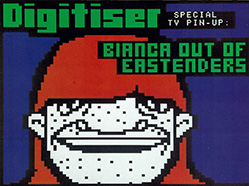
|
Others who have popped up include the Mitchell brothers, both together and separately, the impressively-eyebrowed Mark Fowler, and chain-smoking immortal matriarch Dot Cotton and her degenerate son Nick "Allo, Ma!" Cotton.
One of the earliest spoof scripts to be shown was also set in Albert Square, featuring some old favourites, and some all-new characters (witness Chaka Demus, and Pliers: sons of Pauline and Arthur Fowler).
F. Butcher: "Ruuuuunnnarrrouuund!!!!"
A. Fowler: "Christmas club box... I... Love it"
Demus (shrieking): "My Papa"
The team's love of EastEnders was such that they even aired a spontaneous tribute to Frank Butcher (played by Mike Reid), on the evening of his final (at the time) episode on the show.
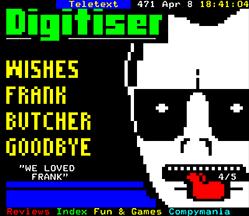
|
As luck would have it, the episode coincided with a Teletext Ltd "bring your children to work" evening, meaning Mr Biffo and Mr Hairs were both in the office while their colleagues were distracted by their little darlings, and getting mildly boozed-up.
The duo snuck away and surreptitiously created a full-page graphic of Frank, along with a touching farewell message, secretly inserting it into the pages of that day's Digitiser live to air. It's just as well that no one was looking, as if any fellow staffers had noticed, they "would have landed in baaaad trouble", in Mr Biffo's words.
The thing Mr Biffo also remembers about this soiree is having to stop his daughter from kicking Teletext's editor.
Given this catalogue of cockney-love, it should come as no surprise that Mr Biffo eventually wound up writing an episode of EastEnders following his departure from Digitiser in 2003.
In one of his more notorious achievements, he managed the feat of having Dirty Den say the rudest of rude words in his episode, by masking it - with special emphasis - within the word "constable". Biffo had also included human beatboxing, and a takeover delivery by 'Zombie Dave's Pizza'; though sadly the latter didn't make the final draft of the script.
Legendary taste-making multiformat magazine, published by Future since 1993. Digitiser had a good relationship with Future, and subscriptions to Edge were often given away as prizes on Digi's weekly Hot Topic letters page. A glowing retrospective feature on Digi was printed in January 2003 to mark both its tenth anniversary and the return of its humour following the Digigate saga, which included a lengthy interview with Mr Biffo. Biffo then went on to contribute a monthly column for Edge only a short time later, which ran until 2008.
In the aftermath of The Man With A Long Chin's assassination in November 1993, there followed an election to find his replacement. Candidates included The Man's brother DIY "Kelly", genocidal Robot XJ7, two others currently recorded only as "Clem" and "Nowhere", and eventual winner, the Mike Read-style out-of-date radio DJ Pat Walker. Votes took place over a couple of weeks, during which time The Man's page featured his gravestone. Walker took over in early December, and Digi later revealed that they had in fact "rigged" the election in his favour - largely, it seemed, to allow them to develop the strange unfolding mystery surrounding The Man's return, which came about on 18 January 1994.
Import-heavy early '90s games fanzine that was later published professionally. The magazine ran a series of national TV adverts when this step-up took place, even advertising on Digitiser in the form of full-screen graphics featuring their weird brain-mascot. This was reciprocated by the Digi team, who funnelled a little of that revenue back to Electric Brain, running ads hand-drawn by Mr Biffo to promote themselves in return. The Digitiser ads lasted a few months in 1993, before Electric Brain eventually folded. Images of the ads are below, click to zoom in:
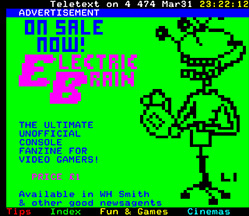
When the mass communication shift from letter to email came in the 1990s, Digitiser initially credited readers' full email addresses on their letters page. This was brought to an abrupt end in the autumn of 1998, when long-time Digitiser community member Mr PSB had a letter printed mildly poking fun at Amiga owners, and was subsequently inundated with The Mother Of All Hate-Spam from irate, deluded idiots. The Amiga fanboys inexplicably believed their machine was still alive and had any sort of future, rather than being the festering corpse that everyone else could clearly see it was (even Mr PSB, who was an Amiga owner himself, and kindly provides a sample of the abuse he received below). This meant that Digi decided not to allow readers to be subjected to similar tirades from anally-retentive die-hards howling into the void, and from that point on only the first half of email addresses were shown on-screen.
Magazine publisher which boasted the iconic Mean Machines, CVG, Sinclair User, and official Sega and Nintendo magazines in its stable of computer and video game magazines.
EMAP's titles were notorious for their loathing of Digitiser, most notably Mean Machines Sega and Sega Magazine. Its games mags were produced at its offices in Farringdon, central London – with magazines sharing many members of staff across the various editorial teams.
It should therefore come as no surprise that the protracted anti-Digi sentiment often bled across the range of titles, with EMAP very much being seen as 'the enemy' and derided by Digitiser throughout the '90s.
The eras of Digitiser's life can broadly be classified into the following periods:
- 1. Launch – January to March 1993 Finding their feet, getting to grips with the format, and figuring out what Digitiser was.
- 2. Early days – March 1993 to late-1994 The first characters appear, Digi's strange humour starts to surface, many of the hallmarks and tropes take root.
- 3. Established – early 1995 to spring 1996 Regular features like Old Game: Here and Ring-sir! are in place, while long-running characters including Fat Sow, Gossi The Dog and The Man's Daddy get their debut. Digi is confidently itself, has its own voice and knows what it is.
- 4. Phase 2 – spring 1996 to late 1997 Biffo takes the reins solo following the sacking of Hairs, and rises to the occasion by turning up the weirdness levels.
- 5. Golden Age – early 1998 to mid-2000 Arguably the most popular and best-remembered period, some of Digi's most famous characters are introduced, and the reveal button comes into its own in a big way.
- 6. Late period – mid-2000 to October 2001 Digi has matured into a long-established organ; spoof scripts are published in place of Man Diaries more regularly as Biffo's scriptwriting career starts to take off, popular characters get extended multi-page adventures.
- 7. Digigate – October 2001 to November 2002 Teletext bosses order Biffo to remove all of the humour from Digi, sucking out the personality and losing 800,000 readers in the process. A dark time for all concerned.
- 8. Restoration – November 2002 to March 2003 Teletext realise their mistake, apologise to Biffo and ask him to reinstate the humour. The final months of Digi's life are hilarious, explosive, and notoriously memorable.
- 9. Rebirth – November 2014 to present Biffo decides to return to Digi, rebooting it as a website and writing under the 'Mr Biffo' name for the first time in six years, going on to produce Kickstarter-backed video series, Mr Biffo's Found Footage and Digitiser The Show. Digi goes from strength to strength, forges a welcoming online community, and attracts a legion of new fans.

During its first few years on air, Digi took great pleasure in publishing full-page spoof, fake adverts in their weekend editions, satirising those which Teletext ran in order to "bring home" the "bacon". They would often feature lard in some capacity, and were both surreal and silly in the extreme: an advert for a metal companion that made your house seem less empty named 'Roaming Thomas'; an advert for a device which forced your dog to dance against its will called 'Dog-A-Rhythm', and of course the series of satirical 'German' compilation albums: 'Das Techno Zone' and 'Rockmeister' ("music fur der longhairs").
However stupid they were, you could always guarantee that some viewers would take them seriously, which is what forced Digi to stop "doing" them in the end. All of the currently saved fake adverts are collected on this site.
Digitiser was so popular following the launch of Teletext in 1993 that there were discussions about setting up a fan club for it. The ratings for the section started high and kept going up, leading management to describe Digi as "the saviour of Teletext". It may be hard to believe given the enmity that would later unfold, but in those days being a ratings darling had management viewing it very favourably indeed.
Unsurprisingly then, Teletext's marketing department saw an opportunity, and suggested the fan club, looking for ways to build on Digi's popularity by making the most of the growing audience (and some cash). The idea had plenty of supporters, and was seriously considered for a time, but eventually came to nothing when the team realised it would struggle to offer more than they were already doing with regular on-air Digi.
And so, the idea was shelved.
Digitiser was unique among teletext sections in the levels of fan devotion that it inspired. This became especially clear in the late '90s, when a number of fansites began appearing across the web. While other Teletext pages also had online communities (in particular those based around Mega-Zine from the teens section), the Digi online community was vast. Super Page 58 was one of the first of these fansites, going live in December 1997, and at their height there were at least six coexisting in total. The others are all extinct now, but limited archives do exist for many of them, thanks to archive.org:
Digi-Me-Do
Digitiser Cartoon Strip Generator
Digi!
Do You See?
Page 670
At the height of Digitiser's war with Mean Machines Sega, as the "tit" for "tat" "dissing" went on in the pages of each publication, the Digi team stepped the feud up another notch with an insult-laden fax sent directly to the MMS offices.
This was in response to MMS editor Steve Merrett calling into question Digi's viewer figures in his editorial column of issue 27, which was entirely dedicated to moaning about Digi. He complained of feeling "ticked off" by Digi, described his teletext rivals as a "thorn in his side", and implausibly claimed that he couldn't see what their problem was with MMS - despite months of sniping and mocking Digi, and running a full-page cartoon ridiculing them.
Merrett went on to invite Digi to call him up and tell him what their problem was, but dismissed the likelihood that they would. While Biffo and Hairs didn't speak to him, they certainly did get in touch over the phone line – sending a fax detailing exactly how their ratings figures were calculated, supporting their assertion that Digi was read by over a million people a week.
Oh, and during the course of this they also called Merrett the creatively nonsensical insults of "fishback" and "biscuit-skin".
Despite the previous bravado, come the next issue of MMS, their Mean Yob letters page host replied to a reader saying they were bringing the Digi feud to an end, claiming that they were "horrid", and had called Merrett names.
What a couple of mean yobs.
Digi always enjoyed marking public holidays in some way, as shown by the annual Christmas Pant-ohs. Seasonal silliness was also usually offered up for Easter, and in its first couple of years of life we were treated to the tale of Mr Priestly's Easter Feasty.
Poor Mr Priestly lamented that he had to organise the Easter Feasty and would be serving an enticing spread of sandwiches and drinks of water. He was originally meant to sign off with the salutation "Happy Foetus!", only for Digi's sub-editors to object and force it to be changed to something a little less redolent of "reproductive growth".
Mr Biffo and Mr Cheese still enjoy a regular Easter Feasty of "choc" to this day.
Unlike many teletext-based video game sections that came before or since, Digitiser offered comprehensive coverage through its various daily features. Each edition would contain news, reviews, features, readers' letters, tips and cheats, weekly charts, and weekend columns by guest writers.
Additional game-related features would sometimes appear in the form of a run-down of quotes from industry figures (The Quote Boat), interviews, buyers' guides, semi-regular encyclopaedias of gaming (EncycloGame), and their weekend retro-gaming feature, Old Game: Here (later renamed Your Game: Here).
In fact, so much content was published that it easily rivalled the amount included in the monthly print magazines (in Mr Biffo's words: "over the course of a month, we do 'loads'").
There was also a high proportion of humorous features, or items unrelated to gaming, quite apart from all the essential mainstays of a leading games magazine. Aside from the daily Man Diary, which evolved to include jokes by The Man's Daddy, and later spoof film scripts, many weekends would include Ring-Sir! - transcripts of prank phone calls – and every Christmas Digitiser would publish their traditional Pant-Oh. The early days also saw reviews of comics in the form of the Comic Trolley, and even reviews of other games magazines.
That this level of output was kept up for 10 years, and after the departure of Mr Hairs essentially all by Mr Biffo solo, was quite an achievement. Digitiser may have existed on an obscure outpost of journalism, but both the quality and quantity of its writing gave even the most fully-stuffed print mags of the time a run for their money. Speaking of which: all this, and Digi was always 100% free.
Digitiser and best-selling print games magazine Mean Machines Sega spent much of 1994 and 1995 at each other's throats, with a tit-for-tat war of words raging on the pages of both publications.
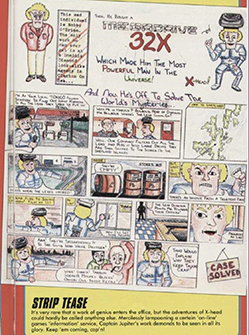
|
The feud began with MMS printing unflattering reader letters about Digi, accompanied by liberal amounts of insults aimed at their Teletext rivals from the MMS staff in reply. Most of this seemed to stem from Digitiser's criticism of Sega and some of their flagship games, at a time when Sega was in the process of using one of its severed legs to cut off the other.
Until this point Sega had been imperious in the home console market, and commanded a horde of young fans as yet lacking in critical thinking faculties, who weren't able to accept that Digitiser's views might be justified.
Digi always enjoyed stirring the pot, and so hit back in their pages with not inconsiderable glee.
The animosity reached boiling point when MMS printed a reader-drawn cartoon ridiculing the Digi team. Never ones to refuse a pointless fight if they found it funny, Digi stepped up the put-downs, and sent MMS a fax, attaching industry viewing figures as proof of how many readers they had. And to call MMS editor Steve Merrett a "fishback" with "biscuit skin" - which may have been more the motivation for the exercise.
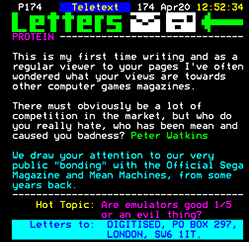
|
When this only succeeded in fanning the flames ever higher, it dawned on Digi that MMS appeared to be taking the feud far more seriously than they were. Digi were essentially trolling MMS for the hell of it – and the matter was put aside seemingly as quickly as it started, on their part at least.
Not that the Mean Machines camp could ever quite let things go entirely - they continued to make sly, bitter digs at Digitiser right up until the papery mag's eventual demise.
If you want to know all the salacious details of the feud, there's a special feature just for you, love.
Bizarre and (as far as we know) baseless insult faxed to Mean Machines Sega editor Steve Merrett by Digi, during the long-running feud between the two publications.
Digitiser was entirely free to read. As long as you don't count the purchase of a teletext TV. Or having to pay for a TV licence. This no-quid situation gave them somewhat of an advantage over their papery rivals, hence the ability to pull in 1.5 million readers every week. No wonder the EMAP mags couldn't stand Digi. A-ha-ha-ha. Ha.
Not exactly French as anyone would really recognise it, least of all the French themselves. A long-standing trope on Digitiser from early 1994 on was the imparting of the odd phrase of Digi's "unique" interpretation of French, following on from The Man's exploits in France in a series of his diary entries. Pompt-de-la-pompt de pompt-frite! A fake advert for a French phrase book was even pulled by a sub editor for no reason other than she incorrectly believed it was filled with hidden innuendo, and was too tired to proof read it and work out where the (non-existent) rudies were. Some examples of Digi's admirable Gallic language skills can be found in the Quote-o-page.
West London location of Teletext Ltd's offices, where editorial staff were based, including the Digitiser team before they worked from home. Fulham was quite some distance from Mr Biffo's Harrow abode, leading to interminably lengthy public transport journeys which prompted him to start sneaking out of the office early.
Magazine publisher that was very much in the pro-Digi camp (as opposed to EMAP and Paragon). A subscription to one of their various gaming titles was awarded as a prize to the winning letter of Digi's weekly Hot Topic.
Forerunner of Digitiser on the old Oracle teletext service (before Teletext Ltd. took over the broadcast franchise at the start of 1993). It wasn't very good, but without it there would quite possibly have been no Digitiser. You see, despite the fact that FX was just one single page of about six frames (sub-pages), it was the only thing like it on any of the terrestrial UK teletext services, so when its demise was announced its readers decided to inform Teletext Ltd. that they wanted something similar on their new service. Mr Hairs was tasked by Teletext with writing a similar single page of games coverage as part of the teens section, Generator - before Mr Biffo put forward a proposal for a full-blown games magazine instead, and lo, Digitiser was born.
Reactions to Digi from former FX readers varied, but came quickly in Digi's first couple of weeks, declaring how rubbish they were, and pining for the old section. Others took a more balanced view, but it wasn't long before FX, with its one review per day (of which Friday was "Sega Day" and Saturday "Nintendo Day"), was no longer missed thanks to the bountiful riches bestowed upon readers by the Digi team.

Gaming TV show that ran on Channel 4 from 1992 to 1998, and - as the UK's first programme dedicated to games - something of an institution. It was thanks to GamesMaster that we learned the true identity of Mr Biffo. He appeared as a reviewer in late 1993 and early 1994 as part of series three, saying how great the old Mega Drive and SNES game Zombies was, and that Teenage Mutant Ninja Turtles: Tournament Fighters was actually alright. He was, though, credited with his real name of Paul Rose, thereby revealing that he was the same person responsible for Teletext's Turner The Worm comic strips - and thus, his anonymity was gone. Annoyingly, they also managed to mis-spell 'Digitiser' with a 'z'.
Biffo was irritated at not having his Digi name used, especially given that fellow games journalist Radion Automatic was allowed to go by his ludicrous soap powder pseudonym. The upcoming appearance was announced to us on the Digitiser news page, with Biffo declaring that he had been severely edited down due to his continual references to Mr David Evil - Satan. In actual fact, the whole filming experience had been like pulling teeth for Biffo, who turned up at the studios to find that the producers had changed the games he'd be reviewing without telling him, and the ones he was expected to critique on camera, he'd never played before. Cue frantic play-testing of the still-in-development selection of titles the show had lined up for him...
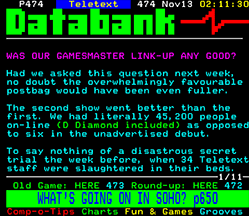
|
The next run-in that Digi had with GamesMaster came in series four. Bizarrely, this took the form of a sort of live chat forum, wherein during the programme viewers could bring up a specially-reserved Digi page on Teletext and see people making comments about what was going on in the show ("Keep the kids in the cage!" being one viewer's comment on the contestants being brought out to play a challenge). Messages were sent via a bulletin board service (an early type of online forum), which the Digi staff would then copy over to teletext, coming up on the TV as subtitles. The first time they tried this it wasn't advertised beforehand, meaning there were only about six people online, plus Digi themselves - who would make the odd comment such as "these are adverts", or the obligatory toilet reference.
The interactive subtitles went out live, and were quite funny, but the service didn't last long as Digi were reprimanded by Teletext bosses for the comments they were making on the programmes. The fact that the writers had to stay at the office until the show finished at 7pm didn't help, either - they didn't like having to do that, and I'm sure you wouldn't either. They did, however, receive a few comments from GamesMaster host Dominik "Double" Diamond himself during its run. Which was surprising, as he wasn't known to be a fan, once lazily describing Digi's humour as being too similar to that of Reeves & Mortimer.
Acclaimed writer and filmmaker behind the likes of 28 Days Later, Ex Machina and Devs. Arguably Digitiser's most famous celebrity fan.
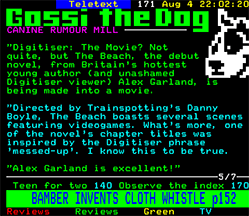
|
Garland won Digi's 1994 competition 'Digitiser = Filth' by photographing his friend holding a banner bearing the titular legend from atop a Thai temple; while the name of a chapter in his 1996 novel The Beach was inspired by the Digi catchphrase 'You have messed-up'.
Prior to the publication of The Beach, Garland was a journalist writing for The Independent. He contacted Mr Biffo in 1996 asking for an interview as part of a planned feature on Digi, which he described as "a phenomenon". Sadly, things went quiet immediately after and the feature never materialised due to the success of The Beach and Garland's career suddenly taking off.
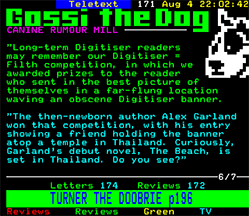
|
He remained a Digi fan, however, and wrote a moving and heartfelt tribute to the Teletext institution, which was aired on the day of its tenth anniversary, on 1 January 2003.
This was especially poignant given the recent victory over Teletext management following the Digigate humour cull of 2001/02.
When the curtain came down on Digi a short time later, Garland was one of the guests at Mr Biffo's leaving drinks in March 2003. The two remain friends to this day.
Writer of BBC Ceefax's games section during the late '90s/early 2000s, David Gibbon allegedly inspired the character of Insincere Dave. This cheeky nod wasn't just about being on rival teletext services – Gibbon's writing was renowned for its over-enthusiastic lack of critique, often resembling little more than rewritten press releases.
The relative accuracy of this suspicion is unknown, but it seemed plausible enough that it became a sort of online in-joke. So much so, in fact, that it led to Mr Biffo taking inspiration from Madonna's 2000 MTV Awards performance, wearing a sweatshirt emblazoned with Gibbon's name across it to his 2003 Digitiser leaving party.
To much amusement.
Much-derided 1992 Mega Drive platform game, and according to Mr Biffo, the first game that was ever reviewed for Digitiser. The review was never published, however, as it was part of the pre-launch 'as-live' dress rehearsals when Teletext writers were producing content as if the service had already launched.
Biffo has spoken of his relief that his review of the game never saw the light of day, peppered as it was with the most cringey surfer-speak. In reference to this, he reviewed the game again for the Digitiser 25th anniversary week on Digitiser2000.com.

Co-creator of Digitiser with Paul Rose, 'Mr Hairs' is the nom-de-Digi of writer Tim Moore.

|
Hired by Teletext Ltd. in 1992 as a freelance journalist with a broad brief, Moore was rescued from having to write make-up tips by being put on the nascent games section proposed by Rose.
The two quickly hit it off, with Moore helping to establish Digi's unique sense of humour and bringing writing experience to the setup, having already written for Melody Maker and a number of other publications.
Moore initially provided the section's PC reviews – which would often feature innuendo aimed at Biffo - but would also get stuck into writing the pithy, withering replies to letters, and a number of bizarre reveal-o-jokes.
Biffo and Hairs were an almost inseparable team in Digi's early years, inspiring and feeding off of each other, making each other laugh, and very much getting up to mischief in the Teletext offices – much to management's displeasure.
Sadly, Teletext did eventually manage to separate the duo in April 1996, when Moore was fired for running a news story about high-profile Sega Pro editor Dave Perry, which Perry took exception to and threatened legal action over.
To say Hairs left in acrimonious circumstances as a result wouldn't do it justice. An old-school journalistic bollocking was followed by Moore grabbing a cup of coffee and, with his jaundiced managers frozen in shock, emptying the whole thing over his computer and loudly announcing to the office "Bye, everyone! I've been fired!", before breaking his bike out of its rack and making his panicking former bosses think he was about to vandalise their cars.

|
He had the last laugh, however, going on to be an award-winning travel writer. Moore's first book, Frost On My Moustache – the proposal for which was accepted by a publisher quickly after his firing from Teletext – includes a number of acerbic mentions of Teletext Ltd. (which is described as "repellent") and its managers.
While travelling across the Arctic for the book, he sent a postcard back to Teletext addressed to the loathed Deputy Features Editor who had so gleefully dismissed him. The postcard depicted the bloody aftermath of a polar bear attacking a seal, to which Moore had added the immortal words "Wish you were here".
Having enjoyed working together so much, Hairs and Biffo began writing scripts as a means of continuing their writing partnership after Moore's firing. Following some moderate early success, the two went solo once Moore's travel writing career took off and Rose managed to break into TV writing.
The two collaborated once again in 2007, though, with the BBC Three pilot Biffovision. A surreal and hilariously warped interpretation of a traditional Saturday morning kids show in the vein of televisual icons like 'Swap Shop' and 'Going Live', Biffovision was written by both Moore and Rose, and featured numerous references and call-backs to Digitiser jokes and characters.
Moore and Rose are still close friends, and while he stopped writing Digitiser in 1996, Hairs will often get involved in Biffo's Digi-related projects as a guest. This has included appearing as a panellist at Digifest in 2016, featuring in Digitiser The Show, and making an appearance onstage at Digitiser Live. In a reciprocal move, Moore seems to mention Rose at some point in many of his books.
Even with a successful career as a travel writer for more than 20 years under his svelte belt, Tim Moore will always be Mr Hairs, and will always be an important part of the Digitiser story.
A major factor in the origin of the Digitiser brand of humour. Mr. Biffo informed us that he used to read British comic Speed, which was full of exciting stories of derring-do in that late-seventies/early-eighties type way. Each issue would feature a story wherein the main protagonist would get up to all manner of "scrapes", which would be followed by a series of multiple choice questions on what had just been read.
One such quiz was along the lines of "what mode of transport did Johnny use? - A: Horse and cart, B: Bicycle, C: A handsome crab". Obviously this was a misprint, but it didn't stop the young Biffo from laughing like an idiot at the concept of a "handsome crab", and gifting him with the unique Digi mindset that fans everywhere know and love. Happy!
Shortly after Digi first went on air they began to receive letters from persons purporting to be in love with their mascot, The Man With A Long Chin.
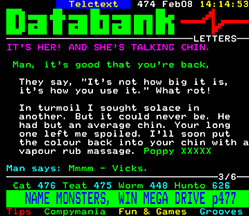
|
The first of which dubbed herself "The Girl With The Golden Game Boy", and you could be sure of seeing at least one of her letters every week, detailing her feelings for The Man and her desire to rub Vaseline on his chin. She appeared to be his favourite judging by the spluttering spiel he would emit in reply. Another that followed her was "Fruitbat, Miss", but the most notorious of all were the perfume-soaked letters from she that signed her name "Poppy XXX".
Although this was intended as "three kisses" it would become more appropriate later on, when her letters first had to be censored, before becoming completely unbroadcastable due to the nature of their content.
Presumably the centre of all Puffy Jacket activity in the entire universe, being the location where Mr Biffo was once told to "watch the sneaks, man" by a puffer in McDonalds. It's the long-time home of Biffo, and from where Digitiser was written after he became a freelance contractor for Teletext in 1996. The various Digitiser Live events also took place in nearby Hatch End.
Teletext's first editor, a charismatic old-school Fleet Street journalist who was well-liked by his staff. Holme hired Mr Biffo and gave the green light to Digitiser following his proposal for a full games section, rather than the single page in the teens section (being written by Mr Hairs) that was currently planned.
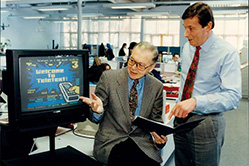
|
The launch of Teletext was a rocky one, however, with its output being criticised by the regulator. Editorial changes were made as a result, and Holme was forced out in mid-1993 under less than amicable circumstances.
A keen supporter of Digitiser and its writers – he was always interested, and even agreed for the team to spend time out of the office reviewing arcade games – his departure and the way it was handled hit the team hard. Until his departure, the Digi fellers had felt well-supported and valued by the management team – now that had changed, ushering in a new era where they were seen as troublemakers that needed to be watched closely.
Something that became very clear about Digitiser from early on in its life was that they weren't prepared to pull any punches in reviews: if a game was dire, they would say so. But this was not just restricted to shovelware and lazy film tie-ins - marquee games, if they came to the UK market broken and unfinished (as with Streets Of Rage III), or rushed and too short (Sonic 3), they wouldn't hold back from giving them the full criticism they deserved. When CVG was giving Rise Of The Robots scores of +90%, Digi were decrying just how risible and insultingly poor it actually was in reality.
This was jarring at first to readers used to other magazines' over-scoring and tendency to bend to the whims of PR goons if the threat of ad revenue being pulled reared its ugly head. But soon, this frank approach came to be at first appreciated, and then loved. Digi were not hard task masters for the sake of it - they simply cared about upholding standards. As a punter, you knew that whatever they said about a game, it could be trusted. And that was worth its weight in gold - or at the very least, about £59.99.
Each week, Digi would invite letters from readers on the subject of a particular contemporary gaming issue, with winners being awarded the prize of a year's subscription to one of Future's magazines. Usually this would go to the "best" letter on the subject, although once it was given to a letter which simply read: "And I would've gotten away with it, too, if it hadn't have been for you pesky kids!" - you know - the ending to every episode of Scooby Doo ever. Of course, it helped that most of the other entries were less than inspired that week, and underlines Digi's all-pervading sense of mischief in how they ran things.
Digitiser stood out a mile from other Teletext sections thanks to its unique, surreal humour. Given that Teletext was much lighter and more conversational in style than the BBC's dull, dry Ceefax service, this should go some way to showing how much of an outlier Digi was compared to other material being published at the time. It didn't take long for the writers' idiosyncratic humour to assert itself - after finding their feet for the first few weeks, characters soon started appearing, strange forms of language began creeping into editorial copy, and the general sense of "other"-ness began to surface.
By 1994, they were well away, and by 1995 there was no stopping them: fake adverts, ridiculous celebrity portraits, reveal-o-jokes, warped characters, and all sorts of meta sending-up of the concept of a games magazine were taking place. Naturally, this alienated many of the more straight-laced and uncomprehending of readers, but to those who got it - oftentimes "it" being that there was no "it" to "get", stupid things were just stupid and that was that - this place, and the people that wrote it, were national treasures. This obscure, hidden world with its running jokes, tropes, and insanity was mana from heaven for teens looking for something that was theirs. This is one of the many reasons why Digitiser inspired such passionate devotion in its fans: there was nothing like it anywhere else.
And there never will be again.
Short-lived Hasbro gaming high score service. Hyperscore cartridges were briefly available in 1995 for the Mega Drive and SNES, which would plug directly into the consoles, with a game cart connected to the top of the Hyperscore unit. The player could then record their high score in the game and use the Hyperscore cart's modem-style built-in speaker to transmit data down a phone line to the service's number. A national chart of high scores was then displayed on Teletext page 438, with prizes for the weekly winners of jackets, T-shirts, and 'game gloves'.
Digi trailed the service, and gave 25 pre-release units away in a September 1995 competition. Both Mr Biffo and Mr Hairs made plenty of appearances at the top of the high score league for various games, as did other '90s gaming journalists Violet Berlin, Andy Crane, and Radion Automatic. Mr Biffo has since claimed to have known nothing about these chart placings, suggesting the Teletext marketing department had a hand in their creation.
In fact, few of the chart placings appeared to be taken by regular players, as most of the carts made it into the hands of the gaming press thanks to Hasbro's PR department.
Given that Hasbro reportedly cancelled the official October launch of the Hyperscore carts, it's not surprising that the leagues weren't updated very often. Other than the 25 given away by Digi, some units apparently made it to sale unofficially via independent retailers - though purchasers often had trouble getting the system to work, with their scores failing to be recorded. The league and phone service was still active on 21 November 1995, but had been shelved by 8 December.
Hyperscore seems to have been taken seriously by Hasbro until very late in its release cycle, given the coverage that it also received in the pages of Mean Machines Sega (see below).


Having one of Teletext Ltd's in-house graphic designers on the writing staff of Digitiser was a secret weapon in many ways over the years, with bizarre characters and graphics able to fill its pages at Mr Biffo's whim. He also turned his blocky art style to redesigning the magazine's main index page on a mostly-annual basis, introducing a series of iconic looks. In a 2019 online poll by this site, the 1995 Digi menu was voted the fans' favourite, followed closely by the 1996 'cyber-ape' design.
Of course, Mr Biffo's aforementioned whims were also a factor, and playful changes and adaptations were added on an infrequent basis. These ranged from the inclusion of Doctor Who characters, or giving the Digitiser masthead a snow-covered theme at Christmas, to renaming the section "Fishitiser" the day they reviewed James Pond 3, and the wholesale April Fool "Gamma 7" fake relaunch horror.
When Digitiser started, the writers took the unusual stance for a games mag of not talking about games very much. Obviously there would be the obligatory news and reviews, except that they were padded out by a large amount of surreal, very funny, yet highly irrelevant and nonsensical material.
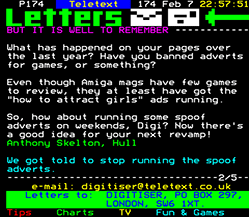
|
Incongruous items such as the fake adverts, absurd star profiles, warped celebrity "pin-ups", the presence of the Comic Trolley, and many excursions permitted the characters all helped both enchant and alienate readers. This was, of course, one of the reasons for EMAP's papery mags being so hostile towards Digi around this time
Although in later years they toned-down the irrelevance somewhat, the fact that it was still there acted as a kind of filter - only certain people with a certain excellent sense of humour truly "got" Digi, while others would be infuriated at the strangeness. Mr Biffo found this hilarious, and if anything it only encouraged him further.
Digitiser started out being broadcast on ITV Teletext page 370, before being moved to Channel 4 for some inexplicable reason. This was only the start of many moves over the years, with the magazine being shunted around every so often. It never went back to ITV, though, which was a blessing if you were a school child during the '90s, as at least it meant that you could listen to The Big Breakfast instead of the dreary GMTV while reading Digi and eating your cornflakes.

Stuart N Hardy, arguably Digi's most famous and un-self-aware of correspondents, was so abject a letter-writer that he earned the nickname King Of The Mess-ups from Digi after one particularly point-missing effort. Hardy took great pleasure in continually writing in with the most appalling drivel, entering virtually every Hot Topic over the course of Digi's decade on air. He was never once disheartened or dissuaded from writing, despite the constant put-downs he would receive to every mess-up-strewn dispatch from his Sheffield desk.
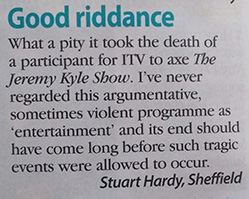
|
A serial letter-writer, Hardy was notorious for writing to almost every notable UK publication during the '90s, despite never once having anything of interest to say to any of them. His motivation in this seemed to be the pursuit of freebies, which would explain his incessant Hot Topic efforts, when a subscription to a Future-published magazine was up for grabs. He was known to do the same to Amiga Power before it folded, with exactly the same results.
Such was his legend and reputation that he even inspired a website dedicated to tracking his appearances. Happily, he was still at it decades later, having been spotted writing to a local paper with his thoughts on the cancellation of the Jeremy Kyle Show.
May his inkwell never dry.
Originally characters that Mr Biffo doodled in his school exercise books, and later a series of comic strips he produced for Bubblegun.com, in 2001 the misanthropic chicken and his spouse got the TV treatment. A Channel 4 Comedy Lab cartoon pilot was produced featuring such legendary talent as Monty Python's Terry Jones, Jessica Heinz (then Stevenson), and Kevin Eldon. It was notable for getting the expression 'moc-moc-a-moc!' onto TV, but the show sadly never quite hit the heights of the comic strip, and Biffo has since stated his disappointment with how it turned out. Still, though: a significant piece of Digi history and something to be proud of. The full pilot is available to watch now.

Mr Biffo worked at the bookmakers' London HQ as his first job, starting while still in college. It was here that Biffo honed his renowned teletext graphics skills, working on the firm's Oracle teletext pages, and creating graphics for the displays in the firm's betting shops using its bespoke systems. These were more advanced than the teletext standards that were available at the time, and enabled him to produce multi-screen animations, including ones starring a character that would later inspire Turner The Worm.
One of the things that has always enchanted and perplexed equal numbers of readers about Digi, was the unorthodox manner in which they would pepper their scrawlings with various punctuation marks, unusual use of language, and strange combinations of words that seemingly had no business being next to each other.
The repetition of words, use of full stops, colons, brackets and equals signs in unexpected places in a sentence may not sound like The Funniest Thing Ever, but it set Digi apart from other mags, and caused severe laughter-induced haemorrhaging of the gut in the excellent people that found it funny. Examples include the Old Game: Here feature, Digitiser = Filth competition, and ending a paragraph with the striking legend: "And!" followed by nothing else. These things gave Digitiser readers a shared language, and you could almost see neural pathways being rewired by exposure to it in real time.
It could be said that this, along with other early examples of Digi's intention to fly in the face of conventional games journalism, contributed to the hostility they faced not only from some perplexed and irritated readers, but also from EMAP's mags. This would later boil over in the form of The Great War between Digi and the Sega Magazine/Mean Machines axis, seeming to prove that it wasn't just a lot of Digi's correspondents that lacked a sense of humour.
In the summer of 1993 the Digi writers were challenged by the team behind Maverick's Super Control magazine to a face-off, where each camp would compete in a series of tasks. "The 1993 Digitiser/Super Control Lard Challenge" involved such things as the Digi fellas having to "do" a table, visit a pub and drink a pint at lunchtime (the pub in question being The Lung & Monkey), and pose as Randall & Hopkirk (Deceased). For their part, the Super Control challengers had to touch a policeman, and tune three televisions in a shop window to The Man With A Long Chin's teletext page. The contest was adjudicated by DIY "Kelly", who declared the challenge to have ended in a 47-all draw. Highlights of the filthy shenanigans are below, while full details of the whole sordid affair can be found on the Super Control collaboration page under issue 6.
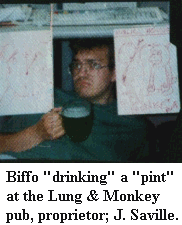

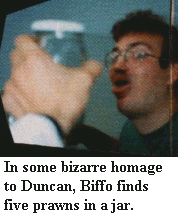
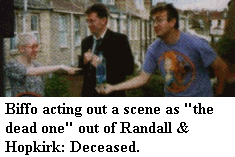
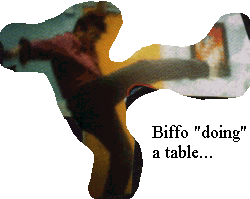
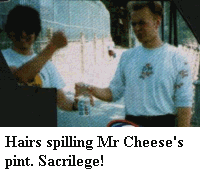
In Digi's early days, there was a known line over which you did not cross: you would never write a letter that was more than 60 words in length. Failure to disregard this rule resulted in many a slap from Digi, but the best thing that came from it was the little messages informing you of what would happen to any letter over this limit. From August 1993 until 1995, we were coldly notified that "letters over 60 words will be 'shot'", "letters over 60 words will be 'flogged'", "letters over 60 words will be 'stupid'" and "letters over 60 words will be 'burnt'". This prompted a reader to send a "Letters Over 60 Words Will Be..." chart in to Auntie Chapman's readers charts page. Thanks to the miracle of teletext recovery, we now know that letters over 60 words will be: "razed", "noticed", "safe", "reeled", "damp", "flumed", "tailed", "carved", "stripey", "jowled", "tilled", "spent", "deviled", "handled", "bundled", "swung", "skinned", "kittens", "ankles", "rigged", "poison", "vixen", "vermin", "tarted", "siphons", "rumpus", "loomed", "wine", "beard", "hasped", and of course many, many more.
The period 28 October to 3 November 1996 came to be referred to by Digitiser fans as the "Lost Weekend" (even though it spanned a whole week), as no new material appeared during this time, ahead of Digi's upcoming "Phase 2" relaunch.
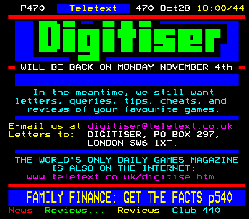
|
Fans speculated that it involved a lot of alcohol, and Digi were keen to keep up the guessing game, requesting that people write in to tell them what we thought they were doing.
In reality, the week of no updates was down to Mr Biffo officially taking sole responsibility for Digitiser following Mr Hairs' less than amicable departure from Teletext in April. Biffo was also becoming a freelancer, rather than being directly employed by Teletext, and the week-long hiatus was the time it took for his homeworking setup to get off the ground.
Not quite as scandalous as many would have liked, but then you try going on a week-long gin binge and then producing Digi's golden age of the late '90s/early 2000s.
The most notoriously opinionated and hornets' nest-kicking of Digitiser's early correspondents, the committed console-baiting demagogue Danny Boyd, hailed from Luton. Thus he signed his letters: "Danny Boyd, Luton Area". Or at least, he would have done if were real. It transpired in the late '90s that Boyd was in fact the only letter writer that Digi made up, doing so as a device to stoke up the odd furore that would keep the letters page stuffed with responses from scandalised readers for weeks thereafter. Years later, the character made a cheeky appearance in one of Mr Biffo's TV scripts, complete with reference to him being from the Luton area.

When Digitiser introduced their mascot, The Man With A Long Chin, in January 1993, they were at first unsure of how to use him. Digi's nascent humour began asserting itself before they'd even been on air for a month, and so the team decided that their figurehead would provide an effective outlet for their early "all-stupid" ramblings.
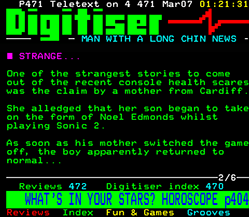
|
The Man was given a weekend spoof gaming news page dubbed 'Man With A Long Chin News', which provided a round-up of all the surreal and whimsical made-up news of the week. This would invariably cover sightings of tigers at game shows giving attendees Chinese burns, strange bird-related peripherals due for release, and reports of legal action being threatened over mistaking consoles for marauding Visigoths.
One edition, which went out in March, included the claim that a young Mega Drive owner began transforming into Noel Edmonds every time he played Sonic 2, before returning to normal when the game was switched off. With impeccable timing, the story was due to run the weekend after Digi had fallen foul of the tabloid hacks of The Sun, prompting Teletext's cautious features editor to go through every line of copy planned for broadcast that weekend with Mr Biffo.
Upon seeing the Edmonds story, she sincerely asked Mr Biffo if it was true. "It's just stupid", he told her. "So it's like satire?", she replied. Flummoxed by this, Biffo paused and told her "I suppose…", which seemed to satisfy her and the feature was passed for broadcast.
Eat your heart out, Armando Iannucci.
Prog rock ensemble once fronted by a gentleman named 'Fish'. Famously Mr Biffo's favourite band, who even launched a podcast dedicated to the band in 2020. The odd reference to them has crept into Biffo's writing every now and then over the years, which prompted VideoGaiden to soundtrack their 'time capsule' tribute to Digitiser with the band's 1985 top 10 hit 'Lavender'.
March 10, when abbreviated, looks like it reads 'Mario' – and as such this date has become an annual celebration of Nintendo's mascot, a day that the gaming community observes in increasingly large numbers.
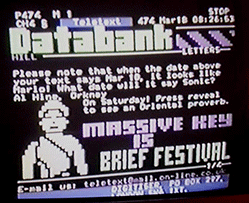
|
What many may not realise, however, is that potentially the first time the March 10/Mario connection was noted was in the pages of Digitiser in 1996. Reader Al Hine wrote in commenting that the date at the top of the Teletext screen had displayed 'Mar10' a few days before, and wondered when it would say 'Sonic'. Typically of Digi, this was brushed aside with the glib reply of 'Saturday'. Which would in fact have been 'Mar23 Day'.
This is likely to have been the first recorded use of Mario/Mar10 in 'print'.
The Man With A Long Chin – later shortened simply to 'The Man' – is Digitiser's longstanding mascot. Inspired by the mascots of other games mags of the era, The Man was originally conceived as a means to give away promo tat hanging around the office to viewers. Digi weren't prepared for his initial popularity, however, and he soon had so many fans that a daily diary was introduced - which, aside from during the 'Digigate' humour cull of 2001-02, ran until Digi's end in 2003.
Despite The Man's popularity in the early days, as time went on he became more of a divisive figure, leading Digi to poll their readers on two occasions as to whether he should be retired. His fans were passionate in their support, winning both votes comprehensively, which allowed his tenure as Digi's figurehead to continue. The Man was even revived for a period when Mr Biffo returned in 2014 with Digitiser 2000.
Publishing house owned by Hugh Gollner, Maverick counted Super Control and Mega Drive Advanced Gaming among its stable of titles. These two magazines of the 16-BIT console era (covering Nintendo and Sega respectively) featured a number of Digi collaborations throughout 1993 and early 1994, including Man With A Long Chin comic strips.
Digitiser's bête noire throughout the mid-1990s - or more specifically, Mean Machines Sega. The EMAP-published magazine was involved in a long-running, bad-tempered feud with Digi, and there was very little love lost between the two camps for some years.
Maverick-published UK Sega magazine. Printed a number of Digitiser comic strips between late 1993 and early 1994, following a few months behind Nintendo stablemate Super Control first doing the same. Resolute proof that not all Sega journalists hated Digitiser – just those that worked for EMAP.
Former editor of Mean Machines Sega, with whom Digitiser enjoyed a lengthy spell of jousting during his tenure in 1994 and 1995. The feud with MMS spilled over into the pages of both magazines, with MMS running a large viewer-drawn comic strip ridiculing Digitiser, and Digi memorably sending a fax in reply, taking a series of pot shots at Merrett (most notably the non-sequitur insults "biscuit-skin" and "fishback", which seemed to particularly rankle the MMS staff).
Merrett showed himself to be a good sport in later years, however, disavowing and distancing himself from much of Mean Machines' attacks, and reaching out to Mr Biffo on social media. The two have since buried the hatchet and are on good terms, finding the whole affair quite absurd in retrospect.
The first-ever competition run by Digi was to win a copy of Easy Amos, the game-creating package for the Amiga.

|
To do this it was your task to compose a limerick which had to include the words "amos" and "milk". The competition was won by a pre-Digi Mr Cheese, with his entry chiming so well with the nascent Digitiser humour that he was offered a writing job, and joined the team reviewing Amiga games, and inputting the charts and that. See it now:
There was an old man in disguise,
Who sneaked up on a dog selling pies,
'You stupid old man!
You've stolen my van!
And splashed some warm milk in my eyes' "
The gist of many a ludicrously vapid argument from readers on the Digitiser letters page over the years, defensively masking their feelings of inadequacy at the possibility they had made the wrong choice of hardware. These banal and totally transparent protestations began with Mega Drive vs SNES, continued through Saturn vs PlayStation, and ended with Xbox vs PlayStation 2. No generation of systems seemed to be immune. Even Jaguar and 3DO owners got involved - which probably tells you all you need to know about the fragile egos of some games fans.
The immortal catchphrase that has become the calling card of Digitiser. This excellent phrase was emitted by an unending parade of Digi reveal-ohs, and in many ways is the modern equivalent of "nubbynubbynub". It originated when a reader made a request for a reveal-o-swan, which at that point hadn't been seen on the pages of Digi for some years. But what appeared seemed to be a mutant swan on steroids - crying the blood-curdling legend of "Moc-moc-a-moc!". Following this, people challenged Digi to "draw" various things, such as happiness and a Secret Lemonade Drinker ("Ich liebe dich, lemonaden!"), amongst other things. All of which blurted out the battle cry that everyone loves!
Since his return to the Digitiser homestead in 2014, Mr Biffo has revealed that the phrase originated in the cartoons he drew as a teenager. The trademark exclamation was born out of the melding of a character named Moke, who was a Coke can with spindly limbs, with another that used to say "Cap-a-cap-a!".
When Digitiser The Show launched in 2018, the phrase became a call-and-response chant ("Moc-moc!"/"A-moc!"), immortalising it for a whole new generation of fans.
Digi always seemed to be fascinated by our filthy cousins of the ape world, having made many comments as to how "great" or "excellent" they are. See this, beadle: "From a distance, monkeys are excellent: they look like little humans, going about their business doing funny stuff. But when you get up close to the monkeys, they're even more excellent!" Of course, you can hardly blame them for that. The reason for this is because monkeys are excellent!

Digi's Terry Thomas-alike arch villain The Man Who Taunts Fear lost his collection of monsters in early 1994, and required readers to help him recapture them. He did this by offering material goods as prizes - in a sort of "competition" - if readers could locate the escaped chimera, which were dotted about various Digitiser pages over the course of a few weeks. One of the creatures bore an uncanny resemblance to a lizard/Jim Morrison hybrid, which is good joke, yes? Yes.
Many years later, Mr Biffo would undertake a monster-hunting expedition of his own, journeying to Guyana in pursuit of mythical beasts. He described this incredible adventure on his YouTube channel in 2020: part 1, part 2.
Iconic British comedy group. The glue that formed the friendships of scores of geeky students, and the ultimate source to where Digitiser's humour can be traced back.
Biffo has spoken of its undoubted influence on his sense of humour and comic style – more so than the likes of Reeves & Mortimer, who he considered to be contemporaries scoffing from the same laugh-o-trough, rather than a direct inspiration for his work.
Python members Michael Palin and Terry Jones were themselves loosely connected to Digi. Palin by dint of his 1989 Around The World In 80 Days TV show displaying Biffo's animated graphic of a Python-style foot squashing betting odds; while Terry Jones provided the voice for Knife in the Channel 4 cartoon pilot of Knife & Wife, based on the comics Biffo published on his Bubblegun website.
Long-time editor of Edge magazine and one of Digitiser's original Panel 4 weekend columnists from the feature's launch in 1996. Brought in to run GameCentral, Teletext's replacement for Digi, after Mr Biffo left in 2003.
Not the morally dubious military "philosophy" that saw the world teeter on the brink of nuclear apocalypse for much of the second half of the 20th Century, but a sort of insurance policy that Digi kept in their back pocket. In case Teletext ever scrapped Digi, or if the writers were all sacked, Mr Biffo created a graphic of a spunking cock that was saved in his files ready to be deployed if they ever needed the nuclear option.
The plan was to add the unashamedly juvenile depiction of a male reproductive organ to the Teletext index page, which featured a large area of the display where graphics could be included. This would have meant that anyone pressing the 'text' button on their TV remote controls would have immediately been greeted with the image of a luridly proud cock and balls.
This insurance policy was never used for this purpose, despite the controversial sacking of Mr Hairs in 1996. It should also not be confused with The Real Turner The Worm Being Sick, which was an entirely original graphic created especially for Digi's final edition.
It was, however, used for a spot of "internal" "fun" after its creation. The image - which Mr Biffo describes as being "a particularly dribbly member" was sent to Teletext's music editor Dave Hunter via the company's own electronic network, with the happy pink phallus cheerfully declaring "Hi, Dave!" in a speech bubble.

A relic of the early days of the internet, newsgroups were forums for the discussion of virtually every topic under the sun, accessed with a mail "client" rather than over the web. Digi once announced that a search through a number of Amiga newsgroups revealed more instances of the word "Digitiser" than the word "Amiga". They did take things to heart so.
By early 1998 large parts of the Digitiser fanbase had internet access, and demand for a Digi web presence was growing. The proliferation of fansites (such as the one you're reading) filled the gaps that the official site, with its notable lack of the Digi characters and humour, was failing to provide. But there was nowhere for fans to gather for a yak-me-do, and so the campaign to create a Digitiser newsgroup began. There then followed torrents of bitter consternation over these efforts, which rumbled on to a frankly silly degree - a whole bad-tempered war took place in the governance group that oversaw the creation of UK newsgroups. Not least because nobody could agree on the name or taxonomy for the thing. Ultimately the gatekeepers were so hostile to the Digi cause that they stated they'd simply reject any requests out of spite.
Eventually a group was suddenly set-up under the name alt.digitiser while no one was looking. Biffo got kicked out of it once - they didn't believe he was who he said he was. Given the standard of discussions there over the years, that wasn't something to be particularly broken-hearted about.
From their very earliest days, Digi took great pleasure in calling people that wrote in nicknames relating tangentially to their actual ones. For instance, they called Anthony Skelton "Bones", Matt Gander "Non-shiny goose", and David O'Connor by the name of "Des", after that mainstay of cosy ITV "chat", Des O'Connor. Do you see?
Digi long sang the praises of old games of the '80s, declaring their love for the great-gameplay, no-graphics-to-speak-of titles of that era. On many occasions they told of their experiences in run-down seaside arcades, and with the patience-stretching Sinclair Spectrum. Hot Topics would ask what the best games of the time were; Old Game: Here would parade another relic each weekend; and the affection Digi had for these most retro of retro games was always apparent.
But: most of the games from the 8-bit home computer days were utter tripe - you have to remember that when you start to go all dewy-eyed and looking through rose-tinted spectoids. And to their credit, Digi always provided that balance in their commentary on these things - providing the smattering of moderation that modern retro gaming YouTubers often lack.
Strange phrase emitted by The Man in the early days of Digitiser, and later by the Digi writers themselves. Its meaning was never explained to us, but it was mostly honked at the end of one of The Man's more obscure ramblings or in a reply to one of his fawning "acolytes". Mr Biffo signed the Long Chin Of What You Fancy comic strips with the moniker "Nub", and can also be seen in the Digi Fellas' portrait wearing a T-shirt reading "Nub Club", so presumably it became something of an early trademark of his.
The Digitiser postbag was always full and bulging – they never struggled for letters. Of course, when you receive as much post as Digi did, it's not always letters you receive. In its early days, an anonymous reader sent the team nude Polaroid photos of his girlfriend in exchange for free games.
It's unclear how long this cosy arrangement lasted, but it made enough of an impression on Mr Biffo for him to give the nudie-supplier a shout-out in his acknowledgements come Digitiser's final edition.

A response that Digitiser has provoked in many readers (and even some non-readers) over the years, for a variety of different reasons. The Amiga saga, tabloid faux-moral indignation, accusations of anti-Sega bias, daring to declare that Zelda 64 wasn't the best game ever, and the sparring with the denizens of alt.digitiser (that they adorably dubbed "Flamefest2k"): all of these incidents scandalised different groups over the years. But no Digi-driven outrage was as unexpected and laughably pathetic as that which greeted the announcement that they were about to drop the Atari ST chart. Yes: in 1994. ST owners were clearly the Amiga-dullards of their day. Perhaps Amiga fans should have heeded this horrifying warning of what their fate would be if they continued their ways...

Like many other sections on the service, Digitiser was shunted around various page numbers over the course of its ten years on air. Most of these moves seemed fairly arbitrary – what was the point of going from page 170 to 670? – while at other times it was to bring it in line with wider editorial organising.
Digi started life being broadcast on ITV page 370, before quickly moving to Channel 4 page 470 on 28 February 1993. Channel 4 was Digitiser's home for the rest of its run.
It stayed on page 470 for some time, but moved again to page 170 in January 1997, then to page 670 on 10 August 1998.
It went to page 480 in October 1999, where it stayed until December 2002, at which point it settled into its final position of page 175, staying there until it ended on Teletext in March 2003 (Digitiser's successor, Game Central, took over from it on this same page number).
Panel 4 was a rotating smorgasbord of prominent games journalists. Weekends on Digitiser had played host to a guest columnist ever since Violet Berlin began contributing a weekly article in January 1994. After two years of this, she found providing a column every week to be too much, and so in May 1996 Panel 4 was born.
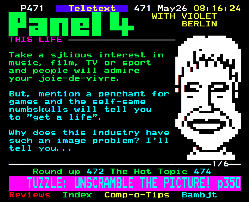 |
Three new writers were recruited to join Berlin in writing weekend columns, in a sort of round-Jeremy arrangement. The cycle would start with Berlin, who put Digi in touch with leading Amiga Power writer Stuart Campbell as another contributor, and the roster was completed with Edge editor Tony Mott and Loaded Online's Adam Porter (a friend of Mr Hairs).
Each contributor had their own style and themes they would discuss, some of which were fittingly idiosyncratic for the Digitiser pages. The pattern would stay the same through the rest of the feature's run, with each columnist handing over to the next in turn the following week.
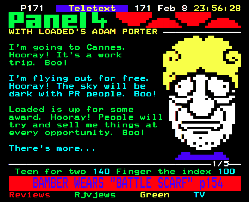 |
Initially the cycle went:
-Week 1: Violet Berlin
-Week 2: Stuart Campbell
-Week 3: Adam Porter
-Week 4: Tony Mott
At which point it would start over with Violet Berlin taking up the reins again.
After working well for around 18 months, the harmony of this setup was shattered when Adam Porter abruptly left the roster. The reasons for this have never been confirmed, only rumours - which include him asking for more money and being refused, or that Teletext sacked him after he turned in his column by pushing it through the door of the Teletext offices the day before it was meant to air.
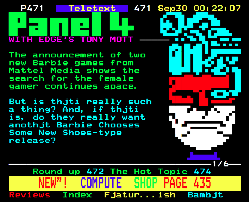 |
Or he didn't to want to do it anymore. We simply don't know.
But that's not as much fun.
Following Porter's departure, Teletext decided to replace him with their web manager and technology writer, Leslie Bunder. Bunder took up the same spot on the Panel 4 cycle, and the feature continued on as normal.
Except: Leslie Bunder didn't know anything about video games. And: Leslie Bunder didn't know how to write about video games. Also: Leslie Bunder didn't know how to write about video games for the Digitiser audience.
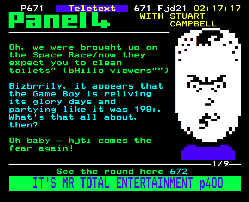 |
"Bunderman", as he was known, crashed and burnt in rapid and spectacular fashion. His contributions were dull and wide of the mark; he was derided as "Blunderman" by readers, and his turn in the Panel 4 rotate-o-show was met with a weary sigh.
Disquiet built among Digi's fans, and it wasn't long before this groundswell swallowed up the cheery balding techno-guy. His reign of terror lasted only a few months, ending in early 1998.
In his place came a reader-contributed column – Your Panel 4 – which continued in some form right until Digitiser's end in 2003. Hilariously, some in the Digi community were actually under the impression that they'd be paid for this work. Poor, deluded fools…
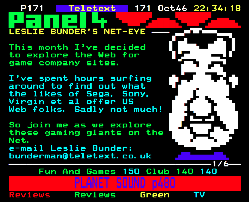 |
Panel 4 was eventually retired in October 2001, when all the columnists were told their services were no longer required by Teletext, as the dark ages of the Digigate saga took hold.
Upon learning of this, Stuart Campbell submitted a coruscating tirade against the management decision to strip Digitiser of its humour for his final column. Teletext refused to run it, of course, replacing it with - in his words - "a particularly dire reader effort".
And so, after five and a half years, Panel 4 sadly came to something of an ignominious end.
Every December Digitiser would run a Christmas pantomime, dubbed Pant-Oh, on their pages. These were usually a spin on your average well-known fairy tales, except that they tended to "star" washed-up actors that were strangely popular in their day, oddly named secondary cast members, as well as the ubiqoutous characters out of EastEnders.
One year it was actually set in Albert Square:
SCENE 2 - CAMERA PANS ACROSS THE SQUARE TO THE FOWLER HOME. CUT TO INSIDE OF THE HOUSEHOLD - ARTHUR FOWLER IS SAT AT THE TABLE WITH HIS SONS CHAKA, DEMUS, AND PLIERS. HE HAS SOMETHING RESEMBLING COPYDEX SMEARED AROUND HIS MOUTH.
P. Fowler: "Are you alright, Arthur?"
A. Fowler: "Christmas club: I... love it!"
It was always something to look forward to, and happily, since Digitiser's rebirth in 2014, we've been treated to plenty of new ones. The very first Pant-Oh in 1993 went by the name of Chinderella, which Mr Biffo, Mr Hairs and Mr Cheese apparently all sat round a computer writing together, and have described how they would frequently break down into uncontrollable laughter at what was unfolding by their hands.
You can probably imagine the kind of surreal shenanigans that ensued in each tale. But: you don't have to, because most of the classic Teletext-era Pant-Ohs are archived on this site. The 1994 edition was entitled Jack & The Bena-Mo after a typo which made the Digi team laugh so much that they decided to keep it in. The 1996 pant-oh is the last one still waiting to be found, and by a process of a elimination must surely be the EastEnders edition - cross everything that it's one day found.
The term used by Digitiser to refer to competitor magazines published in traditional, paper-based format, as opposed to electronically like themselves. Often employed as a means of making fun of their rivals – especially those magazines from the EMAP stable – or simply to differentiate Digi from them, alluding to its uniqueness and editorial honesty.
When the time came for Digitiser to end, Mr Biffo decided it was only right and proper to celebrate its lewd life with an equally lewd leaving party.
Ahead of Biffo's departure, the planets were aligning for a big end-of-the-road blow-out, which he announced on the Edge forums:
Let's love it while we can - and have a party! In fact... a Biffo/Digi leaving party? That sounds like a brilliant idea. Who's going to organise it? I'm frighteningly serious. Everyone's invited. Central London sometime before Christmas? It's a date.
Uncle Biffo"
Festivities took place a little later than he'd planned, on the Friday before the final ever Digitiser in March 2003 - before anyone had even heard of 'The Real Turner The Worm Being Sick', let alone witnessed his glutinous expulsion. The night itself was packed; testament to the love and admiration in which Digi and Biffo were held. A clutch of Edge forumites were present, along with Tim 'Mr Hairs' Moore, Gavin 'Mr Udders' Lambert, Alex Garland, Stuart Campbell, and a coterie of the Digi subs - who spoke proudly of how they'd decided to let the worm pass through to broadcast.
Super Page 58's Chris Bell was also in attendance, whose first-hand account of proceedings was swiftly written amid a severe "medium lager" hangover. Photos from the night have also emerged, unfortunately.
As is customary when writing about Dave Perry, before doing anything else we must refer to him as both "The Games Animal" and Not That One.
The video games scene of the early 1990s was dominated by journalists writing for games mags, particularly those that appeared on GamesMaster as reviewers or commentators.
Of these, Dave Perry – the man who singlehandedly kept the bandana industry going – was arguably the most prominent. Media-savvy and adept at self-promotion, Perry used his image and style to gain greater exposure, becoming a permanent GamesMaster co-host for series 3, alongside his magazine duties.
By the mid-'90s Perry had long-since moved out of editorial, and was managing Paragon Publishing's leading title, Sega Pro.
Around this time, Digi were engaged in print-based fisticuffs with a number of their rival magazines, and introduced a weekend feature where they 'reviewed' other magazines. In one column they described Perry's Sega Pro as 'mostly irrelevant', prompting its deputy editor to phone in a rage threatening legal action, and demanding a print-out of the page in question. Digi promptly changed the text to read 'mostly irreverent', printed the page, faxed it over to Paragon, and never heard anything about it again.
It was also Dave Perry who was inadvertently responsible for Mr Hairs leaving Digitiser and being sacked by Teletext Ltd.
Being at the helm of the flagship Paragon publication was a double-edged sword - in April 1996, Digitiser reported via Gossi The Dog's news whispers page that Perry had been scolded (not unlike a naughty pooch) by his bosses for the magazine's declining circulation figures.
Incensed by this, Perry immediately threatened to sue Teletext, denying the truth of the story. Mr Hairs, who had written the article and was the sole Digi writer at the time with Mr Biffo away on paternity leave, was summarily dismissed by Teletext bosses. He left there and then in a hail of thrown coffee, frogmarched by security to the bike rack outside.
Hairs planned to contest his dismissal at an employment tribunal, and asked Dave Perry if he'd appear as a witness in his favour. Perry agreed, admitting that the story had been true all along, and that he was prepared to say so in court.
As for Mr Biffo – who wrote Digitiser almost singlehandedly from then on, after the loss of Mr Hairs – he and Dave Perry never really had any contact with each other, aside from the odd occasion when Perry was working in PR for THQ. However, the two have since dispelled suspicions of any lingering bad feeling, and Perry made a cameo appearance in a 2017 episode of Mr Biffo's Found Footage.
They became sort-of-gaming-rivals once again in 2018, with both men producing their own retro gaming YouTube shows, in the form of Digitiser The Show and GamesAnimal TV. The first episode of Perry's GamesAnimal show did not fare well at the hands of the internet.
Digi being the sophisticated men of the world that they are, over the years many high-culture artistic studies of male reproductive apparatus appeared on their pages, disguised as characters and other things. Or, you know, just great big obvious spunking cocks.
The post-Mr Hairs Digitiser relaunch in late 1996 was trailed as "Phase 2" at Teletext's urging. This caused some tension between Hairs and Biffo at the time, though thankfully it was quickly put aside and didn't affect their friendship for long.
One of the many things that gave Digitiser its unique personality and feel were the odd, idiosyncratic phrases and language used within its pages. Here's a quick guide:
- - Do you see?: A check that the reader understands what Digi are saying/implying. Often comes after the use of irony, or references to "pop" culture
- - Lovely: To love you up
- - Love You Up: To be lovely
- - Mess-up: To commit an offence of gross stupidity in the presence of Digi: "You have messed-up"
- - Punching: Punching is invoked when a game does the smells
- - Smells: Something is a bit bad
- - Super x n: Where x is a noun and n a number (usually in double figures). Not some form of futuristic "space-talk", but a description of something or other. Usually employed to describe something in a review, Man Diary or a reply to a letter - it's the phrase that inspired the name of this site, man! "But we still think Sega should have called it Super Toy 47".
- - x-me-do: Where x is usually an adjective, this versatile phrase is mostly used to describe the goodness (or lack thereof) of something in a review. Like the above entry, it is also often used as an alternative name for an object, tangible or otherwise. "But hold, basket fans: it is also a skank-me-do".
Then, of course there is the use of the ubiquitous love, man, and dear, which are used to refer to an individual, most often in reply to a reader letter.
All-time favourite Digitiser character The Man's Daddy is a popular comedian, whose stand-up sets are legendary. Yes: The Man's Daddy is a funny guy!
Editor of Loaded Online and one of the original Panel 4 columnists. Porter lost his place in the line-up in late 1997, suffering the ignominy of losing his spot to Leslie Bunder of all people.
Digitiser co-creator Mr Hairs – now better known as award-winning travel writer Tim Moore – was sacked from Teletext in 1996 under dubious circumstances. He went on to (unsuccessfully) sue them for wrongful dismissal, in fact.
So incensed was he by his treatment by Teletext that during his travels around Iceland for his first book, Frost On My Moustache, Hairs sent a postcard back to his old employers.
A nice, no-hard-feelings gesture you might think. Except: this was no olive branch. The postcard, which depicted the gory aftermath of a polar bear attack on a seal, was addressed to 'evil' Deputy Features Editor Tamara Bowles and Deputy Editor David Staveley – the duo who had taken such delight in his firing – with a simple message written on the reverse.
It read: "Wish you were here".
When Frost On My Moustache was published, it included a passage in the acknowledgements section dedicated specifically to the vampiric pair: "Extra special thanks to Teletext, most particularly Tamara Bowles – an important Australian – and David Staveley: a big man, a brave man, and very much his own man".
Burn-me-do.
In one of the first of many controversial moments in Digitiser's life, a viewer wrote to Digi in September 1993 about their representation of short-lived EastEnders pub singer Danny Taurus - a character that spent the early part of that year attempting to 'woo' Pauline Fowler in the soap.

|
Known for his absurd wig, the Digi depiction of Taurus appeared regularly on The Man's diary page over a couple of weeks, with the drawing of his 'hair' becoming increasingly phallic every day.
The viewer drew a sketch of what they saw on screen – the face of Taurus, with a prominent protuberance of hair, and an arrow pointing to it with the immortal question: 'possible cock?'
Rumbled, Digi promptly shelved Danny Taurus.
Revolting dehydrated instant snack, inexplicably beloved of students and closely associated with '90s 'lad' culture.
Digi once ran a competition with a bunch of Pot Noodle 'hand spider' puppets as prizes. The fact they were completely unrelated to video games didn't seem to bother Digi – they did give away signed photos of ITV weathermen to all letter writers in their early days, after all – but they still tried to make a tenuous link by calling them "gaming gloves".
They also managed to describe Pot Noodle as "The found-down-the-back-of-the-fridge-style snack" in the process, which thoroughly incensed the Pot Noodle PR man. Such offence did he take that he was promptly on the phone to Digi, demanding of Biffo "Where did you get this information?". Whilst trying not to laugh down the phone at the whole absurd thing himself.
Public relations was a tricky area for Digi – or rather, dealing with PR people was. Their treatment both of and by games firm reps veered wildly from pleasant and amenable to outright hostile.
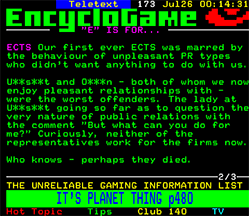
|
Sometimes the scorn they received had arguably been earnt by Mr Biffo and Mr Hairs for their rudeness/honesty about games in reviews - or the flippant/hilarious comments they'd make – while at others it seemed to be more personal.
The so-called "Teletext Effect" didn't help, either. Many PR folk assumed that as teletext was an antiquated, minor outpost of journalism, that Digi must therefore be a third-rate irrelevance by association. Atari point blank refused to believe that Digi had the seven-figure readership that they did. Often, those that made the mistake of wronging the team would find themselves the "butt" of "jokes", either on Digitiser's pages or with real-life prankery.
And sometimes even if the reps were nice to them.
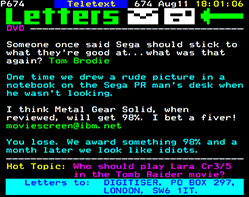
|
Digi found Sega Europe's Mark Maslowicz to be a genuinely decent chap, but while visiting the Sega offices, that didn't stop them from drawing a large penis inside a notepad on his desk while he was out of the room for five minutes.
Sega must have sighed every time Digi turned up. Their visits always seemed to coincide with the firm making some kind of gaffe that Biffo and Hairs would observe and gleefully write about via Gossi The Dog's news rumours.
This included overhearing what game Sega planned to bundle with its ill-fated 32X, with the company reportedly being left hilariously paranoid about how this news had leaked, and at Digi's refusal to name their "inside source". In fact, Biffo and Hairs were merely sat in reception while the Sega bods were discussing it in the lobby. The much-derided peripheral went on to be launched as a standalone piece of hardware, with no game included.
On another visit to Sega HQ, Digi witnessed staff playing Mario 64 on a pre-release Nintendo 64. They were anxiously asked not to report it - so, of course, they reported it.
Some PR reps had surprisingly thin skin considering the nature of their profession.
Steve Starvis from Eidos was apparently always unnerved by Digi, and at one trade show made a big deal out of asking what the team thought of his bag. This stemmed from Digi making a throwaway reference to him having "a girl's bag" in their report from the previous year's ECTS, and he was now determined that this wouldn't happen again by bringing a more "masculine" bag with him.
Another, Glen O'Connell, who worked for the newly-ascendent Sony, repeatedly ignored Digi's requests for a review copy of early PlayStation classic WipEout. The team became so desperate that they ran a news story out of frustration, bemoaning their treatment at the hands of Sony's rep, going as far as naming him with the now-immortal epithet "It's just bad PR, O'Connell". He was on the phone to them fuming about this in no time.
But it worked - Digi finally received a copy of WipEout from him as a result.
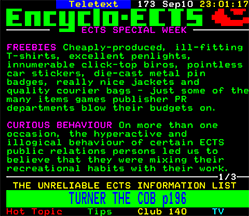
|
There were more than a few PR people who were even less forthcoming than O'Connell, and even more hostile towards Digi. One such joker never hid his contempt for them, so it was with some joy that at one trade show, the team turned up at his booth to find him absolutely coked off his nut, ranting and twitching, and treating Biffo and Hairs like his best friends.
Most of the time Digi found dealing with PR people challenging out of the simple fact that their pages couldn't be printed, and changed after only a day. The reps were unable to print good reviews and show them to their bosses, leading many of them to see Digi as an irrelevance.
Not all were like this, however – Ocean's Stephen Hey is described by Biffo as being "utterly charming", and the whole Digi team got to see Oasis play a homecoming gig at Manchester City's Maine Road stadium thanks to him. Simon Byron, now host of the One Life Left radio show, was appreciated by Biffo for always being honest about which of the games he was promoting were clearly awful.
He must have been in the wrong game.
Practical jokes were a mainstay of life in the early days of the Teletext office thanks to the Digitiser team and their ill behaviour.
It didn't take long for Mr Biffo and Mr Hairs to gain a reputation as troublemakers. While they were considered heroes early on for Digi's impressive ratings, management soon shifted to a regime that took a dim view of them.
The office antics of Biffo and Hairs were a clear factor – the duo loved getting up to all sorts of stupid tomfoolery and pranking of their colleagues. This behaviour did not go unnoticed.
Dirty plates were put in the internal mail and sent to other teams; colleagues were called over the phone only to be greeted with the digitised speech of Baloo the bear being played back to them from a game's sound menu; cherries were randomly pelted at walls, leaving stains for decades; cardboard boxes under desks were suddenly and violently attacked with tennis rackets; and there were regular who-can-swear-the-loudest-without-getting-in-trouble contests.
Mild-mannered colleagues were exasperated by all of this, loudly tutting but doing their best to ignore it in the case of Bamboozle editor Julian Edwards (with whom Biffo had previously worked at Ladbrokes); while the sports writers were unsurprisingly much louder in their disapproval.
Digi always made themselves a nuisance at industry parties, too. On one occasion the whole team took turns to violently kick a giant polystyrene 'N' that acted as the entrance to Nintendo's "Power Of N" party every time they went past, launching it out into the main area. They of course protested their innocence on each occasion, making out that it was always an accident.
There's even more to add to this list, but Biffo remains tight-lipped about it for fear of making people think badly of him.
It's hardly surprising that Digi introduced the long-running Ring-sir! phone pranks feature, all things considered. Biffo and Hairs found the prank calls so funny that they even took to doing them outside of work, on one occasion ordering a takeaway pizza using an online text-to-speech generator: "DON'T-HANG-UP. THIS-IS-MY-VOICE-BOX. I-WANT-A-PIZZA" etc.
They truly were the renegade masters.
Club that Digi readers could apply to join in early 1993, with The Man With A Long Chin's pet Duncan (a jar of prawns with a collective intelligence) as its figurehead. Prospective members would write in citing their credentials as potential recruits, only to be unfailingly dismissed by The Man as unsuitable.
Duncan, apparently, categorically did not want "unsteady fantasists" in his ranks. Please allow yourself a wry smirk to appreciate the irony of this: now.
Digitiser's predictions about the commercial success of new machines, and for the year ahead in general, were often uncannily accurate. They would set out how they thought the games market would develop at the start or end of every calendar year – sometimes even for 10 years in the future – and were also brutally honest in their views about the prospects for machines of the era.
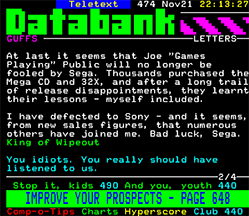
|
The writers could never be accused of sitting on the fence. The team often had strong opinions about burnings issues of the day, and thanks to their editorial independence, unlike many competitor magazines, they were never afraid of being blunt about what they really thought.
Mr Biffo in particular always had a gift for foresight, and being able to predict the way developments would pan out. His predictions were most accurate at the dawn of the so-called 'super console' era of the mid-'90s. He and Digi recognised early on how badly Atari had messed-up its ill-fated Jaguar console – in terms of technology, software support, and management incompetence – and often cautioned readers about investing in one.
Digi were similarly sceptical about the 3DO. While they were impressed by many of the games and had something of a soft-spot for it on the whole, they understood that its ludicrously unaffordable price point, coupled with its technical inferiority compared to the upcoming PlayStation and Saturn, meant that it never had a long-term future.
As for the PlayStation and Saturn, while they adopted more of a 'wait and see' approach before engaging their future-o-vision - initially stating that the two machines offered the best prospects for games fans wanting to step into the 32-bit era - Digi knew that Sega were not the force they once were following the 32X debacle. They had, of course, warned readers against buying the stillborn peripheral at the time of its launch, and voiced their (correct) suspicions that Sega was off its game leading into the next-generation console war.
They also noted Sony's aggressive targeting of the older 18-25 demographic at a point when 'lad culture' was becoming more prevalent. This, along with a technically superior machine and more third-party support, meant they soon realised that the PS was going to be the winner of this particular battle, and didn't shy away from saying as much – much to the annoyance of Sega fans, many of whom already believed that Digitiser was biased against the company.
Of course, this view among Sega fans wasn't helped by Digitiser's coverage of the company's final console, the Dreamcast. Digi's desire for the machine to succeed was palpable throughout its previews and initial coverage – they could see that Sega had seemingly learnt from its mistakes, and were approaching its apparently last throw of the dice with an intelligent plan.
Contrary to what the zealots may have believed, Digi didn't hate Sega and had wanted the Dreamcast to be a success for the ailing games giant. But they weren't idiots, and could see what was happening.
Much of their writing about the DC seemed to be surrounded in an almost wistful sadness – many of the games were good and that the DC was a fine machine – but that it wasn't enough. They could see that Sega wouldn't be able to cut through to the PlayStation-loving public, and were therefore resigned about the future of both the console and company early into its UK release.
Sega had blown its cash reserves following expensive follies in the form of the 32X and Mega-CD, and the Saturn's complete failure against the PlayStation. The writing was on the wall for anyone who wished to read it, leading to Digi again calling it correctly – they observed that the DC was intended to scupper the still 18 months-away PlayStation 2, but that the market had hardened against Sega to such an extent that the machine would effectively be an irrelevance by the time Sony's record-breaking follow-up came around.
It gave Digi no pleasure when this prediction came true, but the fate of Sega and the Dreamcast was so clear to see that it had almost unfolded in slow motion.
If the Sega zealots were blind to the company's missteps, then by comparison when it came to their machine's prospects, Amiga owners had had their eyes removed, locked them in a box marked "PCs suck", and thrown it down a mine. And then farted on the mine.
Digitiser's relationship with Amiga owners is legendary. On its very first day on air, the omission of the format from Digi's explanation of their coverage caused such anger that the Teletext switchboards were overloaded with calls from rabid Amiga owners demanding that the Digi writers be fired.
In later years we discovered that the editorial decision not to include the computer in their coverage was more due to none of the team owning one than anything else, but part of this was down to knowing which way the wind was blowing. Even at the beginning of 1993, the Digi team could see that the PC was starting to move into the ascendancy, and the Amiga's fortunes were showing signs of waning.
While Digi reluctantly bowed to reader pressure and began covering the format, they were still well aware that the Amiga's days were numbered. They always gave an honest assessment of the format's future prospects, especially in buyer's guides, and even more so when the extent of Commodore's financial troubles became apparent.
By the time the Amiga was acquired by Escom, Digi knew it was a busted flush, and said as much. The die-hards held on until the late '90s, but Digi could always see that it was no longer relevant, and of no significant interest to anyone outside a small, specialist community.
The corporate buy-out that was trumpeted by Amiga owners as proof that their system would live again was treated with more than a little scepticism by Digitiser. In response to one reader opining that "Something IS happening" regarding the release of a handful of new games, Digi replied "You could say the same thing about rigor mortis". They hadn't so much seen its demise coming, as measured it up for its coffin on 1 January 1993.
On the whole, Digitiser's powers of foresight have shown them to be right more times than they've been wrong – but they've never engaged in triumphalism, or delighted in being correct about the failure of a system.
Except for the Amiga. They quite enjoyed that dying. But that was only because its owners were so – so – annoying.
Digitiser never really received much support from Teletext and had to do most things pretty much for themselves. This extended to promoting the new section when it launched - the marketing department weren't interested, so Mr Biffo and Mr Hairs drafted their own press release and sent it off to all the biggest print games mags of the era. Most of them ignored it of course, but it was picked up by Mean Machines Sega - who, in a foreshadowing of future events completely missed an obvious joke and poked fun at Digi instead - and the Dave Perry-edited Sega Pro, who gave it much nicer treatment. Which was ironic, considering how much of a thorn in Digi's side Dave Perry would later be.
Games journalism in the '90s was unrecognisable compared with today. Firms had deep pockets, and there was so much money sloshing around for promotional budgets that writers would be courted by games companies with ever-increasing excesses in an attempt to gain positive coverage.
Working for Teletext - once described by Biffo as "the scrag-end of journalism" - meant that the Digitiser team weren't just not taken seriously, but actively scorned by PR reps, and were about as outside the circle as it was possible to be.
Press trips were often hard to come by for Digi thanks to this industry sneering. Certainly in the first year on air they were few and far between, at a time when journos on print-based games mags were being lavished with overseas jaunts, expensive parties, and bars filled with illicit powders of questionable provenance (as alleged by GamesMaster host Dominik Diamond in this interview).
Digi's luck changed after gaining a high-profile fan in the form of Bad Influence presenter Violet Berlin. She did all she could to champion Digi with games firms, actively suggesting they be included and scoring them places on the kinds of national and international promo trips that they were previously barred from.
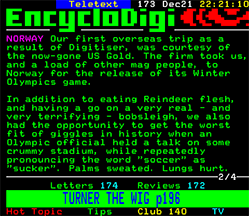
|
Having met at ECTS in September 1993 and subsequently becoming friends, Violet was able to pull some strings and have the Digi writers included on a trip to Norway, visiting the Lillehammer location of the 1994 Winter Olympics.
This chilly outing was paid for by US Gold, publishers of the tournament's mediocre tie-in game. The firm arranged for the team to have a go on the Olympic bobsleigh course, stand atop the ski jump, and go on a guided tour which had them laughing like drains when their guide repeatedly pronounced "soccer" as "sucker". Which prompted a swift telling-off from Violet.
Shortly after this trip Violet began writing a long-running weekend column for Digi, starting in late January 1994, cementing her firmly as part of the Digitiser story.
The gang were also given box seats at Manchester's Maine Road stadium to watch an Oasis gig, courtesy of Ocean, who always seemed to treat Digi well compared with other software companies.
But the most infamous of industry hospitality the Digi team ever experienced took place in the summer of 1994. Biffo, Hairs, and Violet were flown on an all-expenses paid trip to Los Angeles together for a tour of Virgin Interactive's studios, after having been personally invited by the hymen-having softies.
Things didn't get off to a great start, when – on arriving at the Virgin offices – the team were informed that the company had changed their minds and refused to show them their games after all. Digi and Violet were allowed to have a look round and interview games music producer Tommy Tallarico, but were told that any further promo work wasn't happening, and that the visiting trio "should enjoy LA".
So they very much did - for a whole week. Biffo subsequently got the worst sunburn of his life.
While they were in town, they visited Disneyland and Universal Studios – where they went on the E.T. ride and Mr Hairs told the automated entrance machine that his name was "Bollock", prompting the ride to end with E.T. croaking "Be good, Boll-ock!" at them.
The climax of the trip is best left to Biffo to describe in his own words:
On our final evening in our absurdly plush LA hotel, we'd taken slightly too much advantage of their free tequila hour (returning to the room a number of times, each time with several trays laden with tequila-filled tumblers). Following a fairly epic game of hide-and-seek, Tim and I decided to have a race around the hotel. For reasons that I can't recall, Violet had done our make-up, I was wearing a rubber Batman mask, and had no top on due to my sunburn. As Tim approached the finish line, I decided to rugby tackle him. He was so hungover the next day that he thought his broken ribs were stomach cramps brought on by the booze. I was so hungover that I blocked my hotel room toilet, and checked out having flooded the bathroom."
Extreme social misfits of the late 1990s. First observed by the Digi anthropologists in early 1997, this branch of the 'townie' species menaced arcades across the UK for a few years, before seemingly disappearing in the early 2000s.
Decked in oversized and unnecessarily puffy ski, Kappa, or 'puffa' jackets all year round, the Kiss FM-listening, street-talking young men (also sometimes referred to as 'puff-jaks') were surly, confrontational towards non-puffies, and extremely territorial around their favourite arcade cabinets.
They could also be found congregating in and around McDonalds, exclaiming "Aw, guy!" at each other, boasting about their achievements on Tekken, and pretending to talk into their Nokia mobile phones. These devices were always switched off, however, because they couldn't afford the bills.
Digi frequently spoke of the puffy jacket scourge – including recounting the time Mr Biffo was advised to "watch the sneaks, man" by one such specimen in a Harrow branch of McDonalds. Charts host Wired Child was also based on them, with his character embodying the most common traits of the typical puffy.
Nobody knows why the puffy jackets vanished. Perhaps they simply started wearing Burberry instead.

Digitiser was the most-read games magazine in the UK all throughout its ten years on Teletext.
When you're in the enviable position of being The World's Only Daily Games Mag™, broadcast on a free medium read by millions – even if it is an arcane service like teletext – chances are you're going to get a few readers. But nobody involved with Digitiser at its outset, either among the writing team or management, was prepared for just how engorged its viewership was going to be.
The first ratings to come in for Teletext Ltd.'s new service in early 1993 showed that Digi was already getting a strong showing – 600,000 a week – and their share of the pie only grew from there. So well was the section performing, in fact, that it was described by the deputy features editor as the "saviour of Teletext" (how times would change…), and the marketing department even looked to cash in on its popularity with a fan club, which sadly never launched.
By 1996 Digi was confidently billing itself as "The nation's most-read games mag" (as well as being better than "everything", "booze", and "mucky books") on the promo banners that ran across the bottom of the screen. It was even described by Alex Garland – then a journalist with The Independent newspaper – as a "phenomenon".
The team had got into an almighty row with Mean Machines Sega the previous year over the extent of their ratings – at that point MMS, as the UK's best-selling print magazine, had a circulation of 70,000 copies a month, far dwarfed by Digitiser's weekly figures. This rather touched a nerve with the MMS team, and they "vigorously" "disputed" Digi's claim.
Digi's ratings peaked in the late '90s at around 1.5 million readers per week – in May 1998 they had announced them to be 1.46 million "and rising", and they stayed well above 1 million for a number of years.
That was until October 2001. Digi's ratings were still an extremely impressive 1.2 million a week at this point, but then came the management-mandated cull of all Digitiser's humour, characters, and personality – ushering in the notorious year-long period known as 'Digigate'. Readers were shed at an alarming rate, sinking by 800,000 down to 400,000 per week. Still healthy by other standards, be it print or other teletext sections – but the lowest they had ever been for Digitiser, with viewers deserting the section in droves with the classic Digi charm seemingly gone forever. These figures were of course lower even than its initial rating on launch in 1993.
Things did pick up again following the end of Digigate in November 2002, prompted by management realising their mistake and asking Mr Biffo to return the humour and personality to Digitiser's pages - and especially for the final weeks of Digitiser's life in 2003. But many had already drifted away, and were unaware that the old Digi had been restored – mistakenly thinking Mr Biffo had left in 2001 and that was that.
Even so, enough people were present at the end to witness a legendary blow-out to bring the curtain down on the UK's most popular ever games mag.
Digitiser ended on Teletext, after more than 10 wonderfully lewd years, in March 2003. After this time, Mr Biffo continued to keep one foot in the gaming world while he was pursuing his script writing career, contributing monthly columns to Edge.
These articles came to an abrupt end in 2008, when he stepped away from being Mr Biffo altogether following some nasty business online, including having to deal with a stalker (for which the police were involved). For years, nothing was seen of him on the internet – Mr Biffo had effectively been retired, and Paul Rose continued with his career writing for TV and film without a second thought.
Eventually, however, Rose began to miss writing about games - working predominantly in kids TV, this wasn't offering the kind of outlet that he needed for his sense of humour. In late 2014, after being reminded of renowned knob Brad Burton - who was the inspiration for the Digitiser character Cyber-X - he was inspired to write a new piece imagining where Cyber-X was now, publishing it online as Mr Biffo. This was the first new Mr Biffo material since 2008.
An explosion of interest immediately followed, with "throngs" of people excited at Mr Biffo's apparent return. In the giddy whirl of the days that followed, Biffo decided to relaunch Digitiser as a blog – Digitiser2000.com – and brought with it his trademark humour and some of the favourite Digitiser characters.
From there, the momentum grew, until Digitiser2000 had spawned a YouTube channel, enabling Biffo to produce his own videos – gaining in ambition and eventually producing the likes of Mr Biffo's Found Footage and Digitiser The Show.
Biffo still works in TV as his main job, but Digitiser – now firmly back and very much in rude health once again – has been reborn. Its legacy is secure, with a whole new generation of fans who never even saw a teletext TV lining up to support Biffo's creativity.
The Digitiser postbag was always quiveringly fecund. The very first few letters pages of Digi's life featured entirely made-up correspondence, but after a few days on air genuine letters arrived by the sackful, and never subsided.
Over the years a number of regulars would grace the pages - some finding favour, while others were slapped down for their frequent mess-ups. A few of the major players over the years were:
- Boogie - the most prolific letter writer in all of Rhondda, and provider of many a readers' chart for Auntie Chapman to stroke
- Danny Boyd - the Luton area's most made-up letter writer, he was in fact Digi all along, being used as a device to stoke debate and indignation
- Dantendo - frequently prone to mess-ups, and a very strange individual: actually changed his name to Dantendo by deed poll, and after suffering an apparent breakdown, sent faeces-smeared letters to Digi and accused them of trying to read his mind
- Fruitbat (Miss) - early acolyte of The Man With A Long Chin
- Patrick Grady - the Inverness native's letters were always welcomed, and Digi seemingly missed him when he didn't write
- The Girl With The Golden Game Boy - superstar correspondent of Digi's early days, rarely failed to feature on the letters page announcing her love for The Man With A Long Chin
- Stuart N Hardy - Digi's most notorious regular, the King of the Mess-Ups himself - Hardy's reputation spread far and wide. A serial letter writer to scores of UK publications, his primary motivation was to win prizes, and over the course of nearly a decade he was never dissuaded by the constant abuse Digi fired at him in reply
- David O'Conner - like Hardy an Amiga fan from Sheffield, and also like Hardy, "Des" was very susceptible to mess-ups - though not nearly of the same magnitude
- Poppy - sent explicit love letters to The Man With A Long Chin drenched in perfume, and gained quite a fanclub in the process
- Scott Ross - one of the more coherent of Digi's regular correspondents, the Angus double-name wrote to Digi for many years
- Alex Seymour - a prolific correspondent and long-time Digi devotee, Seymour became known for signing off every letter with the words "That is all. I read you every day".
Teletext sections would often change their name and designs throughout their time on air, and Digi threatened to do the same on a number of occasions. Mostly these were empty threats prompted by boredom with the Digitiser name, but feeling that they were now so well-known that they weren't able to change it, they stayed as they were.
In 1995, a relaunch was threatened once again, heralded by a Hot Topic on the subject of what readers would like the new name to be. The winner? "IRON WRIST". Of course, this all came to nothing, until 1 April 1996, when the Gamma 7 incident took place (see April Fool), where Digi trolled readers who had become attached to their brand by renaming themselves something truly cringeworthy as a joke.
When Digi did eventually relaunch for real, the magazine retained its name and design, but expanded slightly. This "Phase 2" incarnation was prompted by Mr Biffo taking over the running of Digitiser solo following the infamous sacking of Mr Hairs by Teletext. The next time Digi would relaunch came in December 2002, where it was given a new red and blue colour scheme to fit in with Teletext's newly launched (and ill-advised) 'Sauce' section for 18-25 year-olds. Biffo was categorically not a fan.
Nostalgia-based video games magazine focusing on formats of the past. Featured a lovely big interview with both Mr Biffo and Mr Hairs in 2005, and Biffo has contributed monthly columns to the publication for some years now.
Digitiser arguably 'invented' retro gaming – or at the very least popularised it. As early as 1994 the Old Game: Here section espoused the joys and frustrations of memorable games from previous decades, drawn from Mr Biffo's wide knowledge and formative gaming experiences.
This nostalg-o-strand ran well into the 2000s, morphing into Your Game: Here – ostensibly to let Digi's readers contribute, and give the team less to write, although many editions of the feature were penned by the team under pseudonyms.
The use of the reveal button has long been a sacred part of the Digi idiom, an institution that they made their own like no other teletext section before or since. Pressing reveal on a teletext TV remote displays previously hidden text or graphics, and when used by Digitiser - primarily on the letters page - it would impart valuable words to the viewer, or treat them to the marvel of some startling images. It was so renowned that famous people popped up from time to time as reveal-ohs too, introducing us to Inspector Morse and his extended family, as well as other stars of stage and screen such as Mr T and the cast of EastEnders! Reveals were an intrinsic part of the Digitiser experience, and as such it's only right that they be collected together somewhere. Which they have been. So that's good.


|
Reversible Sedgewicks have a thousand uses, and they've directly affected the lives of every single one of us since the glorious day when they first arrived – it's now hard to imagine a world without them.
They made a fleeting appearance in the Paul Rose-written episode 'Sophie Ltd.' of Childrens ITV show My Parents Are Aliens. In the script, the miracle inventions are described as looking like coconuts on wheels with feathers and springs sticking out of the top - and that's exactly what the props team made.
Full packaging and advertising banners were also produced to accompany them, which are surely now considered collector's items.
Long-running fan-favourite weekend feature, where Digi - under the guise of host character Phoning Honey - would make prank phone calls to games shops and wind them right up.
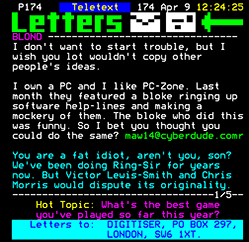
|
They were all real, and Biffo and Hairs enjoyed doing them so much that they even made prank calls together in their spare time. The final edition of Digi even featured an edition of Ring-Sir! where Biffo pranked the Teletext complaints line, registering his displeasure at all the rudies that it had printed on Digi in its final week on air.
Ring-Sir! began in 1994, but despite this Digi received letters from readers in 1998 complaining that they were copying Charlie Brooker, who had just started doing something similar for PC Zone magazine. Digi were of course forced to point out that - while the likes of Chris Morris and Victor Lewis-Smith would dispute its originality - Ring-Sir! did in fact predate Brooker's attempts by about four years.
In late 1993, the powers that be at Teletext Heights granted Digitiser the use of an extra page, assigning them 477 to do with as they saw fit.
This page was then used exclusively to host competitions, one of which was to win famous movie cyber-nark Robocop's very own smashed-up car from Robocop 3. This hot giveaway was in association with high street electronics chain Dixons, who produced a brochure detailing how to enter, namechecking Digi.
The car prize was genuine, and Mr Biffo and Mr Hairs had their photo taken with the eventual winner next to the silver dream machine, which had apparently been gutted for stunt purposes, and was barely roadworthy. Other prizes were available besides a fit-for-the-scrapheap ex-movie prop, and Digi and Dixons gave away a cavalcade of highly desirable swag for many weeks in the run-up to Christmas. Hold me down daddy, I'm shaking!

Digitiser had a complicated relationship with review scores. Not with the actual marks awarded to games (a thousand Sonic 3 fans beg to differ), but the marking system used to rate them itself.
At the beginning of its life, Digi used a marks out of five system, with similarly-scored sub-categories for graphics, sound, and gameplay. By May 1993, however, they'd switched to marks out of 10, and – clearly feeling pressure from readers to fall in line with conventional scoring – by July 1993 they were using percentages.
They carried on giving games a percentage mark for the rest of the '90s, although Mr Biffo, especially, was never particularly happy about it, writing on numerous occasions about the failings of the system. The argument against them hinged on two main points: how can it be possible to perceive a difference of 1% between games; and the over-marking that use of percentages naturally encouraged. A score of 70% is seen as poor and not worth investigating, but when taken as a mark out of 10, a score of seven should be considered as above average.
As a result, Digi made a point of awarding scores using the full gamut of the range – notoriously giving Bram Stoker's Dracula on the Game Boy 4%, and famously witheringly cussing Sonic 3 with 72% (a rating that sent shockwaves through the UK games scene that still reverberate today). The logic for both of these decisions was entirely sound – Sonic 3, because the game was fun but more of the same, and far too short and easy; and Dracula because it was so awful that nobody would buy it if they rated it at, say 40%, so they might as well make its awfulness crystal clear.
As the decade progressed and Mr Biffo took up the Digi helm more or less solo, editorial commentary about the failings of percentages as a scoring system became more and more common. At points, he threatened a change to Digi's approach that would involve not giving an overall rating at all, but letting the review do the talking, with the reader left to interpret the view of the game as positive or negative.
When change eventually did come it was nothing that drastic, however, instead seeing a return to marks out of 10 for the new millennium. That itself only lasted a year, though, with Digi reverting to marks out of five in January 2001 - the original system it had at its birth - before finally swapping back to marks out of 10 for the final few months of its teletext life, in January 2003.
The vagaries of the various scoring systems always provided plenty of material for debate on the Digi letters page over the years. So controversial were some of these decisions at the time – yes, really – that when Biffo returned with Digitiser2000 in 2014, review scores took on a more satirical tone, making fun of the very concept of rating systems themselves.
Each review would end with a ridiculous figure related to some obscure aspect of the game, which mocked the notion of overall scores while simultaneously kind of giving an idea of what Biffo's opinion of the game actually was, in an oblique sort of way. Ahhhhhh! Victor Lewis-Smith should be taking note. If he was still relevant.
In his life outside of Digitiser, Mr Biffo is a succesful, award-winning script-writer for TV and film. He has dozens of credits to his name, from Sooty, My Parents Are Aliens and - yes - EastEnders - in his early days, to the long-running and beloved CBBC shows Dani's House, 4 O'Clock Club, and Almost Never.
Biffo's script-writing career began during the Digitiser days, when he and Mr Hairs wrote a series of comedy radio plays as a way of being able to continue working together following Hairs' forced departure from Teletext. The two would reunite for 2007's Biffovision pilot for BBC Three, arguably the most Digitiser-y terrestrial TV show there has ever been.
The Digitiser team once had a NintendoScope light gun for use with the SNES. It was stored in a locked room at Teletext Ltd. HQ with Digi's other gaming hardware, and was conspicuously 'admired' by a Teletext security guard named Sean, before going missing in 'unexplained circumstances' shortly after. The whereabouts of the drainpipe-like light gun remains a mystery to this day.
On another occasion possibly inspired by this incident, the notorious Digitiser sub editors cut a line of text from a review which poked fun at security guards as being "too fat and stupid to get into the army", complaining that it was "grossly offensive to security guards". Despite the claim, being a security guard was not a protected characteristic under UK employment law at the time.
EMAP-published official Sega organ who very much disliked Digitiser, printing a string of negative missives from readers about them on their letters page. As the more straightlaced stablemate of Mean Machines, Sega Magazine didn't go in for the same kind of no holds-barred roasting of Digi that their sister title did, but they were still very much considered the enemy by Digi fans.
One of the more popular Sega-focused games magazines of the 1990s, published by Paragon and edited by Dave Perry. While there was very little love lost between Digi and Sega Pro in later years - Perry was effectively responsible for Mr Hairs' acrimonious dismissal - they did give the newborn teletext games section a full preview when it launched. Their write-up even included screenshots Digi had included with the press release they sent out, which were taken from the pre-launch dry run all Teletext editorial sections were being required to produce ready for the new service going live. Thanks to teletext recovery superhero Tim Bisley, these never before seen images have been restored from the Sega Pro article and can be read properly for the first time.
Infamous punchline to a Man's Daddy joke, excised by Digitiser's sub-editors in favour of a feeble replacement.
Inspired by this incident, it's become a catchall term for the idiocy of the Digi subs and their hapless, out of touch interventions. Shortened to SHAP, this quick reference easily helps to identify instances of this kind, such as the sub-editors changing the title of School Daze – a well-known, popular 1980s ZX Spectrum game – to "School Days".
There were many examples of SHAPs forced on Digi over the years, including objecting to a Digi character exclaiming "Happy foetus!" and insisting on this being changed. Mr Biffo's personal favourite was being told, when abbreviating Master System to MS, that "We can't make jokes about multiple sclerosis".
On more than one occasion, Digi described how there was always a corner of the floor at the ECTS trade show that perpetually smelled of human vomit. This was usually in a place where the floor covering was loose, and was thought to be restricted to Olympia, London, but was later found to have followed the convention when it upped sticks and moved to another venue, manifesting in exactly the same spot. Frightening.
Before Mr Biffo went freelance in 1996 and began working from home, he worked directly for Teletext Ltd. at their Fulham HQ. Living in Harrow made the daily commute across London to the office both considerable, arduous, and considerably arduous. Because of this, after he'd been working there a little while Biffo would find suitable moments to slink off hours early, or sneak in late, via the fire escape – dragging his coat on the floor behind him so people wouldn't realise he'd just arrived/was leaving.
Surprisingly, this clandestine activity was never really discovered. On the rare occasions when his whereabouts on a certain day were questioned, he'd reply that he was either out doing arcade reviews (which the Digi team were allowed to do, even being given petty cash to play the games), or – on-brand for Biffo – "doing a poo".
That usually ended the interrogation pretty quickly.
One of the more esoteric competitions that Digi held involved readers having to write a song, to which the chorus was required to go "Ooh-I-Eeh, Ooh-I-Aah, Digitise-Eeh, Digitise-Aah". The results were never shown, which is either the biggest shame ever, or, knowing the "talents" of many of their correspondents, quite a relief.
The infamous Space Gents, led by the tyrannical Wally Bong, were trying to take over the Earth for some reason. Only games-related-type people could hope to survive, as Bong demanded answers to his questions from them, in order to see who was worthy. Any winners (of which there were none) would be allowed to sit-out the invasion in Digi's underground Cumbrian bunker amidst their collection of Bisto and orange Fruitangs, and stuff. Neither Father Christmas nor Mr Biffo himself were permitted entry.

British children's comic that ran weekly from February 1980, before merging with Tiger in November that year. Has a place in Digi folklore as being the fork in the road down which a young Paul Rose began his journey to being Mr Biffo – it was in these pages that the misprint "handsome crab" made such an impression on his sense of humour.
Digitiser's relationship with its sub-editors was a famously fractious one - the writers were plagued with endless attritional battles with their various subs over the years, right up until the end of the magazine's time on Teletext.
Those familiar with the often innuendo-laden nature of Digi probably wouldn't be surprised to learn that the publication was subjected to a certain degree of censorship as a result. In fact, it went much further than that - the Digi subs were known to have changed punchlines to Man's Daddy jokes, doctored humorous editorial copy, and vetoed the use of certain characters if they'd been perceived to have done the naughties. Not only that, but the subs made more than their share of perplexing editorial decisions, too - some of which were due to naïveté, while others were spiteful or outright unprofessional.
The first couple of years on air were like an all you can eat buffet of strangeness on Digitiser, as the section wasn't subjected to sub-editor oversight at first. It was dismissed as a simple games section - what could it possibly do to upset anyone?(!)
By late 1995, though, the Digi team had gained something of a reputation as troublemakers within Teletext, and sub-editors were examining their pages with (often uncomprehending) scrutiny. At one point, Mr Biffo, as a permanent member of staff, was required to attend a staff training day along with other members of the editorial team. This included a journalism training session, and one of the questions posed to the attendees was along the lines of "What would you do if it was announced that a member of the Royal Family had died in a skiing accident?" One of the attendees piped up, completely sincerely, with "Check Digitiser to make sure they hadn't put up any jokes about it", and without missing a beat, the whole class nodded their agreement and wrote this important point down.
Biffo felt incredibly hurt by this, and for good reason - Digitiser may have been silly and puerile, but it was never cruel or self-consciously "edgy". This incident served to give some truth to the rumours the Digi team had been hearing about new sub-editors being instructed to keep a close eye on the section, seemingly now branded as naughty boys not to be trusted.
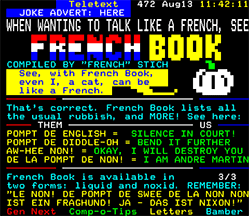
|
Sub-editors were told to go over material with a fine-tooth comb prior to broadcast, and many became paranoid about the content they were reviewing, seeing innuendo and risqué humour where there was none. In some cases, this led to perfectly innocent writing not being run for fear of missing a joke that had gone over the sub-editors' heads. In one case, a sub refused to check a weekend fake advert for something called French Book, which was filled with Digi's absurdly nonsensical take on "French". It was a Friday afternoon, the sub was tired, and she couldn't bear going through the lines of rubbish Digi had written, checking that there weren't any big rudies encoded within. Of course, there was nothing of the sort - it was all silly rather than sordid - but the sub was convinced otherwise, and pleaded with the Digi writers not to run it that weekend, and put it back to the following week when it would be another sub's responsibility to examine instead.
Ironically, despite this paranoid vigilance, the subs never realised how much unadulterated filth was going out disguised in the moans of Zombie Dave, who miraculously survived his long run on the news page completely unscathed.
On another occasion, a Man Diary entry that was originally approved by the subs was removed from air part way through the day. In this latest instalment of The Man's long-running adventures, he now worked in an ice cream factory and had found out that the staff produced the ice cream by sitting on a tray of fat and farting on it, then boiling down their trousers and mixing it together. That was how they made the ice cream. Clearly, what was acceptable to one sub wasn't necessarily acceptable to others...
Arguably the most famous example of the subs' interfering came with the punchline to the Man's Daddy joke "What are the main ingredients of shepherd's pie?" - where the original punchline "Sheriff's hair and poo!" was changed to "Lots of sheep in a cirle!" without Mr Biffo's knowledge. He didn't even realise it had happened until he looked at the page when it was broadcast. This gave some added context to his assertion in reply to a letter some time before that viewers would need to read Digi prior to it reaching the hands of the subs, if they wanted to read the funny version of the magazine.
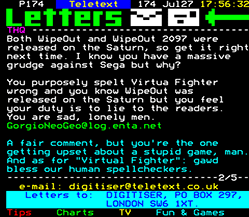
|
It wasn't just that the subs lacked humour, that they were paranoid, or over-cautious. They were all of these things, of course, but there was also a sort of callow guilelessness about them too. Basic knowledge that you might reasonably expect editorial staff on a games magazine to be aware of - that "Virtua" and "Actua" don't have an 'l' in them; MS stands for "Master System", not multiple sclerosis - was simply not part of their proof-reading repertoire. Consequently, a few howlers made it through thanks to their intervention, which never went unmissed by readers, if the Digi letters page was any indication.
And it was largely on the letters page that Digi's epic struggles with their red pen-wielding overlords unfolded - Biffo was never shy of criticising them, or alluding to some witless change that had been imposed at their insistence.
Later, a new and particularly mean-spirited, needlessly nasty sub-editor was introduced - one who, as it happened, held ambitions far higher up the ladder, and was more than happy to make a name for himself by taking an extreme hardline on Digi's perceived unruliness to get him there. Thanks to him, entire paragraphs were deleted from review copy – simply leaving empty, blank space on the page, without even affording Mr Biffo the courtesy of a chance to add revised copy to fill it instead.
He also aggressively challenged the use of the term "the three Rs" - referring to the well-known educational principle - which he mistakenly believed to be a subversive attempt to smuggle the word "arse" onto Teletext's pages; and called the phrase "fingering the index" - innocently meant as a play on index finger, used when looking down an index - "disgusting". Both of these examples were cut from broadcast, and the manner in which it was done served only to strain relations between Biffo and this particular sub-editor further.
Sadly, as is often the case in corporate environments, the troll-sub's ambition and confrontational approach soon propelled him to a position of authority. As Deputy Features Editor, he played a central role in the unjust Digigate saga, and was instrumental in the new policy of removing all humour and personality from Digi's pages.
The Digigate period of 2001/02 did of course mean that there was now nothing controversial for the subs to fret over. That amnesty didn't last forever, thankfully - because in late 2002, Teletext bosses realised that Digi's humour didn't in fact exclude people, as had been claimed as part of the rationale for stripping it of everything that made it great. The loss of around 800,000 readers and an unending torrent of complaints from Digi's army of devotees might have had something to do with this about-face. The upshot was that Biffo now had an official mandate for Digitiser's sub-baiting lunacy for the very first time in its history - and he didn't hold back.
New characters like the Tin Man from Wizard of Oz were introduced, and while many of his outrageous double entendres made it through to air, the subs still couldn't resist tampering with the jokes a couple of times.
They redeemed themselves when it came to Digi's final ever edition in March 2003, though - when faced with the most explicitly obvious phallic reveal-oh ever in the form of The Real Turner The Worm Being Sick, to their credit, they let it past. A discussion was had amongst Teletext's team of sub-editors, and - feeling sentimental on Biffo's last day - they decided to approve it. And not a single viewer complained.
Indeed, there was a very real sense of glasnost between the subs and Digi towards the end of its life. The chief sub-editor at this time was Andy Panos, once a contributor to Planet Sound - who would sign his emails to Mr. Biffo as "A. Penis".
Finally, right at the end, Digi had an ally.
The literal: on the Digitiser team's first trip to a trade show - ECTS in September 1993 - Mr Biffo and Mr Hairs assumed that all attendees would be smartly dressed, and so turned up wearing suits. Of course, the only people at computer trade shows to be suited and booted are the PR people – all of the other journalists looked like teenage grebos who'd been turfed out of their messy beds by their mums. As a result, the Digi duo somehow managed to both stand out and be ignored by almost everyone.
The figurative: Teletext Ltd management are often referred to as 'the suits', thanks to their position in charge of the Digitiser team, and their singular inability to either 'get' Digi itself, or to understand the reasons for its massive popularity. Their hostile attitude towards the section and its writers is a classic example of corporate management not grasping what made a unique, creative force such a hit, and sabotaging their own success with tone-deaf interference into how Digitiser was run.
Maverick-published UK Nintendo magazine that linked up with Digitiser from August 1993. Printed a number of Digitiser comic strips and the famous Lard Challenge, until the title was discontinued with issue 10 in early 1994. Many of the comic strips published in Super Control would later be reproduced within the pages of its Sega stablemate, Mega Drive Advanced Gaming.
The only time that something other than a game appeared in the "in our slot this week" crevice at the weekend, was the 1995 debut album by cheery Oxford Britpop mainstays, Supergrass - 'I Should Coco'.
Mr Biffo has always been a great supporter of Super Page 58, something for which I'm eternally grateful. After it launched in December 1997, this lovely site went onto have plenty of great "exposure" on Digi itself, most surreally for me when the updating of it made it into the news round-up trough. In later years Biffo provided direct help with factoids for the various pages about Digitiser's history, and aided with the promotion of new content and features.
Without this appreciation and support, it's doubtful that Super Page 58 would have been relaunched in 2018, and this very page you're reading now would have remained an embarrassingly-written relic of the '90s. So at least I've been spared that shameful fate. Thank you, Paul!
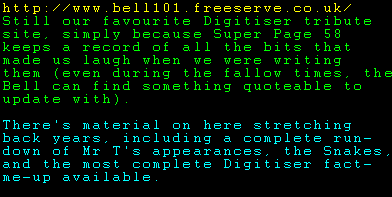
There was a time when the image of the swan was as common on Digi as the irritating "Speed King" premium rate competition line ads were in its later years. The swans were made famous mostly on the letters page as reveal-ohs, and would appear in many an interesting situation, or with some great advice. They were universally loved, and went onto become a Digitiser institution, but alas they barely appeared after 1996. From this time onward, their only appearances were as cruel jokes, with a reader request for a swan on one occasion prompting the reply: "we haven't done a swan in ages. Press reveal to see one now!", only to show a picture of a carrot instead. Apparently the swans had all died - seemingly at the hands of The Snakes. What appearances we do have of them can be found on the Reveal-o-page. Moc-moc-a-moc!

Digitiser had an unfortunate scrape with British tabloid The Sun before it had even been on air for three months. This was brought about by a throw-away line in a review of SNES Street Fighter II - "Now you too can develop epilepsy!" – referring to the tabloid scare stories surrounding video games at that time.
A representative of the British Epilepsy Association was not amused by this flippant remark, and phoned Teletext to complain. The Digitiser team spent quite some time trying to placate him, which they eventually believed to had done; with the man ending the call seemingly happy with how things had been handled.
The writers thought no more of it, until Mr Biffo – while sitting on the toilet – opened a copy of The Sun, only to be struck by the immortal headline: "TELETEXT RAPPED FOR SICK VIDEO GAME JOKE". The BEA rep had finished his call with the Digi team and run straight to The Sun's news desk with the story.
The Sun, owned by Rupert Murdoch's News Corp., was only too eager to throw a little dirt at the newly-launched Teletext Ltd, which was owned by a consortium headed by DMG Media, publishers of The Sun's rival tabloid the Daily Mail.
When Biffo alerted his colleagues to the story, he was simultaneously embarrassed to admit that he'd been reading The Sun, whilst also feeling that doing so while evacuating himself was only fitting really.
Rattled by unexpectedly being put under the spotlight of one of Britain's leading red-tops, Teletext's features editor insisted on going through every inch of copy that was written for Digi, making sure a repeat appearance wasn't incoming…
Teletext is an information broadcast system developed in the UK in the 1970s. It uses the empty space between frames of a TV picture to transmit pages of information, which can be displayed by TV sets with the necessary receiver by pressing a button on the remote control.
Known for its rudimentary, blocky graphics, as much as for the content itself, it could be considered to be a crude precursor to the internet.
The various services broadcast across UK channels were incredibly popular, with millions of viewers tuning in throughout the 1980s, '90s, and early 2000s. Each service was different, provided by various organisations - but all offered a number of standard pages and sections of news, sport, weather, TV listings, and subtitles accompanying the onscreen programme, as well as editorial content.
Digitiser was broadcast on one such service - Teletext, which began on ITV and Channel 4 on 1 January 1993.
The company that ran teletext services on ITV and Channel 4 from 1 January 1993, taking over from the founding Oracle when it was outbid for its franchise.
Teletext Ltd.'s service – simply named 'Teletext' - offered a broad range of features and editorial content, positioning itself as more of an electronic magazine than the dry stuffiness of the BBC's rival Ceefax service. Teletext's content included music pages, a teens section, film reviews, a children's comic strip, and a fondly-remembered multiple-choice quiz called Bamboozle. Digitiser was part of this line-up, and slotted into Teletext's "total entertainment" brand.
As a commercial organisation, on-screen advertising was the main source of income for Teletext Ltd., a major part of which were the cheap holidays that the company became synonymous with. Today this is the last remaining part of its business, existing solely as the parent company of Teletext Holidays.
Frequent Digi letters page correspondent Alex Seymour was renowned for signing his letters off by writing "That is all. I read you every day", which became his catchphrase. This prompted others to write in with variants of it designed to poke fun at him, which of course were hilarity incarnate. No, really.
Curator of the tips and charts pages, starting sometime around late 1996/early 1997. He was originally brought in to help Mr Biffo as he took on the mantle of editing Digitiser full-time following the sacking of Mr Hairs. All that is known about Mr Toast now is that his first name was Sean, and that he pleasingly 'got' Digi's humour. Toast was responsible for writing the puffy-jacketed witticisms of Wired Child, and the despatches from Mr and Mrs Nude's nudist colony. Only lasted around a year before being replaced by Mr Udders.
...And your daddy is in the toast! This deep-couplet has become something of an obscure Digi favourite, and a subtle calling-card for Mr.Biffo, making numerous appearances over the years. From its origins in a 1995 Man Diary entry, to being used in the 'Scranton-K' segment of the Biffovision TV pilot, it later went on to appear in the very first taster of Found Footage, as part of Goujon John's Celebrity Ghostel - and in 2024 it even made it into Biffo's monologue during the 'most haunted museum' Digi YouTube video. May your daddy be in the toast for years to come.
In the bizarre world of Digitiser, trampkind was adored, with the funny little guys themselves being almost revered as demi-gods. On a number of occasions Digi informed us of how a) great, or b) fun tramps were. See this, dolt: "It isn't particularly pretty, but neither are tramps, and you can have all sorts of fun with those guys!", "That's the last time we give a tramp love bites." Why, they seem to like them so much, that they even created the ultimate epitaph to the Strongbow-guzzling smellstons: a character in their honour, in Strangelove The Tramp. You can find out about him: here.
Comic strip about a corrupt prison guard, drawn by Mr Biffo for Teletext's misjudged 'adult' section, After Hours. Unlike Turner The Worm, Biffo didn't write the strip – the unknown writer had tenuous links to Viz, and had talked-up his involvement with the magazine, but when asked they denied all knowledge of him.
Turner The Screw was an original creation, but the character designs had been re-used and adapted from graphics that were at first intended to be licensed Viz characters, such as Sid The Sexist and Roger Melly The Man On The Telly. Teletext believed their new hire from Viz had more influence with the magazine than it actually transpired he had, and so, unsurprisingly, the request to license the characters was refused.
The strip was shown from the launch of Teletext's new service in January 1993, until the regulator singled-out After Hours as being inappropriate as part of a review, and it was abruptly discontinued that March.
Weekly teletext comic strip written and drawn by Paul Rose (Mr Biffo). Its serialised stories starred the titular limb-bearing worm and his friend Glug The Slug, and was a permanent fixture on Teletext's Kids pages. Recovered strips can be found in Alistair Cree's Turner archive.
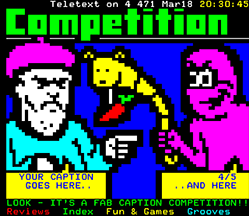
|
Aside from the Biffo connection, Turner The Worm had nothing to do with Digitiser – they were separate sections, aimed at different audiences, although very early on Turner and Digi mascot The Man With A Long Chin encountered each other as part of a caption competition.
Turner may not have been a Digitiser character, but keen viewers would undoubtedly have been able to recognise the Mr Biffo humour within its stories. This connection became especially clear in its parodies of films and TV shows, with plenty of references to EastEnders (see the tale entitled "The Curse Of Frankenpatcabs", which Albert-Square-o-guys will know refers to the cab company run by Pat Butcher, and her husband Frank (Rickeeeeeeeeeeeee!)).
One of the best-loved film parodies was 'The Worminator', in which a homicidal worm cyborg, constructed by Turner's arch nemesis Otto Matik, attempted to eradicate the hermaphroditic one, only for him to be saved by Kylie Leech. At one point The Worminator fires a pasta gun at the heroes before uttering the classic line "Pasta la Vespa, baby". Oh, and later stories saw the introduction of an anthropomorphic fly named Goldblum. You see: clearly the work of Biffo.
 |
But then. Then came Digitiser's final edition – and the image that it will forever be associated with.
Yes, Digi bowed out on Teletext with a picture of a garish spunking cock as a reveal-o-joke – dubbed 'The Real Turner The Worm Being Sick'.
This image has now passed into immortality – and miraculously, didn't receive a single viewer complaint.
When Digi reviewed Batman Returns for the Mega CD, they were so perplexed by the startling differences in quality between the platform-jumpy bits, and the Mode 7-ish driving sections that they decided to treat it as two different games. Thus it effectively got two separate reviews, and separate scores.

Long-serving custodian of the Digitiser tips and chart pages following the departure of Mr Toast. With Mr Biffo now writing Digi from home, Udders – real name Gavin Lambert – was the sole remaining Digi staffer left working at Teletext HQ in Fulham from around late 1997 up until its end in 2003.

|
Udders was responsible for writing and compiling the parts of the magazine that Biffo had long found tedious and didn't want to be involved with, and contributed comments from such characters as Wired Child, The Beatles, Dennis: The Man Of Zinc, Strangelove The Tramp, The Nice Valentine Rusk, and other tips-folk.
He inadvertently played a key role in Digi coming to an end, calling Biffo in late 2002 to voice his suspicions that management were planning to make further swingeing changes to the section following the recently-resolved Digigate saga.
Expecting the worst, and ground down by the previous year's demoralising fight with his bosses, Biffo pre-empted this news by informing Teletext that he was quitting – only to be met with surprise, and the revelation that management had in fact been planning to expand Digitiser, not neuter it again. Realising despite this that it did feel like the right time to bow out, Biffo was true to his word, and Digitiser ended the following March.
Udders was recommended for the job by his friend Mr Cheese, and while Biffo was initially infuriated with Udders' behaviour, he soon came to value him, and the two remain close to this day.
Since leaving Teletext Ltd, Udders – affectionately referred to by Biffo as 'Gavlar' – has retrained and is now a medical doctor.

TV gaming show originally broadcast in 2005 and 2006 on BBC2 Scotland, created and presented by Rab Florence and Ryan Macleod, based on their online show Consolevania. The duo are vocal fans of Digitiser, and in one episode of VideoGaiden placed it in their 'time capsule'.
This was accompanied by a glowing tribute read by Colin Baker in character as his version of Doctor Who, and soundtracked by Marillion in reference to Mr Biffo's love of the band.
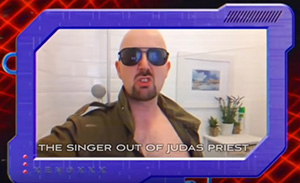
Macleod later appeared in an episode of Mr Biffo's Found Footage as "The Singer Out Of Judas Priest".

The standard reply given to those dull letters from dull people obsessed with telling us about dull hardware specifications, the latest box of wires to "light their load", or Amiga owners "carping" on about how Quake is available for their system.
The closest thing that Digitiser had to a motto or belief system, this summary of their outlook on the games world served them well over the years. Digi were equal-opportunity sceptics when it came to games firms, and despite accusations of bias flying in from literally all sides of the console wars at one time or another, they steadfastly stood by their credo. No favouritism, no sentimentality - Digi called-out the mess-ups wherever they found them, whoever made them, be they by Nintendo, Sega, Sony, Microsoft, or Atari. Come to think of it, especially by Atari. Perhaps they were more equal than others.
When Digi used to receive praise from a reader, they were never exactly what you would call modest. "We're so great" was often the lone reply to such letters, such as when people wrote in agreeing with Digi's hype-ignoring review of Nintendo's epic "girls are rubbish" RPG, Zelda 64. They have also been known to utter "We love you too, love", and similar variants. But mostly it was the self-love. What?
Back when Digi started out, they would award the occasional prize to letters that they felt were deserving of the honour.
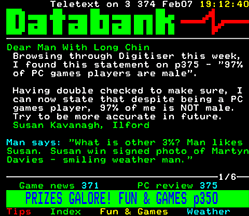
|
This prize was the prize of the signed photographs of ITV weathermen prize.
How Digi managed to get such a large supply of said images is unclear, but according to Biffo they somehow found stacks of them in a cupboard and decided to make use of them.
The photos included all the greats of ITV weather forecasting, including That Welsh One, The Guy With The Gelled-Up Hair, and The Other Ones. Readers were even able to request a specific meteorologist if they were available.
Before joining Teletext Ltd, Mr Biffo worked at Wembley Stadium, the UK's national football and rugby league venue, where he created graphics and goal animations for the stadium's electronic scoreboard. As this was a blocky pixel-based display he was very much in his element – although each pixel was in fact a whole lightbulb, and dead pixels would require walking along a precarious gantry to replace the bulb itself.
Some would see being paid to attend flagpole sporting events as a dream job, but the famously football-sceptic Mr Biffo didn't quite see it that way. Far better for him was the Freddie Mercury Tribute Concert in 1992, where he somehow found himself the only person in the audience when David Bowie soundchecked to an empty stadium the afternoon before the concert.
Wembley was a good gig for Biffo (aside from the time when he angered Bryan Adams by inadvertently ending his concert by bringing the house lights up before the encore). So much so that when the yet-to-launch Teletext Ltd's first editorial director, John Holme, called him about a graphics job following a tip from a friend-of-a-friend, Biffo inadvertently drove such a hard bargain to take their offer that he became the only member of Teletext staff with a permanent contract. Not even Holme or deputy editor Graham Lovelace had permanent deals.
Biffo is still shocked by the balls of his younger self. Given the trouble that would later come Digi's way from within Teletext, it's probably just as well that his testes were so sturdy.

The damning phrase with which Digitiser scandalised 3DO owners when they reviewed the super-hyped "racer" Need For Speed. Now, you may think that there can't have been very many die-hard 3DO fans - and you would be right! But what few there were all started writing to Digi, and they. Were. Furious. With one simple comment, Digi had burst the proud balloons of this more-money-than-sense group of "multiplayer" owners, and insulted what they believed to be the system's killer app, a game that would catapult it into the big leagues. Which, of course, it did not. And why? Because you just drive about, man.
The latest incarnation of Digitiser is its wildly funny YouTube channel, a taste of which is below in its channel trailer video. Home to weekly videos featuring Mr Biffo and current comic foil Paul Gannon basically just arsing about for the hell of it, it's also the place where Digitiser The Show and Mr Biffo's Found Footage emerged into the world screaming and covered in amniotic fluid. Which, if you've seen the latter, is not much of an exaggeration.
The greatest of thanks to all those who have enabled this guide to be created by contributing information over the years - not least Mr Biffo, whose memoirs published on Digitiser2000 were an invaluable resource. All images are added in good faith and credited where possible, but if you spot something of yours which hasn't been, then mail me (superpage58@gmail.com) and I'll be happy to put right what once went wrong, man.



